Architectural Setting in Cinema


- How the Setting Becomes a Character and its Influence on Cinematic Adaptations from Plays in the Case of William Shakespeare Uzair Jariwala IU1743000009 Guide: Shabbir Unwala July 2022
Rancharda, Thaltej, Ahmedabad, Gujarat - 382115
Approval of Successful Completion of B. Arch Thesis
Presented to the Indus Institute of Design, Environment and Architecture Indus University, Ahmedabad

In partial fulfilment of the requirement for the degree of Bachelors of Architecture.
The following Bachelor of Architecture Thesis is hereby approved as credible work on the approved subject carried out and presented in a manner sufficiently satisfactorily to warrant its acceptance as a prerequisite to the Bachelor in Architecture for which it has been submitted. It is also to be understood that by this approval, the undersigned does not necessarily endorse and approve any statement made, opinion expressed or conclusion drawn there in, but approves the study only for the purpose for which it has been submitted and satisfies him to the requirement laid down by the thesis committee in July 2022.
Thesis title: Architectural Setting in Cinema - How the Setting Becomes a Character and its Influence on Cinematic Adaptations from Plays in the Case of William Shakespeare
Name and Signature of Student: Name and Signature of HOD:
Uzair Jariwala Dr. Naresh Chhatwani
Name and Signature of Thesis Guide:
Shabbir Unwala
Rancharda, Thaltej, Ahmedabad, Gujarat - 382115
Plagiarism Declaration
Name of the Student: Uzair Jariwala | IU1643000009
Title of the Thesis: Architectural Setting in Cinema - How the Setting Becomes a Character and its Influence on Cinematic Adaptations from Plays in the Case of William Shakespeare
Guided by: Prof. Shabbir Unwala
Head of the Department: Dr. Naresh Chhatwani Department: Indus Architecture School, IIDEA, Indus University, Ahmedabad

I affirm that I am aware of the Anti-Plagiarism Policy at the Indus Institute of Design Environment and Architecture (IIDEA), Indus University. Plagiarism is using another person’s thoughts, words, results, judgements, ideas, images, drawings etc. and presenting them as your own. I declare that the conceptualisation, conduct of data collection, and ultimately the writing of the thesis report is my original work, except where duly acknowledged and referenced. I have identified and included the source of all the facts, opinions, and viewpoints of others in the report. I have cited the source of all quotations, paraphrases, summaries of information, tables, diagrams, photographs, drawings, electronic media and other materials in which intellectual property rights may reside. I am solely responsible for checking my work for plagiarism, and not my thesis guides or the thesis coordinator. I also declare that this report, or any part of it, has not been previously submitted by me or any other person for assessment in this institute or any other institute.
I understand that failure to comply with the institutes’ regulations governing the plagiarism constitutes a serious offence for which the institution may impose severe penalties. A substantiated charge of plagiarism will result in a penalty being ordered, ranging from a mark of zero for the assessed work to expulsion from the institute.
Uzair Jariwala 05-07-2022 Ahmedabad
Name and signature of student
Cinema’
setting
of
Cinema
‘Architectural setting’
a Character in Cinema’
the architectural setting in cinematic
of Shakespeare’s plays
Contents Acknowledgment Abstract Chapter -1 Introduction Chapter -2 Architectural Setting & Characters Chapter -3 Case Study Conclusion Image credits | Bibliography — Preface — 2.1 Architectural setting in Theatre and Cinema — 3.1 Introduction: — 3.11 Macbeth — 3.12 Hamlet — Aim | Objective | Research Questions | Scope | Limitations | Methodology — 2.2 Characters (‘living\animate’) in Cinema — 2.21 Introduction to ‘Characters (‘living\animate’) in Cinema’ — 2.31 Introduction — 2.22 Elements of ‘Characters (‘living\animate’) in
— Character in ‘Architecture’ and
— 2.32 Elements
‘Architectural setting as
— 2.3 Architectural
as a Character in
Comparing
adaptations
Acknowledgment
I would like to take this opportunity to express my sincere gratitude to everyone who directly or indirectly helped me with this thesis. I would like to start by thanking my guide, Ar. Shabbir Unwala, without whom this thesis would not have been possible. I am utterly grateful to him for accepting the proposal to be my guide for this thesis. Throughout the semester, he graciously took time out from his busy schedule so that I get enough discussions to smoothly conduct my study. During the discussions, he diligently listened to what I had to say about my observations and findings. Based on that, he would then give me valuable insights and clear directions which made the learning process enjoyable.
I am thankful to all the professors at IIDEA, Indus University, and the reviewers for their insights which helped me attain a better understanding of the topic through their varied and insightful opinions especially, Prof. Atreya Bhattacharyya. The initial discussions as well as his inputs on the progress helped me improve my research. His discussions in the previous semesters where he used film references to explain architecture made me develop an interest in this topic.
I would also like to thank my friends and batchmates especially, Utsav Rathod, Malav Pandya, and Deep Godhania, for their motivation, suggestions, and troubleshooting whenever it was needed (even at odd hours post-midnight). My friend and fellow intern, Atri Karmakar for helping me out with suggestions related to graphics and presentation. A special mention to my uncle, Nehaal Kinariwala for always believing in me and guiding me right from the beginning. And last but not the least, I would like to thank my parents, sister, and grandparents for being understanding and patient with me through these years and for supporting my pursuits.
i
Architecture and Cinema are often linked with each other because both of them deal with human emotions and experiences. In cinema, these people are called ‘characters’, and the story that is being narrated is about these ‘characters’ and the ‘incidents’ that take place in their lives. The architecture or the built environment plays a role in being a background for these incidents and in many cases it also takes an active part in it. Architecture in cinema is called an architectural setting. The attempt through this thesis is to prove how the architectural setting is not a mere background but is as important as these characters in cinema.
The method followed to prove this hypothesis begins with the understanding of the term ‘character’ in terms of the ‘characters in films’(‘living\animate’) and also what adds ‘character’ to architecture as well as the architectural setting. The inferences of these studies help in deducing the elements that give character to the architectural setting in cinema.
These elements are then put to test through case studies. The selected cases are the cinematic adaptations of the plays written by William Shakespeare. The inherent performative quality of a play provides for well-fleshed-out characters and the ambiguity regarding the kind of architectural setting provides an opportunity to explore different kinds of settings as well as contexts. The observations made through the case studies help in proving that the architectural setting in cinema is a character in itself.
ii Abstract
Preface
Architecture as an art form is actively linked with other forms of art, the common or the most apparent ones are, painting, drawing, and sculpting. But in addition to these, it also has its links, even if not so direct, with art forms like music, photography, poetry and film making. “Cinema is however even closer to architecture than music, not solely because of its temporal and spatial nature but because both architecture and cinema articulate lived space” 1
Architecture and films both have similar aspects like time, space, context, and illusion. There is a certain amount of time it takes for a person to see and experience the building/space, and the experience of the person may vary depending upon the time at which the space is being experienced. The physical, as well as the socio-cultural context, plays a major part in the design and the final experience of the user in the building. And there are times when the buildings are designed to stimulate an experience for the user using illusions. Similarly, films have a certain duration, during which the director tries to hold the attention of the audience to the story he or she is trying to narrate. In order to do that effectively, the director creates an architectural setting that uses all the above aspects and creates a world/context which may be based closer to reality or could be something fantastical and imaginary, depending upon the story being narrated.
It must be noted that the architecture of cinema is liberated from constraints of practical functions, building technologies that give it an advantage over the other. But somewhere while trying to accommodate these necessities, the buildings have lost the sense of designing a ‘Lived space’. “A lived space is always a combination of the external space and the inner mental space” 2 Pallasmaa further explains, “In architecture, a mental image is transferred from the experiential realm of the architect to the mental world of the observer and the material building is a mere mediating object.” 3 So in films, the aspect of the inner mental place is thoroughly worked upon because the characters along with the context that suits the story and what it is trying to say are well fleshed out. Through my thesis, I wish to bring out the importance of the architectural setting in different films wherein it is used to narrate the story cohesively.
1 Pallasmaa Juhani, ‘The Architecture of Image - existential space in cinema’ Rakennustieto Publish ing,Helsinki, 2nd edition, 2007) Pg. 13
2 Pallasmaa Juhani, ‘The Architecture of Image - existential space in cinema’ Rakennustieto Publish ing,Helsinki, 2nd edition, 2007) Pg. 18
3 Pallasmaa Juhani, ‘The Architecture of Image - existential space in cinema’ Rakennustieto Publish ing,Helsinki, 2nd edition, 2007) Pg. 18
1 Chapter -1 Introduction
Aim
The aim is to study how the architectural setting becomes a character (‘living\animate’) and influences the film when a similar story is adapted in different contexts.
Research Questions
Primary
• What is an ‘architectural setting’ and what is a ‘character’?
• Exploring how the change in the context of architectural setting affects the storyline and its effects on characters(‘living\animate’) in films?
• How does one define the character of the architectural setting?
Secondary
• How does the setting itself become a character like the ‘living and animate’ which are portrayed by actors?
• How does the development in character (‘living\animate’) influence the architectural setting?
Objective
• To study and establish what is a character and what is an architectural setting.
• To study the physicality and psyche of the characters (‘living\animate’) and how that affects the architectural setting.
• To study the architectural setting in relation to the context the story is set in.
• To identify and analyze how architectural setting can be used to create visual metaphors.
• To study the development of characters (‘living\animate’) through analysis of the architectural setting.
• To state and establish how the architectural setting becomes a character through analysis.
Scope
• It will help in establishing the relationship as well as the importance of the surrounding built environment with regards to the story and the characters being portrayed in films.
• The study will enable us to look at the architectural setting as a character, and not merely a background that exists without having to add anything to the story and the way it is being narrated.
• The study will show how the same story can be narrated differently and also with more layers with the help of architectural settings in films as compared to theatre.
• It will help in understanding how different architectural settings/built environments and contexts can add different layers/flavors to a similar story being narrated in cinema.
2
• The research will not focus on how the architectural setting was designed and made in terms of the technical details of film-making like various post-production techniques used to enhance the footage because the study is just with regards to the end product.
• The study is limited to the number of films and plays chosen in the thesis, and the interpretations and findings may vary in other films.
• Since the ‘experience’ of architecture is a subjective matter the analysis will be limited by the readings that are referred to in the process.
Limitations Methodology
Characters in Cinema Elements of Characters in Cinema
Literature Review
Architectural Setting
Character in Architecture Elements of Characters in Architecture
Architectural Setting as a character and its elements
Case study Conclusion
The study begins with an understanding of the terms, ‘Characters in cinema’, ‘Architectural Setting’, and ‘Character in Architecture’ with the help of literature reviews. After defining these terms, the elements that define them are stated and explained. The commonalities and differences between these elements help in developing what is an ‘Architectural setting as a character and its elements’. These deduced elements are further put to test in the case studies. The case studies are conducted through a narrative-based analysis that helps in identifying the above elements and their influence on those films which leads to the conclusion.
3
4
Chapter -2 Architectural Setting & Characters
Architectural setting in Theatre and Cinema
Characters (‘living\animate’) in Cinema
I ntroduction to ‘Characters (‘living\animate’) in Cinema’
2.22 Elements of ‘Characters (‘living\animate’) in Cinema’
Architectural setting as a Character in Cinema
Introduction
Character in ‘Architecture’ and ‘Architectural setting’
Elements of ‘Architectural setting as a Character in Cinema’
5
— 2.1
— 2.2
— 2.21
— 2.31
—
—
— 2.32
— 2.3
6
2.1 Architectural setting in Theatre and Cinema


Throughout history, mankind has been narrating stories- they may be fact or fiction, their purpose could be to educate, to entertain for monetary gains, or even both. Theatre is one of the oldest forms of performing arts and storytelling, gaining popularity in the 6th century B.C in Greece. “Theatre (the art form) is a deliberate performance created by live actors intended for a live audience, typically making use of scripted language”4 . The word theatre comes from the Greek term ‘theatron’ which means a place for seeing or showing. The word ‘Theatre’ –in terms of the buildingis a place where people go to watch these plays or performances.

Since it is performed live, the set can’t exceed a certain scale because it is defined by the size of the stage where it is being performed apart from other logistics. And so, at times due to this inherent limitation of the medium, it becomes difficult to establish the physical context, which can also be expressed by saying, ‘the sense of place’ in which the story is set. This ‘sense of place informs the viewer and lends an aspect of relatability to the story and its characters, which is achieved by giving it an appropriate architectural setting.
4 Crashcourse, What Is Theater? Crash Course Theater #1. YouTube, YouTube, 9 Feb. 2018, https://www. youtube.com/watch?v=sNWrOuwzax8&list=PL8d PuuaLjXtONXALkeh5uisZqrAcPKCee&index=2.
7
Accessed 2 Feb. 2022.
(Fig. 2) Image from the set of the film ‘Rear Window’ (1954) Directed by Alfred Hitchcock
(Fig. 1) Theatre Of Dionysus, Athens, Greece
(Fig. 3) Sketch for the rotating set for the anti-gravity scene by Guy Hendrix Dyas (production designer) for ‘Inception’ (2010)
With the advent of cameras came Cinema/ motion pictures or films, one of the newer mediums of storytelling. The word ‘cinema’ is short for ‘cinematography’ which is the art of capturing motion picture photography.
The Greek work ‘kínema’, from which the word ‘cinema’ is coined, means ‘movement’. In simpler terms, it is the art of filming or recording a moving image 5. With the help of cameras, a series of scenes that may or may not be scripted (documentaries) can be recorded and then stitched together. And what earlier used to be done using ‘film’ strips, is now through digital cameras and editing software, to make the desired motion picture. Cinema gives its director the freedom to capture and display the exact vision that they have which does justice to the story he or she is trying to narrate.
In theatre, one has to write in such a way that a lot of contexts have to be directly narrated, which does inform the audience but is difficult for them to completely feel it. In cinema, a lot of emphases is given to showing rather than telling because the medium allows doing that. The command of the director on visual grammar and semiotics is on display, and to achieve that, the director uses the architectural setting to their advantage thereby enhancing the overall experience of viewers.
5 “Cinema (n.).” Etymology, 2017, https://www. etymonline.com/word/cinema.
(Fig. 4) Nat Karson’s ground floor plan (below) and elevation (above) for the ‘Voodoo’ Macbeth.

8
(Fig. 5) This still is from the play ‘Voodoo’ Macbeth (1936) directed by Orson Welles for the ‘Negro Theatre Unit’ and the play was based in an imaginary island in the Caribbean instead of Scotland. Welles later directed a feature film ‘Macbeth’ (1948) and created a similar set in that film as well (although much larger in scale) but that story was based in Scotland abiding to Shakespeare’s original text

(Fig. 6) This still is from the play ‘Hamlet’ (1936) directed by and starring Richard Burton. The specialty of this production was that it had a bare set with only a few props and a raised platform on the stage. Even the actor’s costumes did not represent the time as they wore contemporary clothes with nothing peculiar apart from Richard Burton, who was playing Hamlet, wore black which was the colour Hamlet wore in most plays to show that he is mourning.
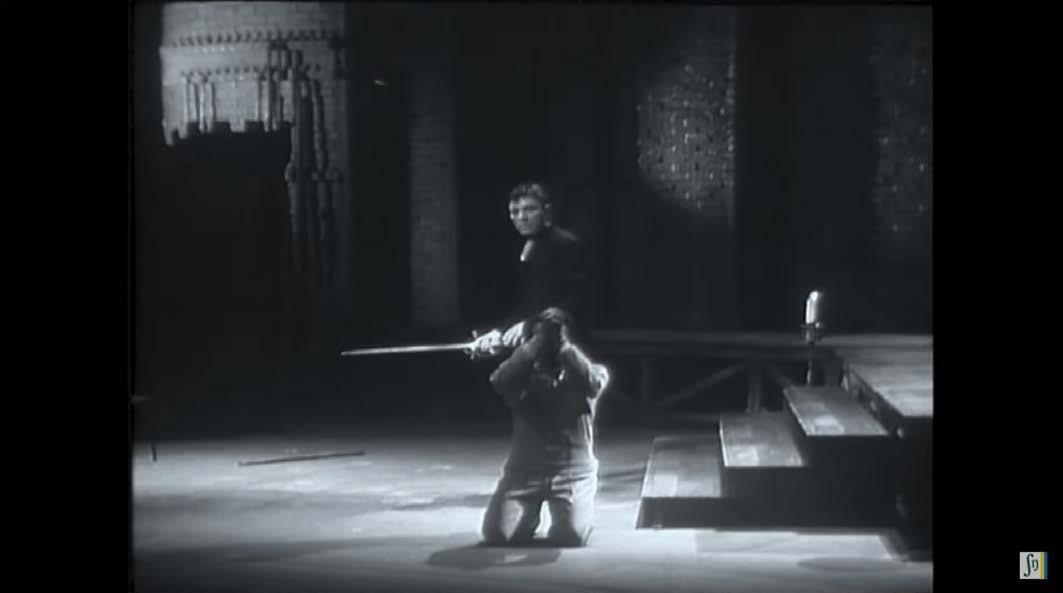
9
2.21 Introduction to ‘Characters (‘living\animate’) in Cinema’
To understand the architectural setting as a character in a systematic and structured manner, it is important to first understand what a character is - in performing arts and films in particular. Since writing a script, also like designing, is a creative process, so it is also a non-linear and a subjective one. Although there is no set method or guideline to write a character, there have been attempts made by film theorists, critics, and authors to define a methodology for this process that tries to summarize and encapsulate the essentials of writing a character.
William James, the famous psychologist, studied the dynamics of the human mind. Henry James wrote several essays trying to document and define the intricacies of creating character. In one of those essays, The Art of Fiction, James poses a literary question: “What is character but the determination of incident? And what is incident if not the illumination of character?” 6. By saying, this what William James meant was that the character is the one that responds to or is the reason for the incident. How it reacts to the incident forms the character.
Screenplays are usually about a key incident, and the story is the character acting and reacting to it 7. Events or incidents are written in the screenplay and the character’s reaction to this helps the audience relate to and feel for the characters, by the end of which the audience either relates to the character and empathizes or despises it. In ‘The Art of Fiction’, Henry James says that the incidents you create for your characters are the best ways to illuminate who they are—that is, reveal their true nature, their essential character. How they respond, to a particular incident or event, how they act and react, what they say and do is what really defines the essence of their character 8
6 Field Syd, ‘Screen Play: The Foundations of Screenwriting’,Originally published on July 1984, Revised edition December 2005, Pg. 43
7 Field Syd, ‘Screen Play: The Foundations of Screenwriting’,Originally published on July 1984, Revised edition December 2005, Pg. 44 8 Field Syd, ‘Screen Play: The Foundations of Screenwriting’,Originally published on July 1984, Revised edition December 2005, Pg. 44
10 Characters (‘living\animate’) in Cinema— 2.2 —
Elements of ‘Characters (‘living\animate’) in Cinema’
The elements that make for a good character and its interpretation for architectural setting are:
Back story / Background: A fully developed back-story is an important part of creating interesting characters. Regardless of how much of the character’s past you intend to reveal to your audience, writing a detailed and extensive biography in the character development process can help you create characters that seem authentic and detailed. There are two parts to a character’s biography :
Exterior & Interior
Theses can be further described by the following parameters:
1) Exterior:
Physical life(what the character does and how it behaves) which reveals the character 9;
Description of Physicality:
The way a character looks will also define how other characters respond to each other and vis-a-vis. It might also determine the choices the character will make, thus making a significant impact on the overall character arc.
Attitude:
What a character chooses to do in order to reflect upon life experiences and other external factors. Understanding your character’s attitude allows him/her to reach out and touch his/her humanity in an individual way 10 .
9 Field Syd, ‘Screen Play: The Foundations of Screenwriting’,Originally published on July 1984, Revised edition December 2005, Pg. 48
10 Field Syd, ‘Screen Play: The Foundations of Screenwriting’,Originally published on July 1984, Revised edition December 2005, Pg. 67
11 — 2.22
Change:
Change, transformation, is a constant of life, and if you can impel some kind of emotional change within your character, it creates an arc of behaviour and adds another dimension to who he/she is 11 .
2) Interior:
The emotional life of the character;
Motive/ Dramatic need :
Dramatic need is defined as what your main characters want to win, gain, get, or achieve during the course of your screenplay. The dramatic need is what drives your characters through the storyline 12 .
Point of view (perception):
Point of view is defined as the way a person sees, or views, the world. Every person has an individual point of view. It is our mind, how we see the world, that determines our experience 13 .
11 Field Syd, ‘Screen Play: The Foundations of Screenwriting’,Originally published on July 1984, Revised edition December 2005, Pg. 68
12 Field Syd, ‘Screen Play: The Foundations of Screenwriting’,Originally published on July 1984, Revised edition December 2005, Pg. 63
13 Field Syd, ‘Screen Play: The Foundations of Screenwriting’,Originally published on July 1984, Revised edition December 2005, Pg. 65
12
2.3 Architectural setting as a Character in Cinema
Introduction
— Character in ‘Architecture’ and ‘Architectural setting’
In Italo Calvino’s book ‘Invisible Cities’ Marco Polo, a traveler describes the cities and places that he had visited in his life. Cities have been described and categorized in such a way that he does not really talk about the actual things and people, but instead, he explains what those places made him feel. So, in the chapter- ‘Cities and Memory 1’, while describing the city of Diomira he says, “But the special quality of this city for the man who arrives there on a September evening, when the days are growing shorter and the multi-coloured lamps are lighted all at once at the doors of the food stalls and from a terrace a woman’s voice cries ooh!, is that he feels envy toward those who now believe they have once before lived an evening identical to this and who think they were happy that time.” 14
Thus, the city has a quality that creates an experience that would stay etched in a person’s memory forever. And these feelings and emotions that the cities reflected defined their character. Similarly, when one talks about architecture and the space that is created, they describe the atmosphere and their experience while looking at it and being in it. The atmosphere appeals to the senses which creates an experience. While describing quality in architecture, Peter Zumthor describes it as a ‘place that moves him’. 15
The architectural setting in films is instrumental for its storytelling. The built environment in which the story unfolds isn’t just incidental but is a very deliberate choice made by the director, along with the help of the production designers, which helps in creating the appropriate atmosphere for the emotion the characters go through and what the audience is
14 Calvino, Italo, and William Weaver. “Cities and Memory 1.” Invisible Cities, Vintage Digital, London, 2010, p. 7. 15 Zumthor, Peter. “Atmospheres.” Peter Zumthor: Atmospheres: Architectural Environments, Surrounding Objects, Birkhäuser, Basel, 2006, p.
13
— 2.31
10.
supposed to feel during a scene. It is a tool through which the director can inform the audience about the place, the time, and the ‘world’ the story is set in without even having to prompt it to the audience.
Along with the story, the setting is also instrumental in providing the audience the necessary information regarding ‘who the character is’, this information may or may not be of prime importance to the story directly but when an audience looks at it from the perspective of the character for the decision it makes or what he or she is thinking, it all eventually adds up giving the story a meaning much more than the sum of its parts .
(Fig. 7) This still is from the film Citizen Kane (1941) Directed by Orson Welles.
Before this scene, Charles Foster Kane (in frame) has had a melt down in front of his wife at the end of which he is completely shattered to the point where he starts ‘reflecting’ back upon his choices and behavior. While he walks down the corridor, there comes a point wherein there are two mirrors in front of each other, and with him standing there it casts multiple reflections of him in it. The emotional state of the protagonist is conveyed by the director without anyone having to say a word.

14
of ‘Architectural setting as a Character in Cinema’
Several people have tried to categorize aspects/elements that help in creating an atmosphere and give the desired character to the architecture, but experience, being a subjective matter, the elements/categories keep on changing.
Based on the readings 16,17, some of the common elements are as follows:
• Scale, Proportion and Proximity
Material
Sound
Light
Objects and Signs
Movement and Rhythm
Relationship of Interior and Exterior
The above elements do not just talk about the physical elements of architecture but are qualitative aspects and a little abstract in nature. As the primary purpose of ‘architectural setting’ is to show the context and communicate with the audience helping them understand the story better, these elements would be able to fulfill the qualitative and experiential aspects required in cinema. But to categorize these points as elements of ‘Architectural setting as a Character in Cinema’ it is necessary to link these with the ‘Elements of Characters (‘living\animate’) in Cinema’.
Similar to the above elements, the ‘Elements of Characters (‘living\animate’) in Cinema’ are also qualitative in nature. In an attempt to look at those aspects in terms of ‘Architectural setting’ they can be further categorized in to two elements which would be further used to explain the above elements:
1) Context
2) Metaphor and Subtext
16 Rasmussen, Steen Eiler, and Eve M. Wendt. Experiencing Architecture. Paper back edition ed., M.I.T. Press, Massachusetts Institute of Technology, 1962.
17 Zumthor, Peter. Peter Zumthor: Atmospheres: Architectural Environments, Surrounding Objects. Birkhäuser, 2006.
15 — 2.32 Elements
•
•
•
•
•
•
Characters (‘living\ animate’) in cinema
Architectural setting in cinema
Exterior
Context
Interior Metaphor and Subtext WhyWhere/When
HowWhat
(Fig. 8) Relationship between ‘Architectural setting in cinema’ and ‘Characters (‘living\animate’) in cinema’
1) Context
Similar to how the ‘exterior’ in, ‘the ‘Elements of Characters in Cinema’ talks about the physical and tangible life of a ‘living\animate’ character, ‘Context’ defines the architectural setting’s physical and visual characteristics. The setting, even if it is in the background, helps in revealing elements like their past and the change that they go through; for the architectural setting as well as the ‘living\animate’ character.
This is achieved while also being in sync with the theme of the story being told. It lets the viewer step into the world slowly using subtle nuances which give information about the ‘living\ animate’ characters. It will answer questions like- ‘Where is it?’ ‘What is its function of it?’ It acts upon the thought and the effect the aspect of ‘interior’ has upon the ‘living\animate’ characters.
2) Metaphor and Subtext
An architectural setting cannot speak per se, but it can still communicate a range of things using its design as a metaphor and a subtext. This means that although the thought\feeling may not be expressed directly by a character (‘living\animate’), it can still be expressed using visuals of architectural setting that may seem one thing if looked just at its face value. But when one begins to think about it and relate it with other emotions and characters even proverbs; it begins to reveal its
16
subtext, often done through metaphors. As it is used to express the story’s themes and emotions which are intangible factors it falls in the category of the element ‘interior’ ‘Elements of Characters in Cinema’. It also answers questions like, ‘Why is the form in such a way?’ ‘And how does one feel in a space?’ etc. By doing so, it can talk about the perception and also the change in attitude and the emotional state of the character.
Thus when the previously mentioned ‘Elements of character in architecture’ when combined and looked at through the lens of the above-mentioned ‘Context’ and ‘Metaphor and Subtext’ gives us a way to identify the ‘ Elements of Architectural setting as a character in cinema’. These elements can be defined and explained in the following way using examples where those elements are in use:
17
• Scale, Proportion and Proximity (Fig.9, 10)
The scale and proportion don’t just comply with the functional requirements, but they also help in creating an atmosphere for the activity to take place. “It refers to the various aspects - size, dimension, scale, the building’s mass, by contrast, with my own. The fact that it is bigger than me, far bigger than me. Or that things in the building are smaller than me” 18 .
So the feeling associated with the space is defined with reference to the scale of the person inhabiting it. This also holds true for the placement of buildings at an urban scale, where the scale of the building is in response to its context; for example, if the setting is located in a dense urban fabric in terms of the number and scale of the buildings. Or it could be located at a remote location in the middle of nowhere depending upon the story and the characters(‘living\animate’).
The influence of this element is not just limited to large spaces and masses but also openings, furniture, and other objects that are part of the setting. The scale and proportion of these objects with reference to the location they are placed in help in adding character to the setting. The perception of the forms is also dictated by the way it has been articulated. The architecture is expressed in forms that swell, press, and push 19 out so that the viewer can experience the space in a better manner depending on the density of the urban fabric the setting is located in. “We do not perceive 18 Zumthor, Peter. “Levls of Intimacy” Peter Zumthor: Atmospheres: Architectural Environments, Surrounding Objects, Birkhäuser, Basel, 2006, p. 51. 19 Rasmussen, Steen Eiler, and Eve M. Wendt. “Contrasting effects of Solids and Voids”. Paper back edition ed., M.I.T. Press, Massachusetts Institute of Technology, 1962. p. 71.
(Fig. 9) This is a still from the film ‘Edward Scissorhands’ (1990) directed by Tim Burton.
Context
The film is set in a fictitious town where an old scientist invents a humanoid named Edward. His house, a Gothic mansion located on top of a hill and is aloof from the rest of the town. The other houses are similar in scale and form which is completely opposite to that of Edwards.

Metaphor and Subtext
The fable like setting highlights the monotonous and rigid nature of the town, which shows why they are unable to accept Edward being different from them in looks as well as nature. The haunting nature of Edward’s mansion is in contrast with his soft and kind nature.
(Fig. 10) This is a still from the film ‘Citizen Kane’ (1941) directed by Orson Welles.
Context
This scene is set in the titular character, Charles Foster Kane’s majestic mansion named ‘Xanadu’. The huge volume of the living room and detailed articulations suggest the amount of wealth Charles possesses.

Metaphor and Subtext
The emptiness of the large room is a metaphor for the void that Charles has in his heart. The lack of furniture itself suggests that there must be very few people who would visit him which explains his longing for love, affection, and care. His refusal to go out and meet people suggested through the location of the huge windows which are just above his line of sight only meant to bring light in.
18
everything as either mass or void. Very distant objects often seem flat” 20. Thus in these cases, the colour, as well as the way the building has been finished, becomes very instrumental. Along with this the amount of articulation and its thickness, the textures of the finish can create determine the perception of ‘weight’ in the setting.
And since in the case of architectural setting the audience sees only what is shown to them, the way it is to be shown would define the audience’s perception of it. The form, scale, and proximity of these spaces and objects dictate the feelings of the character (‘living\ animate’), as well as the audience watching the scene.
Context
• Material (Fig.11,12 and 13)
The choice of material and the way it is articulated also help in defining the context in which the architectural setting is set in. Different places and cultures use materials in different ways based on their availability and in the case of architectural settings in cinema, it is also dependent upon the characters (‘living\animate’) that would be inhabiting the space. Every material has multiple ways in which it can be given shape. If one takes for example a stone; one can saw it, grind it, split it, polish it; and every time it will give a different effect and character to the place it would be used for.
The way a space is finally perceived has a lot to do with how two materials come together, what is their form, and in what quantities it
20 Rasmussen, Steen Eiler, and Eve M. Wendt. “Architecture Experienced as Colour Plains”. Paper back edition ed., M.I.T. Press, Massachusetts Institute of Technology, 1962. p. 83.
The scene shows Bruce Wayne A.K.A Batman’s house (a rendition of ‘Farnsworth House’ ) on the edge of a lake. The house located far away from the city which is because of his introverted nature and the fact that he has to hide his true identity from people.


Metaphor and Subtext
The fact that Bruce is a reserved and cold personality is reflected in the choice of materials as well as its articulation.
(Fig. 13) This is a still from the film ‘No time to die’ (2021) directed by Cary Fukinaga.
Context
In this scene the protagonist, James Bond has been held captive at Safin’s (antagonist)missile headquarters that is located in the Sea of Japan. Because of the building’s location and function the choice of concrete as a material makes sense.

Metaphor and Subtext
The brutalist and rugged nature of the concrete structure metaphorically complements his stoic and intimidating nature.
19
(Fig. 11, 12) These are stills from the film ‘Justice League-the Snyder cut’ (2021) directed by Zack Snyder.
is used 21. All these come together and help in determining the character of the place. Every space also has a ‘temperature’ of its own. The feeling of ‘temperature’ for a space is associated with the materials being used and the feeling one gets when one sees and touches it. For example, steel is a cold material thus the spaces that use it in larger quantities will usually feel cold 22. Whereas wood is a much more pleasant material because it usually never has a temperature shock in store for the user 23
Thus the choice of material used to make the architectural setting is not just because of an aesthetic or ornamental purpose. Every material has a certain quality and emotion associated with it. By choosing one for the setting the director also chooses to take the perception of this emotion, and the characters or the scenes that inhabit this setting also get associated with it. • Sound (Fig.14,15 and 16)
There are certain distinct sounds that we associate a place and space with. It happens through either regularly being there and the sound emitted in that space is registered in our mind subconsciously. And whenever one hears that, it reminds them of that space. For example, in a kitchen, it could be the sound of pots and pans touching each other as well as
21 Zumthor, Peter. “Material Compatibility.” Peter Zumthor: Atmospheres: Architectural Environments, Surrounding Objects, Birkhäuser, Basel, 2006, p. 25. 22 Zumthor, Peter. “Temprature of a Space.” Peter Zumthor: Atmospheres: Architectural Environments, Surrounding Objects, Birkhäuser, Basel, 2006, p. 33. 23 Rasmussen, Steen Eiler, and Eve M. Wendt. “Texural Effects Experiencing Architecture”. Paper back edition ed., M.I.T. Press, Massachusetts Institute of Technology, 1962. p. 182.
(Fig. 14) This is a still from the film ‘A Quiet Place’(2018) directed by Tim Burton.
Context
The film is set in a post-apocalyptic world where aliens with a sharp sense of hearing have taken over the world and massacred most of the population. In this scene, the family, who are the main characters, have shifted to a basement and are trying to improve the soundproofing quality of the walls.


Metaphor and Subtext
Throughout the film, the characters (‘living\animate’) are trying to look for a palace where they can freely communicate, the pain of not being able to do so and sound (expression) itself becoming their enemy is the underlying theme of the film.
(Fig. 15, 16) These are stills from the film ‘Pather Panchali’ (1955) directed by Satyajit Ray.
Context
In this scene, Appu’s(protagonist) sister Durga is seen sleeping on the bed while her mother tries to reduce her fever using a soaked cloth on her forehead. That night a thunderous storm begins and their mud house, which is already in a lamentable state, is unable to keep the weather at bay as it begins to disintegrate even more.
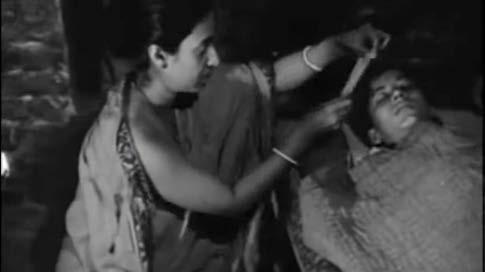
20
the counter-top 24. Or it could be the ‘thudding’ sounds of books on the table, in an otherwise silent library. It could also be the shape of the room, coupled with the material used there, that would make things sound differently.
These sounds affect us in such a way that we begin associating the image we have in mind that is associated with that sound. In cinema, this particular aspect is used especially to define the context of a scene.
But along with this image, we also have the experience and feelings of that place registered in our minds. Zumthor says, “There are certain buildings that have wonderful sounds, telling me that I can feel at home” 25 .
Similarly, there are also certain sounds that can terrify someone, like a creaking of a door, or a whistling sound coming through a small hole. The architectural setting in cinema uses such elements, at times also accentuating and altering these sounds to fit the story. The audience too responds in the way the director wants them to at that point.
• Light (Fig.17, 18, 19 and 20)
The architecture for most places is planned in response to the daylight. The amount of light that is to be taken into the building is depending upon contextual criteria of where the building is situated, the climate, the function, the times at which it is going to be used, and who are the users. “Light is of decisive importance in experiencing architecture. The same room can be made
24 Zumthor, Peter. “The Sound of a Space” Peter Zumthor: Atmospheres: Architectural Environments, Surrounding Objects, Birkhäuser, Basel, 2006, p.29 . 25 Zumthor, Peter. “The Sound of a Space” Peter Zumthor: Atmospheres: Architectural Environments, Sur rounding Objects, Birkhäuser, Basel, 2006, p. 31.
Metaphor and Subtext
As the storm gets more fierce, the objects in the room start trembling and the violent wind begins to shake the locked door, testing its strength. Durga’s health starts to deteriorate even further and the resisting house begins to symbolize her condition. At the end of this sequence, neither does the house survive nor Durga.
(Fig. 17, 18) These are stills from the film ‘The Godfather’ (1972) directed by Francis Ford Coppola.
Context
The above images are from the opening sequence of the film where the Godfather’s daughter is getting married. And while the function is going on, he has a meeting in his office. The contrast in the light quality gives two distinct characters to these scenes.


Metaphor and Subtext
The happiness in the first image is shown through warm sunlight on the open lawn. Whereas the serious talk related to the business is shot in dark ‘heavy’ interiors. The room is lit from above in order to create shadows on Godfather’s face (under his eyes) and also to make him look more intimidating. Thus accentuating the feelings in both cases.
21
to give a very different spatial impression by the simple expedient of changing the size and location of its openings. Moving the window from the middle of the wall to the corner will utterly transform the character of the room” 26 .
Similarly, the kind of feelings that a character (‘living\animate’) is going through, as well as the change in those feelings, can be expressed by using light differently for each of those feelings. And this can be done by not just changing the quantity but also the quality of light. Steen Eiler Rasmussen also goes up to the extent of saying that, “the quantity of light is not nearly as important as its quality” 27. While talking about the quality of light he further explains that, good quality light is the one that makes one see the depth, the materials used in the space, as well as the objects.
According to Peter Zumthor, there are two ways to plan the way light is used in architecture. One is to imagine the building as a pure mass of shadow and then put the light in to hollow out the shadows with it. The other way is to add it systematically thinking about how each material reflects light and its influence on the other objects and the space 28 . In an architectural setting, lighting, as well as the setting, can be manipulated to get the desired effect and mood for the scene, which is not possible in ‘real life’.
(Fig. 19, 20) These are stills from the film ‘Barfi’(2012) directed by Anurag Basu.
Context
In this scene, the protagonist Barfi and Jhilmil begin to bond with each other. There is one distinct ray of warm light that falls on them. Both use a broken piece of mirror to reflect it on the darker wall.

Metaphor and Subtext
In this film as well, bright warm light is used to symbolize the developing warmth and affection between characters (‘living\animate’). As we can see, the apprehensive Jhilmil is only partly covered in light, whereas Barfi -who eventually becomes her source of love and comfort- is fully lit.

26 Rasmussen, Steen Eiler, and Eve M. Wendt. “Daylight in Architecture”. Paper back edition ed., M.I.T. Press, Massachusetts Institute of Technology, 1962. p. 187. 27 Rasmussen, Steen Eiler, and Eve M. Wendt. “Daylight in Architecture”. Paper back edition ed., M.I.T. Press, Massachusetts Institute of Technology, 1962. p. 189. 28 Zumthor, Peter. “The Light on Things” Peter Zumthor: Atmospheres: Architectural Environments, Sur rounding Objects, Birkhäuser, Basel, 2006, p. 69.
(Fig. 21) This is a still from the film ‘Her’(2013) directed by Spike Jones.
Context
The film is set in the near future where the use of technology like artificial intelligence has significantly increased. The protagonist, Theodor after having separated from his wife, lives alone. The modern, and almost futuristic aesthetics and objects are seen in his apartment, but we always see a lot of empty spaces in there. As if the space were being underutilized.

22
Objects and Signs (Fig. 21, 22)
When a person inhabits a space, several objects also come along with it. The objects may be furniture pieces, electronic appliances, art pieces like paintings and sculptures (even religious deities), books, etc.
These objects are necessary for a person to do their daily activities with ease but also for leisure. Peter Zumthor says that there are times when he wonders if the purpose of architecture is to actually design receptacles for these objects. And imagining these objects help him to imagine the rooms in use 29 .
The choice of these objects and their appearance helps in adding layers to the kind of person the user is. And this is also common with the characters (‘living\ animate’) in cinema. The relationship that the architectural setting has with the object also shows the character’s (‘living\animate’) relationship with the object. There are also times when the form\nature of the object or the pattern that it has keeps on recurring throughout the film, at times metaphorically signifying the theme of the film or the mood of the character(‘living\animate’).
• Movement and Rhythm (Fig. 23, 24)
Architecture, just like cinema, is a temporal art form. There is a particular duration it takes for a person to go from one place to the other. And what the person sees and feels during the time taken to complete this journey determines the experience.
Metaphor and Subtext
The empty shelves and spaces metaphorically signify the void that his wife has left in his life. His need for love and companionship is explored throughout the film using such gestures.
29 Zumthor, Peter. “Surrounding Objects” Peter Zumthor: Atmospheres: Architectural Environments, Sur rounding Objects, Birkhäuser, Basel, 2006, p. 37.
(Fig. 22) This is a still from the film ‘Tamasha’(2015) directed by Imtiaz Ali.
Context
Throughout the film, there are multiple crucial junctions where mirrors are used, and Ved, the protagonist, speaks to himself looking at it.

Metaphor and Subtext
The film is made on the theme of finding one’s true self. Thus the mirror as a motif helps the protagonist come to terms with his own wants and desires instead of what his ‘other personality’ does to please people.
(Fig. 23) This is a still from the film ‘The French Dispatch’(2022) directed by Wes Anderson.
Context
The above setting is of the rear facade of the building where the magazine house ‘The French Dispatch’ is located. In this scene, a waiter is carrying refreshments for the writers through a myriad of stairs, while skillfully balancing the tray in his hand through the journey.

23 •
In the ‘Architectural setting in cinema,’ this path is meant to fulfill the requirement of facilitating the person to go from one point to another but at times the setting is such, that the journey itself becomes a metaphor. Movement is also strongly associated with rhythm. “Architecture itself has no time dimension, no movement, and therefore cannot be rhythmic in the same way as music and dancing are. But to experience architecture demands time” 30 .
Thus it’s the movement and interpretation of the person experiencing the space that determines the rhythm. So in cinema, the direction as well as the pattern in which the other elements in the setting are arranged, creates a rhythmic motion for the character(‘living\animate’), thus contributing to the overall experience.
According to Peter Zumthor there are two ways that movements are designed. The first method directs the user, very clearly, from one point to the other. Something like a hospital corridor, that clearly defines direction. The other way is to seduce and draw the users. It creates patches and paths where one would like to be there and soak in the atmosphere for a while until something else draws attention. One does not feel directed and can stroll at will 31 .
Both these methods are used in architectural settings depending upon the context as well as which one suits the best for the character (‘living\animate’) for that particular scene and emotion.
30 Rasmussen, Steen Eiler, and Eve M. Wendt. “Rhythm in Architecture”. Paper back edition ed., M.I.T. Press, Massachusetts Institute of Technology, 1962. p. 135. 31 Zumthor, Peter. “Between Composure and Seduction” Peter Zumthor: Atmospheres: Architectural Environments, Surrounding Objects, Birkhäuser, Basel, 2006, p. 43.
Metaphor and Subtext
The eccentricities of this complex staircase complements the nature of the journalists working at the French Dispatch. Thus the journey in this sequence subtly introduces the characters before they actually are in the following scenes.
(Fig. 24) This is a still from the film ‘Strike’(1925) directed by Sergei Eisenstein.
Context
The film is set in during the modernization and industrialization period. The setting is a factory where workers are operating the machines in a synced repetitive rhythm.
Metaphor and Subtext
This particular scene is filmed in such a way that we are only able to see the silhouettes of the machines, and as the machines and workers move in sync, it seems as if the workers are the ‘machine’. Thus the underlying subtext of the inhuman exploitation of workers and their plight is highlighted here.
(Fig. 25) This is a still from the film ‘Metropolis’(1927) directed by Fritz Lang.
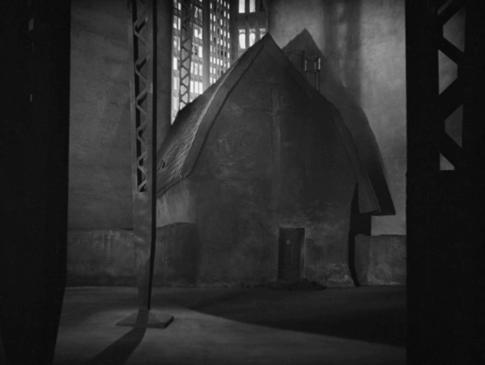
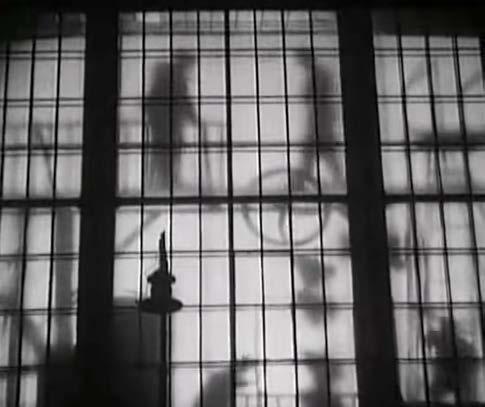
24
Relationship of Interior and Exterior (Fig. 25, 26 and 27) (Not to be confused with the ‘Interior and Exterior of ‘Elements of characters in cinema’)
“The way architecture takes a bit of the globe and constructs a tiny box of it. And suddenly there’s an interior and an exterior” 32. Thus it helps in establishing what is ‘inside’ and what is ‘outside’.
Peter Zumthor further adds that it creates an awareness of being enclosed, it becomes an arena for individuals and the public. The façade or the outer layer would define the relationship between the interior and the exterior 33. It could either be inviting and let people look into the interior or it could choose to be completely private by being a solid partition. There would also be times when the nature of the interiors is in complete contrast with the exterior emphasizing the duality of the character(‘living\animate’).
“The building always says something to the street or the square. They could say to the square: I am really glad to be situated on this square. Or they could say: I am the most beautiful building here – you lot all look ugly. I am the diva” 34. In an architectural setting the gestures and statements that these buildings metaphorically put forth, help in understanding the nature of the setting as well as the characters(‘living\animate’).
32 Zumthor, Peter. “Tension between Interior and Exterior” Peter Zumthor: Atmospheres: Architectural Environments, Surrounding Objects, Birkhäuser, Basel, 2006, p. 45.
33 Zumthor, Peter. “Tension between Interior and Exterior” Peter Zumthor: Atmospheres: Architectural Environments, Surrounding Objects, Birkhäuser, Basel, 2006, p. 47.
34 Zumthor, Peter. “Tension between Interior and Exterior” Peter Zumthor: Atmospheres: Architectural Environments, Surrounding Objects, Birkhäuser, Basel, 2006, p. 49.
Context
The film is set in a dystopian future where the rich industrialists have gained control over the city and the poor workers live a woeful life underground. The image of a house that belongs to a rogue scientist that very uncharacteristic in all aspects as compared to the rest of the city.

Metaphor and Subtext
The way this house appears in terms of its form and lack of any openings except a door and a skylight clearly signifies the scientist’s disregard for the city and its people.
(Fig. 26, 27) These are stills from the film ‘Parasite’(2019) directed by Bong Joon-ho.

Context
The first image (Fig. 27) shows the Kim family’s house which is located in the basement and the one window they have in their house, is a slit between their roof and the road outside. The second image (Fig. 28) is of the house that belong to thee Park family, for whom the members of the Kim family work.
Metaphor and Subtext
In the first house in the basement, the members are struggling to get a view outside which also signifies their struggle in life as well as their social status. And the Park’s have it the exact opposite. Thus their house is open and airy with large openings that look out into the greenery. And the location of the house is in the higher part of the city, just like their social status. Thus the subtext of disparity is conveyed using the setting.
25 •
26
Chapter -3 Case Study
27
— 3.1 Introduction: — 3.11 Macbeth — 3.12 Hamlet Cinematic adaptations of Shakespeare’s plays
28
Cinematic adaptations of Shakespeare’s plays
Filmmakers have been adapting written material and play for a very long time. Some of these adaptations at times have been faithful to the original material and there have also been instances of the adaptations changing the characters and contexts altogether. This trend of adapting plays for the same medium as well as on film has been ever so similar. But the difference here is that a novel and a play are fundamentally different, because while the earlier is meant to be read the other is to be performed.
The ‘theatrical’ quality of a play has always attracted directors towards it and the playwright whose work has been adapted the most is William Shakespeare. His plays have been adapted in multiple languages, countries, and contexts (in terms of time, physical and cultural). He also holds the record for being the most filmed author in any language. His plays Romeo and Juliet, Tragedy of Hamlet, Tragedy of Macbeth, Othello, King Lear, and Julius Caesar have been adapted the most. Many of these adaptations have been directed by cinema legends like Orson Welles, Sir Laurence Oliver, Akira Kurosawa, and Steven Spielberg.
While some adaptations have been true to the original material the others have changed the context and also a few characters in order to fit the context and the cut length. The chosen lineup shows how the same written material with different architectural settings can change how the film is narrated, experienced, and understood in the context it is set in, which would help in validating the hypothesis.
To further study and analyze how the architectural setting affects the storytelling and how each adaptation uses Elements of ‘Architectural setting as a Character in Cinema’ (discussed in the previous chapter) differently, the following films will be studied:
29 3.1 Introduction:
Architectural setting in the play
Macbeth was written by Shakespeare at a time when people in England and Scotland used to believe in witchcraft and wizardry, which made them superstitious. This play is a commentary upon the people and their beliefs of that time and age by asking a question that runs like a theme through it, ‘were you always doomed and destined to do this, or was it your choice’ 35 . These themes of morality and the superficial have been used differently in different adaptations depending upon the context it is set in. The action in Macbeth majorly takes place across three locations as per the play and they are:
• Inverness- Macbeth’s castle in Glamis where he assassinates Duncan.
• Forress Palace- The palace which belonged to Duncan, which Macbeth takes over after assuming the throne
• Dunsinane castle- The castle is said to be located on Dunsinane hill. The fortified nature of the castle makes Macbeth shift to Dunsinane after he gets to know that his throne is in danger. 36
The adaptations have used these different settings as per the shift in the story and the character arcs. However, cinematic adaptations have made changes to the setting by omitting some or by adding something else depending upon the film-maker’s vision and the nature of those settings would be discussed in the case studies.
The adaptation selected for case study are:
• ‘Macbeth’ (1948)
• ‘Throne of Blood’ (1957)
• ‘Tragedy of Macbeth’ (2021)
• ‘Maqbool’ (2004)
35 Green, John, CrashCourse. Gender, Guilt, and Fate - Macbeth, Part 2. CrashCourse, YouTube, 30 Jan. 2018, https://www.youtube.com/watch?v=4zd kun4xzOs. Accessed 22 Jan. 2022.
36 Shakespeare, William, et al. Macbeth play by William Shakespeare . Fingerprint! Classics, 2021.
30 Macbeth:
• ‘Macbeth’ (1948)
Director - Orson Welles
Language - English
Macbeth directed by Orson Welles is the first adaptation of Macbeth done on film with sound, all the adaptations prior to this were silent films. This was Orson Wells’s second feature film after the ambitious ‘Citizen Kane’ which is considered a modern classic. Having previously adapted this play for the federal government of Harlem(Fig. 5), the play was famously known as the ‘Voodoo’ Macbeth. Apart from that, he had worked on radio adaptations of ‘Hamlet’ for CBS Radio, Columbia Workshop, also in the same year as the Voodoo Macbeth, 1936.
• ‘Throne of Blood’ (1957)
Director - Orson Welles
Language - Japanese
Almost ten years after Orson Wells ‘Macbeth’, Akira Kurosawa made his own adaptation and based the story in Feudal Japan instead of Medieval Scotland. The reason for choosing this adaptation was that, unlike Orson’s adaptation, here the architectural setting was much more rooted in its context culture and time making it the most ‘vernacular’ adaptation.
• ‘The Tragedy of Macbeth’ (2021)
Director - Joel Coen
Language - English
Joel Coen’s adaptation is the most recent adaptation out of the ones selected for this study. It has a lot of similarity in terms of how the adaptation’s setting has been approached with Orson’s version. Because just like Orson’s adaptation, here too the setting has very less to do with the cultural context and more to do with its appropriateness with regards to the way the story is being narrated. The idea or the setting in Orson’s adaptation originated from his own play, whereas here the intention of the director was to have a sense of ‘playness’ in its architectural language and tone.
31
‘Maqbool’ (2004)
Director - Vishal Bhardwaj
Language - Hindi
Unlike other adaptations in this list, this one directed by Vishal Bhardwaj is set in Mumbai in the early 2000s and the monarchy in the original play and the earlier adaptations has been replaced by the crime lords and gangsters that used to run the political scenario in Mumbai during that time. Therefore the setting is much more realistic and nuanced as against what is done in Orson Welles’s and Joel Coen’s adaptations.
Hamlet:
Architectural setting in the play
Hamlet is the longest play written by Shakespeare. Similar to Macbeth, even this play is about morally ambiguous characters with a touch of the superficial. Here instead of witches, it is King Hamlet’s ghost that brings revelations. Adding to that it is also about indecisiveness, treachery, spying, death, and also an underlying theme of Oedipus syndrome.
Most of the action in the play takes place in the Elsinore palace itself, which also lends the setting a sense of isolation which seems appropriate given the fact that the characters themselves are such self-absorbed people which also makes them do terrible things. The three adaptations selected here have taken varied approaches and have pursued some them more than the others because of the length of the written material and depending upon the choice of the filmmaker.
The adaptation selected for case study are:
• ‘Hamlet’ (1948)
• ‘Hamlet’ (1996)
• ‘Haider’ (2014)
32 •
• ‘Hamlet’ (1948)
Director - Sir Laurence Oliver
Language - English
Sir Laurence Oliver’s ‘Hamlet’ was released in the same year as Orson Welles’s ‘Macbeth’, and just like that film, this was also considered a landmark in Hamlet’s cinematic adaptation. One of the major reasons for this could be that out of all the plays of Shakespeare, Hamlet has the least amount of spatial detail and the world of objects for its major thematic developments. This made the adaptation even more challenging because there wasn’t much to refer to which makes this effort even more commendable. This film subsequently won the Academy Award for Best Picture, Best Art Direction and Best Costume Design for that year.
• ‘Hamlet’ (1996)
Director - Kenneth Branagh
Language - English
The reason why Kenneth Branagh’s adaptation is highly regarded is that he took up the herculean task of adapting, directing, and starring in an unedited version of Shakespeare’s Hamlet -which is also his longest play- made the film 242 minutes long. Here the film is set in the 19th century and not in the 17th century as per the play, which is one of the few things that he had changed from the original. In this film, barring a few scenes, just like Oliver’s adaptation, most of the action takes place indoors.
• ‘Haider’ (2014)
Director - Vishal Bhardwaj
Language - Hindi
This film, just like ‘Maqbool’, was a part of Shakespeare’s adaptation trilogy directed by Vishal Bhardwaj, with ‘Haider’ being the last . This adaptation changes the setting to Kashmir of the early 1990’s during the insurgency, primarily commenting upon the Armed Forces (Special Powers) Act 1958. Thus by doing so it brings in the region’s socio-political state into the story to give a completely new facet which was not explored in the earlier adaptations.
33
The intent of doing these case studies is to bring out how the architectural setting of a similar written material affects the way the story and the film are experienced by the audience. In order to fully understand the influence of these architectural settings, it is imperative that the reader is aware of the complete context and does not miss the details of the setting as well as the story.
Many a time it so happens that in a scene there are several elements that come together that define the character of the setting. Here the frames of the sequence are aided by a separate narration of the story as well as the architectural setting. Thus with the help of this narrative-based graphical analysis, the complexity of these elements overlapping each other can be addressed in a correct manner that does justice to the scene and can iterate the relevance of the architectural setting with regard to the sequence, to get to a fair conclusion.
34 — Introduction and guidelines to read the graphical narrative
Guideline to read the graphical narrative
*E.g-
Text-box for dialogue
*The sequence of reading the conversations is from the top to bottom.
I do not seek his quarters. I come to air the sealed chamber. The place where the former Lord, Fujimaki, took his life. No scrubbing will cleanse the bloodstained floor, and thus the chamber remains locked.

That way lie the Great Lord’s sleeping quarters. No one may approach them.
*for reference
Text-box to narrate the story
Text-box to describe and analyze the architectural setting based on the elements discussed in Ch- 2.32
Text-box when a character narrates a flashback sequence Onomatopoeia
TRRING!
35
1.2 is in response to 1.1
Why open the room on such a night?
The Great Lord sleeps in our Lord’s chambers, thus he must rest here.
We are with the Garrison.
1.1 2.1 2.2 3 1.2
36
3.11 Macbeth
— Sequence 1.1 Macbeth and Banquo meet the witches for the first time.
— Sequence 2.1
Lady Macbeth instigates Macbeth to kill Duncan and take the throne and his subsequent assassination.
Sequence 3.1
Macbeth sees Banquo’s ghosts and his meltdown at the banquet.
Sequence
Sequence
Macbeth’s second meeting with the witches.
Sleepwalking Lady Macbeth and her subsequent suicide.
37
—
—
4.1 —
5.1
Sequence 1.11: Macbeth (1948)


As Macbeth and Banquo are returning from the war, on their way they encounter the three witches for the first time. The witches reveal their first prophecy to Macbeth and Banquo. According to it, Macbeth will soon become the Thane of Cawdor and will subsequently become the king of Scotland. And Banqu’s decedents shall rule after Macbeth.

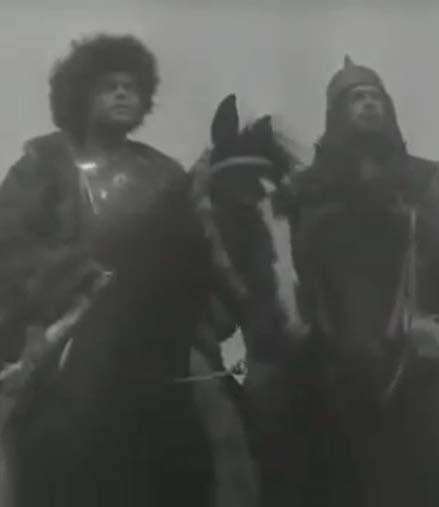
Speak, if you can: what are you? What is’t you do?
The ‘Voodoo’ doll-like figure used by the witches as an object/ idol symbolic for Macbeth In the film. It’s something that Orson Wells carried from his play ‘Voodoo Macbeth’ to his film adaptation which gives it the sense of mysticism and thus borders on being supernatural.
All hail, Macbeth, thou shalt be king hereafter!
All hail, Macbeth! hail to thee, thane of Glamis!
HAIL!
What are these that look not like the inhabitants o’ the earth, and yet are on’t?

Hail! to thee, thane of Cawdor.
If you can look into the seeds time and say which grain will grow and which will not, speak then to me...
Who neither beg nor fear your favors nor your hate.
38
HAIL!
HAIL!
Go herefrom! Leave!
As Macbeth is about to ask his question, some of his troops along arrive...

Hail! Lesser than Macbeth, and greater. Not so happy, yet much happier. Thou shalt get kings, though thou be none. So all hail, Macbeth and Banquo!


Stay, you imperfect speakers, tell me more. I am thane of Glamis, but how of Cawdor?
The place where Macbeth and Banquo meet the three witches is a deserted location with bare trees and rocky terrain. The witches stand on the highest rocks and recite their spell along with the prophecy. The misty weather is instrumental in making it difficult for the protagonists to see, which complements the supernatural nature of the encounter.



39
The witches suddenly disappear in the thick Fog....


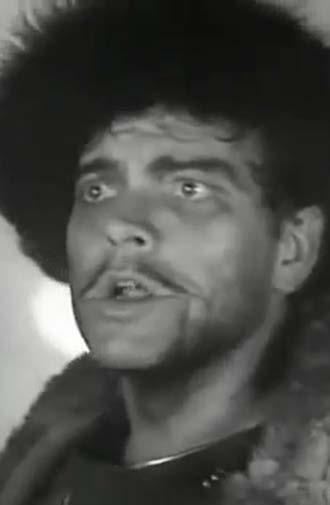


The thane of Cawdor lives, a prosperous gentleman; and to be king stands not within the prospect of relief, no more than to be Cawdor....
The troop congratulates Macbeth and tell him that the King has made him the Thane of Cawdor since the Thane before him has been charged for treason....
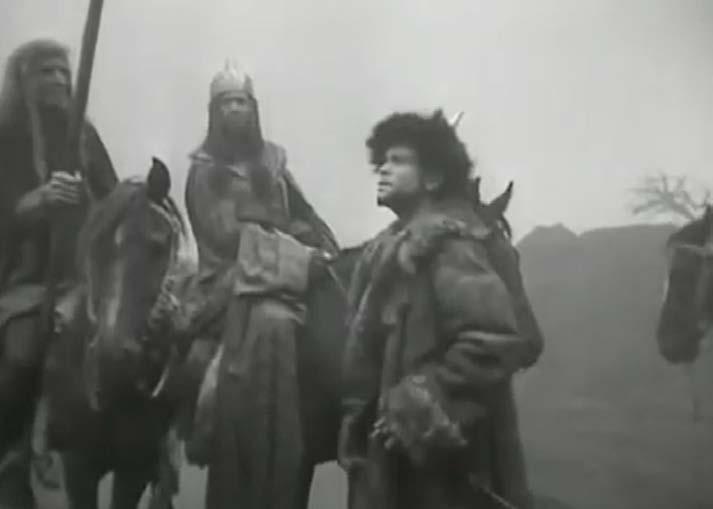
HAIL!
While on his journey Macbeth sends a letter to Lady Macbeth, telling her about his encounter with the witches and a part of their prophecy coming true....
40
Just like the description in the play, here too, Macbeth’s castle is located on the top of a hill (Dunsinane hill). This gives setting the isolation and the geographical elevation which is integral to the plot of the film (it’s importance would be discussed in the coming scenes).


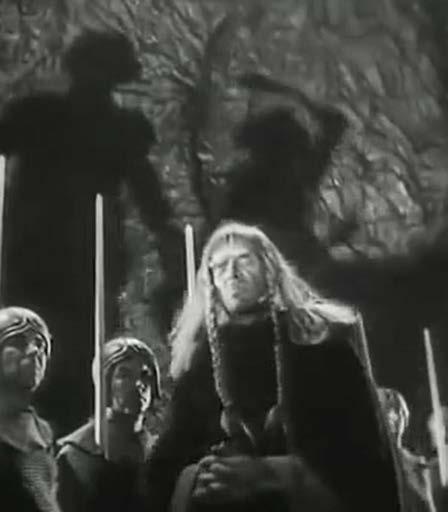
The dead body hanging behind in this frame symbolizes the beginning of bloodshed.

Macbeth reaches the castle and is greeted by Lady Macbeth. And while they wait for Duncan to arrive, They discuss the witch’s prophecy and the possibility of him becoming the King of Scotland....


DHUM
41
The haunting shadows of the Godman and the drummers before the traitor is killed by the executioner.
! DHUM! DHUM!
Sequence 1.12: Throne Of Blood (1957)





In the first sequence, the messengers inform Lord Tsuzuki that Washizu (Macbeth) and Miki (Banquo) have successfully commanded their respective forces against Innui’s army to save the empire from collapsing. To appreciate and honor their valor Lord Tsuzuki invites them to the Spider’s Web Castle.
The Spider’s Web Castle is located on the foothills of Mount Fuji which is not just the tallest mountain in Japan but is also volcanic. And because of this, the soil contains a lot of volcanic dust which flies around and gives the setting its rustic and unforgiving context. Thus the geographic location and the soil are a symbolic way of telling the audience about the eventual doom of the Castle and the kingdom.
While Washizu and Miki are on their way to the castle, they get lost in the forest as they face the stormy weather.....
Just as the name suggests, the Spider’s web forest is dense and disorienting in some ways, and on top of that, here the weather is rough and peculiar, making it difficult for Washizu and Miki to navigate their way to the castle.
Make haste. I wish to see our Lord’s joyous face.
What is this day? I have never seen such peculiar weather.
Indeed!
42
The importance of this castle is emphasized by the fact that it is strategically placed at the center of a labyrinth, that is the spider’s web forest, which would make it difficult for the enemy’s army to reach the castle when under attack.
Indeed, see the hoof marks where our horses tread. This is baffling.

No, this is... the very path where we last stopped our beasts.
The infamous Spider’s Web Forest. Stretching out like a spider’s web, protecting Spider’s Web Castle against all foes.

Ridiculous. Though perilous to our foes, surely we know this forest well....
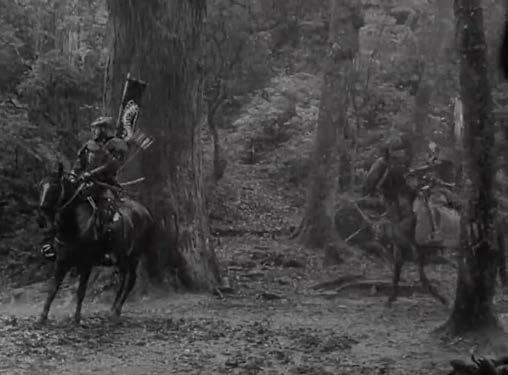



Hear that?
There’s evil afoot! That was an evil spirit.
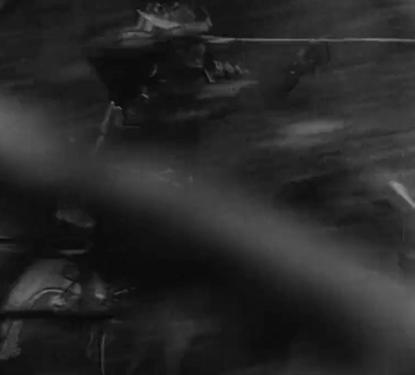
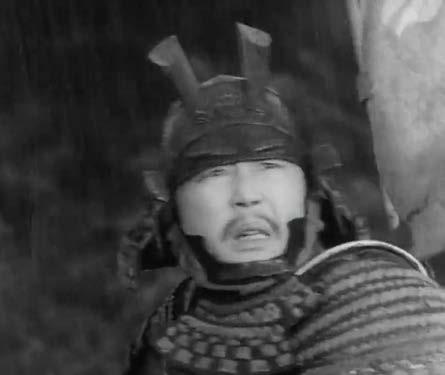
43
What is that? Do you recall such a hovel?



No, the sight is new to my eyes.
Also the work of an evil spirit. And yet... Look at the horses. They’re out of their wits.
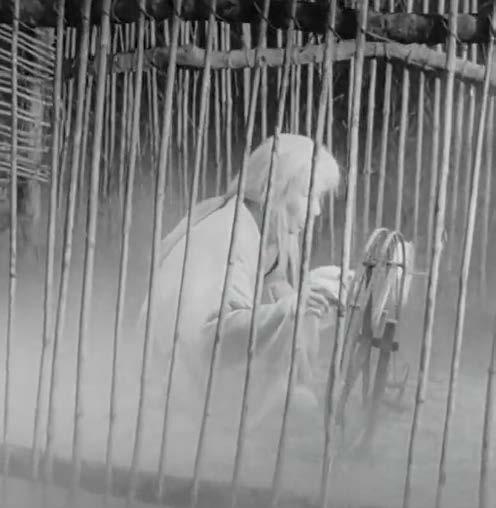

They find the spirit in a tiny cottage flimsily made out of bamboo and thatch sitting on a heap of straw, spinning a spool, whilst chanting in a low voice, almost murmuring. The dry vegetation around this hut is thicker and along with this is an unusual amount of fog, but it is also strangely bright at the same time. It is as if this hut is the center of a web with the evil spirit being the spider and the protagonist its prey.
*Singing* Strange is the world, why should men Receive life in this world? men’s lives are as meaningless as the lives of insects, the terrible folly of such suffering, a man lives but as briefly as a flower destined all too soon to decay into the stink of flesh, humanity strives all its days to sear its own flesh in the flames of base desire...
Exposing itself to Fate’s Five calamities heaping karma upon karma, all that awaits man at the end of his travails is the stench of rotting flesh,that will yet blossom into flower, its foul odor rendered Into sweet perfume... Oh, fascinating the life of Man oh, fascinating...

44
Who are you? Are you human or of the spirit world? Speak now.
Yes. Washizu Taketoki. Commander of the First Fortress.

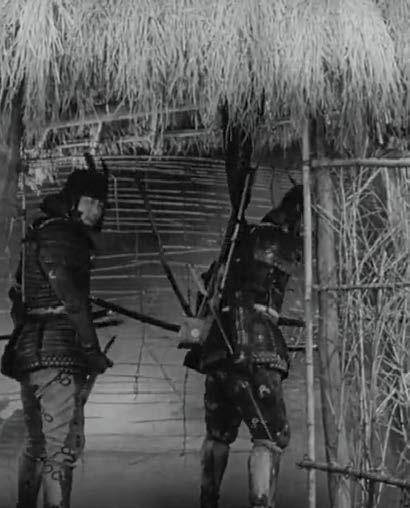
From this day forward, Lord of the North Garrison. One day, you shall also be Sovereign over Spider’s Web Castle.Why should you show fury when my tidings are so joyous? Human beings are so strange. Terrified to look into the bottom of their own hearts.
Wait now. Let me question further. Answer me this. Do you see into the future as clearly as my eyes now see?
Yes. Miki Yoshiaki. Commander of the Second Fortress. And henceforward, Commander of the First Fortress.
Even today, commander of First Fortress? And my realm and rank thereafter?
If you can sing, surely you can speak. What? You know of me?
How dare you. Cease your jesting.
After giving the prophecy, the spirit suddenly vanishes.....
Your destiny is both smaller and greater than that of Washizu. One day your son shall rule Spider’s Web Castle....
The fog begins to settle, revealing a pile of carcasses that presumably belonged to other warriors that may have fallen for the spirit’s prophecy, which hits at the events that are to happen soon.




45
Sequence 1.13: The Tragedy Of Macbeth (2021)

This sequence begins with a wounded trooper walking toward the hill tents where Duncan’s encampment, is located. He eventually manages to reach there and informs Duncan about their victory in the war and how Macbeth and Banquo valiantly fought through....

The fog on the battlefield adds to the overall experience of the scene because it hides elements of the setting, slowly revealing it through its course. Thus, adding suspense as well as mysticism to the sequence.

Macbeth and Banquo emerge through the midst of a thick fog with the sun looking like a spot of bright white, beating down on them in the background.

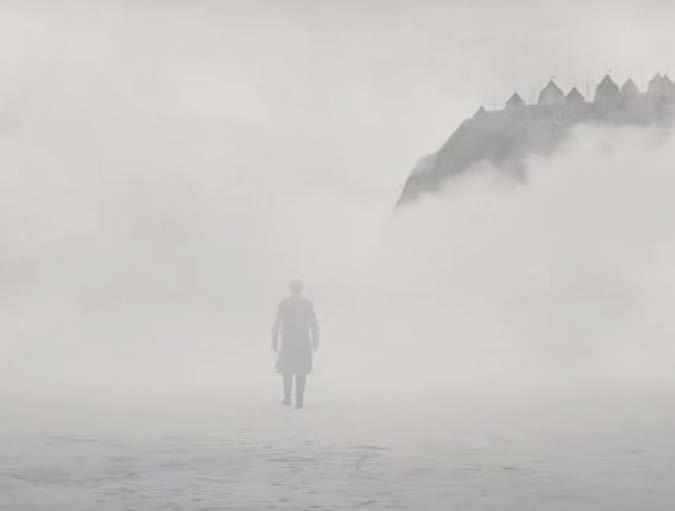
How far is it to Forres?
What are these, So withered and so wild in their attire. That look not like the inhabitants o’ th’ earth And yet are on ‘t? Live you or are you aught. That man may question?
So foul and fair a day I have not seen.
Suddenly, they stop when the witch appears in front of them....
46
Speak, if you can. What are you?
All hail Macbeth.
Hail to thee, Thane of Cawdor.
All hail Macbeth! Hail to thee, Thane of Glamis!
Good sir, why do you start, and seem to fear Things that do sound so fair? (to the witches)
If you can look into the seeds of time. And say which grain will grow and which will not, Speak then to me, who neither beg nor fear your favors nor your hate.
Not so happy, yet much happier.
All hail Macbeth, that shall be king hereafter.



As Macbeth advances towards them, the witches start back away into the fog….

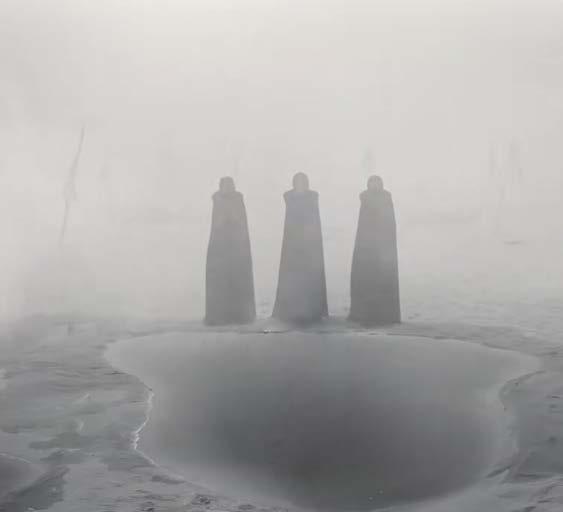

Lesser than Macbeth, and greater.
The battlefield that they are walking through is dry arid land so the possibility for it to have any source of water or rain is very slim. This actually leaves us with the conclusion that the puddle that we are seeing is in fact a mirage, thus informing the viewers that neither the puddle nor the reflection of the witches in it is real but fantastical in nature.
Stay you imperfect speakers, tell me more: I know I am Thane of Glamis, But how of Cawdor? The Thane of Cawdor lives, a prosperous gentleman; and to be king. Stands not within the prospect of belief. No more than to be Cawdor. Say from whence. You owe this strange intelligence, or why. Upon this blasted heath you stop our way. With such prophetic greeting. Speak, I charge you.!
Thou shalt get kings, though thou be none. So all hail, Macbeth and Banquo! Banquo and Macbeth, all hail!
47
The earth hath bubbles as the water has, And they are of them. Wither are they vanished?
Into the air, and what seemed corporal melted. As breath into the wind. Would they had stayed!

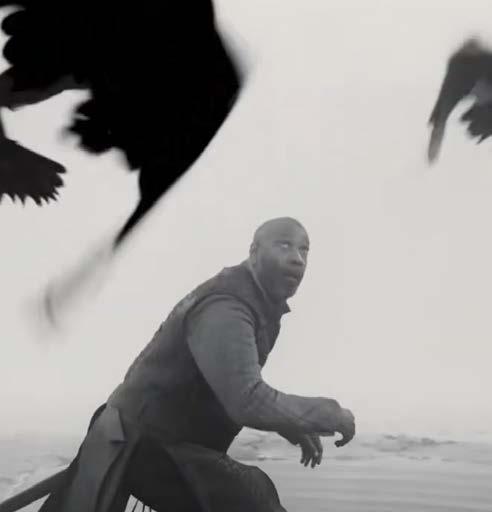
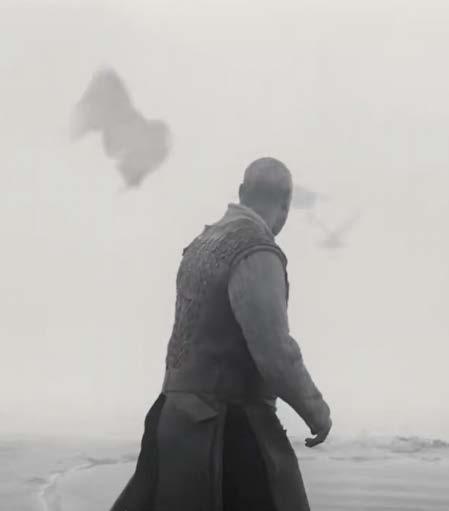
Later, when Macbeth gets to know that he has been appointed the thane of Cawdor, just like the witches’ prophecy, he sends a letter to Lady Macbeth at Inverness (Macbeth’s Castle) telling her about the prophecy turning out to be true and the possibility of him becoming the King of Scotland....
I burned in desire to question them further, they made themselves air, into which they vanished....
As Lady Macbeth moves further into the dark corridor. The contrast in light makes her look like a dark silhouette which metaphorically tells the audience about her growing dark desire.
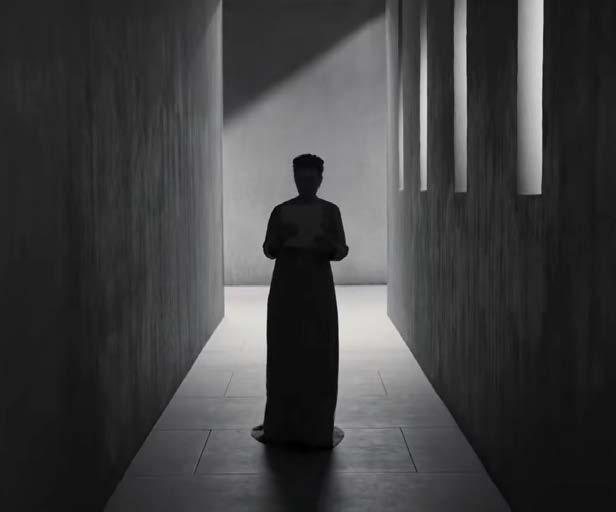

Whiles I stood rapt in the wonder of it, came missives from the king, who all-hailed me Thane of Cawdor, by which title, before, these weird sisters saluted

and referred
to the coming on of time
king
48
The
witches turn into ravens and fly away without answering his questions....
“When
me,
me
with ‘Hail,
that shalt be!’ ”....
This have I thought good to deliver thee, my dearest partner of greatness, that thou might’st not lose the dues of rejoicing by being ignorant of what greatness is promised thee. Lay it to thy heart, and farewell.

Glamis thou art, and Cawdor, and shalt be. What thou art promised.
Yet do I fear thy nature. It is too full o’ th’ milk of human kindness.
To catch the nearest way. Thou wouldst be great, Art not without ambition, but without. The illness should attend it. What thou wouldst highly. That wouldst thou holily; wouldst not play false, And yet wouldst wrongly win.
She throws the burning letter out through the balcony and watches it fly through the night sky...


Hie thee hither, that I may pour my spirits in thine ear. And chastise with the valor of my tongue. All that impedes thee from the golden round.
The next morning Macbeth returns. And as they discuss about the letter he also informs her that Duncan would be coming to Inverness and will be staying there for a night...



49
She dips the paper into candle flame for it to catch fire and burn...
Sequence 1.14: Maqbool (2004)

The sequence begins in the hall at Abbaji’s(Duncan) farmhouse(where Maqbool stays). Here, Maqbool(Macbeth), Kaka(Baquo) and the two corrupt Police officers Purohit and Pandit(Witches) are drinking and relaxing after finishing their day’s work, that was to kill Abbaji’s traitors...
His bad patch has just cleared… he’ll get whatever he wants… whatever…
Officer Pandit
is also an astrologer...
Throughout the film, he keeps drawing the horoscope to predict the future of the people around him. Here he predicts that Maqbool will soon become the leader of the gang...




For example…?

50
Bollywood...
Bollywood… in six months’ time, Abba ji’s own throne will be Miyan’s to claim. ‘King of Kings’...
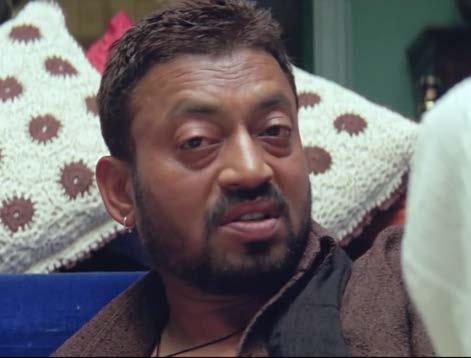

If I believed in any of your mumbo jumbo, Pandit… I’d have sliced your tongue off today.


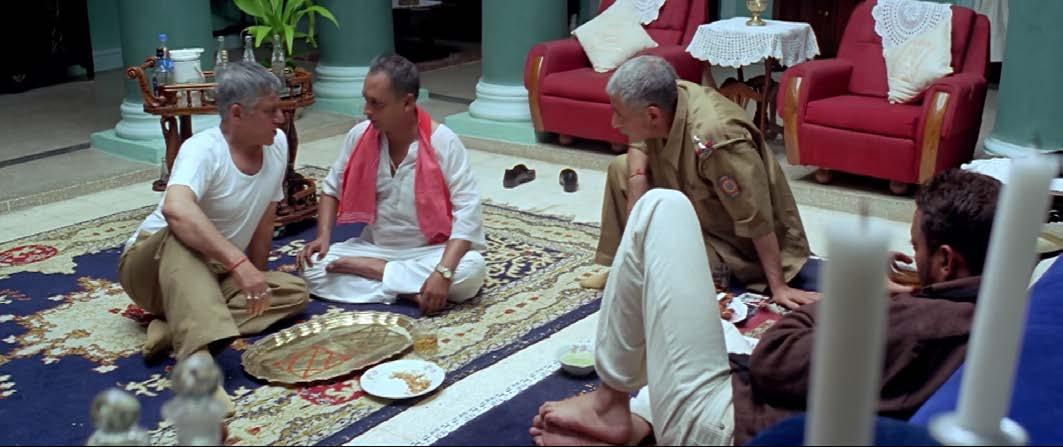

Slice it off, Miyan… whatever he says always comes out to be true. Six months back, he tells me… your neighbor’s going to die of AIDS… stay away from her… what do I tell you Miyan… this healthy buxom woman… goes out like that… in five months’ flat…

51
That’s Abba ji’s brother-inlaw’s turf. That Asif…nobody’s getting that in a hurry… he’ll go whining to Abba ji…
Your comet has entered the seventh house in Venus… this normally signifies the king’s reign…
Shut your nonsense!
Any forecasts for me, Panditji?

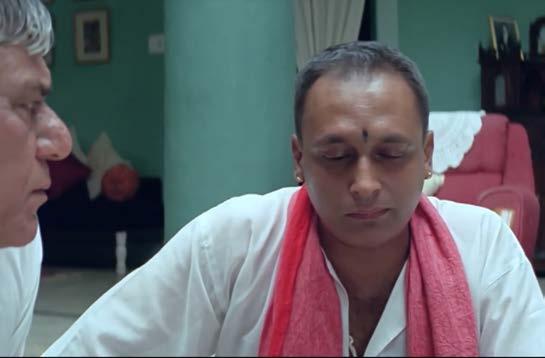
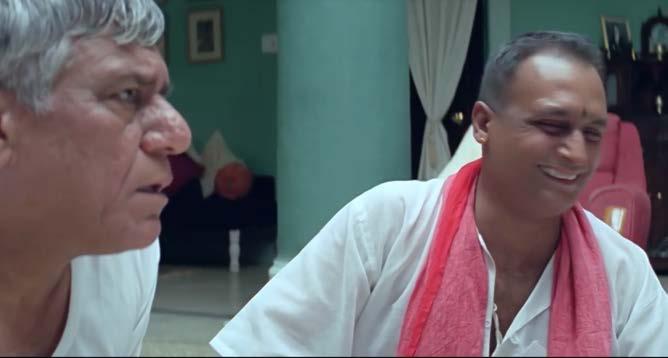
Shut your mouth… all of you. I mustn’t have killed any less than Miyan… ya… and that includes tonight’s.

Remarkable! It’s a miracle you’re still alive…
I’ve seen your son’s chart… that lad has great promise
He’s the next Miyan in the making for sure…
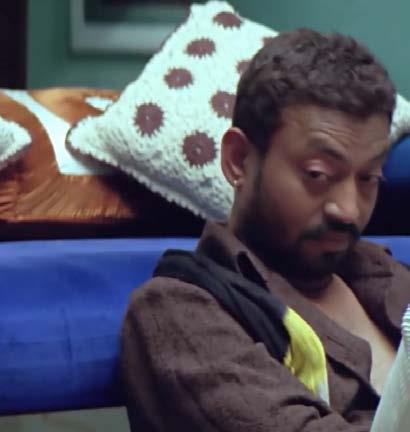
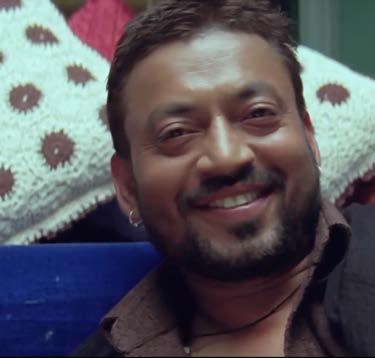
The living room has large sea-green colored columns, creating a corridor like space on the edges and the center becomes a dominant enclosure of sorts. The hall has a lot of old furniture and objects which tell us about Abbaji’s wealth. The fact that Maqbool is trusted enough to live there tells us that he has been working with Abbaji for a very long time and is one of his most trusted personnel, almost like a son since Maqbool has no family of his own.


52

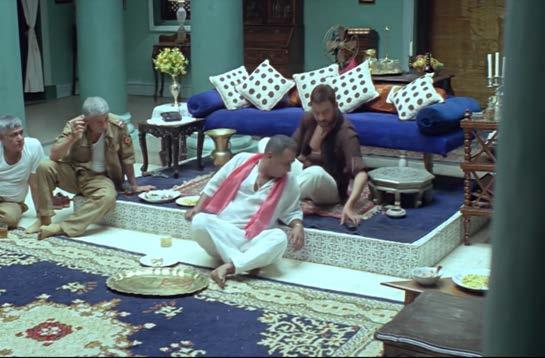




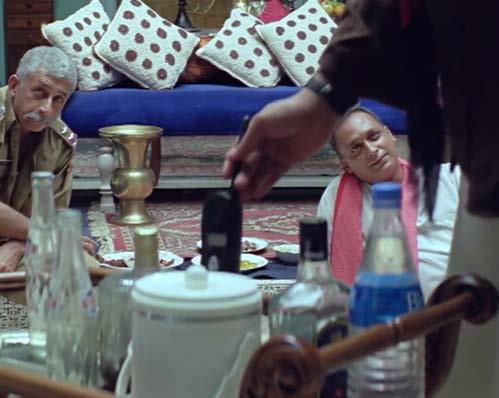

53 The telephone rings and kaka gets up and answers the call... But there is no response. The phone rings again, But it’s Maqbool who picks it up this time... Maqbool walks away to the other side of the enclosure as he feels the need to get some privacy and that part provides him with it. Since Nimmi is calling from the same room where Abbaji is asleep, she does not turn on the light and we can only see her dark silhouette in this scene. Maqbool hears Nimmi’s(Abbaji’s wife, who secretly has an affair with Maqbool) voice, and he walks away to the side and answers awkwardly.... Maqbool jokingly replies... Hmm… I’m fine…… Are you ok?… Purohit’s neighbour… should I call her? TRRING! TRRING! Hey, it seems this guy’s really in love Who is it? Name?
Sequence
Macbeth (1948)





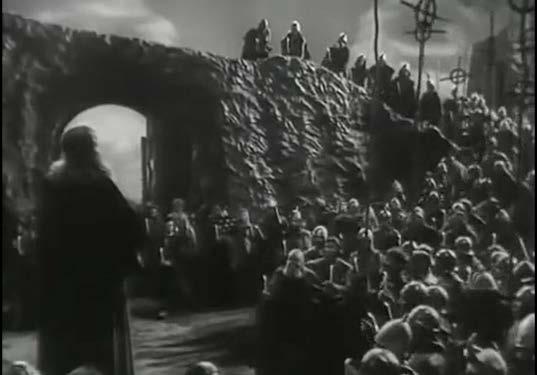

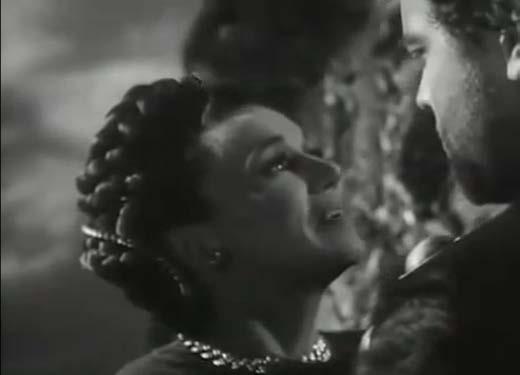
While Duncan is on his way to Macbeth’s castle, Lady Macbeth begins to convince Macbeth that he must embrace his ‘heart’s desire’ to become the King of Scotland. She tries to convince him that they must not let go of this opportunity to kill Duncan and must soon act upon it....
Put this night’s business into my dispatch. Your face, my thane, is as a book where men may read strange matters. To beguile the time, look like the time; Bear welcome in your eye, your hand, your tongue. Look like the innocent flower, but be the serpent under’t. When Duncan is asleep, whereto the rather shall his day’s hard journey soundly invite him, I’ll drug his servant’s wine
Duncan
King Duncan is my kinsman. He hath borne his faculties so meek hath been so clear in his great office, that his virtues will plead like angels, trumpet-tongued, against the deep damnation of his taking-off;
Once the prayer meet gets over Lady Macbeth spikes the drink and gives it to the guards who are on duty outside Duncan’s room..
The soldiers gather along the staircase continuing the same curvilinear form, thus creating a small enclosure.
54
arrives at the castle.... All the people in the castle join for a prayer meet...
2.11:
CLICK! CLICK! CLACK! CLACK! THUMP! THUMP!THUMP!
If it were done when ‘tis done, then ‘twere well it were done quickly. If the assassination could trammel up the consequence and catch with his surcease success, that but this blow might be the be-all and the end-all here. But in these cases we still have judgment here that we but teach bloody instructions, which, being taught, return to plague the inventor this even-handed justice commends the ingredients of our poisoned chalice to our own lips.
The lack of light upon Lady Macbeth in this scene reveals her dark intentions making her look like a ghost. But as she gets down the stairs, she is relatively well lit which shows the dual nature of her character.

Will it not be received, when we have mark’d with blood those sleepy two of his own chamber and used their very daggers, that they have done’t?
When in swinish sleep their drenched natures lie as in a death, what cannot you and I perform upon the unguarded Duncan?
As they hear someone coming, Lady Macbeth quickly leaves for Duncan’s room through the back entrance...
Who dares receive it other, as we shall make our griefs and clamour roar upon his death?
Orson Wells already had a predetermined idea about how he wanted the spatial composition of the castle to be since he had already directed a play adapting Macbeth. He went ahead with the same composition and with the shift in the medium from theatre to film he was able to show the intended scale as well as the material (Fig 4, 5).





55
Macbeth awaits her return as she gives the drink to the guards....
As it turns out, it was Banquo with his son....
The room in which King Duncan is staying for the night is located much higher and could also probably be the highest point of the castle. This metaphorically tells the audience about the current hierarchy of the characters and Duncan being the king, is at the highest point and rightly so.

What, sir, not yet at rest? The king’s a-bed. He hath been in unusual pleasure, and sent forth great largess to your offices. This diamond he greets your wife withal. I dreamt last night of the three weird sisters: To you they have show’d some truth.
I think not of them.
Thanks, sir: the like to you!
Who’s there?
Meanwhile, Lady Macbeth goes to the room where Duncan’s asleep and takes away the guard’s weapons....
Lady Macbeth’s shadow looming over King Duncan is metaphorical because she is the one planning his doom.
For the better part of the sequence, Macbeth’s s face and body are halflit which complements his thoughts because throughout the sequence he keeps talking to himself trying to decide if he should do the deed or not.


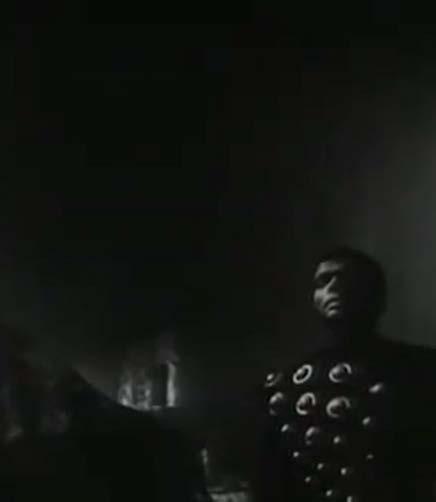
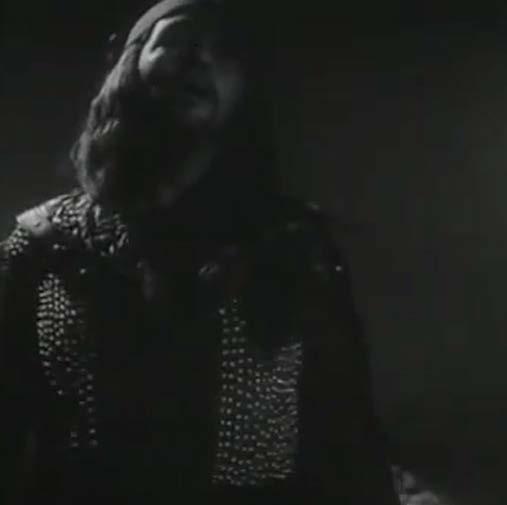
Now o’er the one halfword nature seems dead, and wicked dreams abuse the curtain’d sleep. Is this a dagger which I see before me, the handle toward my hand? Come, let me clutch thee.

56
I have thee not, and yet I see thee still. Thou marshall’st me the way that I was going; Art thou not, fatal vision, sensible to feeling as to sight? or art thou but a dagger of the mind, a false creation, proceeding from the heatoppressed brain? I see thee still, and on thy blade and dudgeon gouts of blood, which was not so before.
What news?
The doors are open; and the surfeited grooms do mock their charge with snores. We will proceed no further in this business.
If we should fail?
Was the hope drunk wherein you dress’d yourself? hath it slept since? And wakes it now, to look so green and pale on what it did so freely? From this time such I account thy love. I dare do all that may become a man; who dares do more is none.
Thou sure and firm-set earth, hear not my steps, which way they walk, for fear thy very stones prate of my whereabout. I go and it is done; the bell invites me.
We fail! But screw your courage to the sticking-place, and we’ll not fail.
Macbeth finally gets convinced and Walks up the stairs, towards Duncan’s room, while Lady Macbeth waits for him.... (In this adaptation the audience is not shown how Macbeth kills Duncan)





57
Sequence 2.12: Throne Of Blood (1957)





After being promoted as the Lord of the North Garrison, Washizu and his wife Asaji have shifted to the Northern fort. But Asaji isn’t happy and content with what they have received....
The Northern fort is not the grandest of places but is an endearing place nonetheless. This is also expressed by one of the men working in the fort right before this conversation by calling it a paradise. It is located atop a hill surrounded by more such mountains with thickets and fields near the castle, as opposed to the infamous labyrinth-like Spider’s Web forest surrounding the Spider’s Web Castle. Even the scale of the built forms is much smaller, barely going above two floors in height.
Awfully peaceful!
Vastly superior to the discomfort of a fortress. Life can always be improved.
Surely, this is paradise.
Fine fortune for we who serve them, but our Lord and Lady must be well satisfied.
The retainers bow as they see Washizu coming out of the room...
58
The brightness and warmth outside are in contrast to the dark and chilly atmosphere in the room.
Did you make up your mind?
Do not call your dream preposterous. Any man who takes bow in hand would dream of such a fate.
No. I prefer to remain here. I will serve my Lord loyally from this Garrison. Savor the peace of a life befitting my rank.
Slaying the Great Lord would be high treason.
My Lord, you have but two paths ahead. Remain here and patiently wait for our Great Lord to slay you, or slay him first and become the Lord of Spider’s Web Castle.
I dreamt an evil dream. Beguiled by a wicked spirit. But I no longer waver.
Preposterous, to wish I were Lord of Spider’s Web Castle.
What if Miki Yoshiaki should disclose the forest spirit’s prophecy to our Great Lord? If that comes to pass, we shall not survive here. At once, the Great Lord would surround this castle with his men, jealous of the threat you pose to his hegemony.
Did not the Great Lord secure his own position murdering his predecessor?
Asaji isn’t happy and content with what they have received and this can be understood by the audience, if observed carefully, even before she lets out her feelings. Throughout the scene she sits facing the wall opposite the openings expressing her dissent for the place and the position they have received from Lord Tsuzuki.
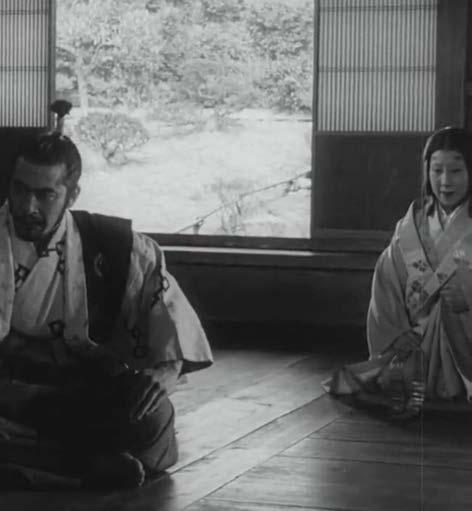




No, only because his own Lord doubted him and sought his death. Our Great Lord trusts me. He treasures me like no other.

59
Should Miki inform him of that prophecy?
Miki is... Miki is my beloved friend from childhood
He is incapable of betrayal.
The forests surrounding North Garrison are thick with armed men, all from Spider’s Web Castle. Their flags and spears are lowered, their horses bridled with twigs.
In this degenerate age, one must kill so as not to be killed. I cannot help wondering if Miki has already informed the Great Lord.
Asaji... Do not speak of your doubts again!
Lord. I’ve word. 300 men of Spider’s Web Castle lurk in the woods. They have assembled in silence.
Just as he finishes his sentence a guard arrives...
Washizu rushes out to check what’s going on....


Washizu gets scared thinking if what Asaji said was actually true, and that Miki had in fact revealed the prophecy to the great Lord and he was here to attack him....




60
Men, form your ranks. Fall in men!
News for Washizu, Lord of North Garrison.
My congratulations on your bountiful kill.
No, the hunt is only a pretext that I may deploy my men to attack Inui.
The Great Lord is out hunting incognito. And thus no need for an official reception.
Inui’s behavior is untenable. Knowing this day would come, I overlooked his conspiracy with Fujimaki. Take heed. Hereafter, I quarter at North Garrison here, secretly fortify our border, and attack when opportunity permits. Until then, not a word to anyone. I elevate you in recognition of your courage. Washizu take my vanguard, Miki, Spider’s Web Castle.
Asaji. Now your suspicious heart must find respite. Our Great Lord trusts me. In your uneasy heart that would slander Miki, that evil spirit lurks.
I cannot agree.
After the meeting Washizu defends Lord Tsuzuki by saying that had he not had faith in him he wouldn’t have made him the vanguard but Asaji is still skeptical....

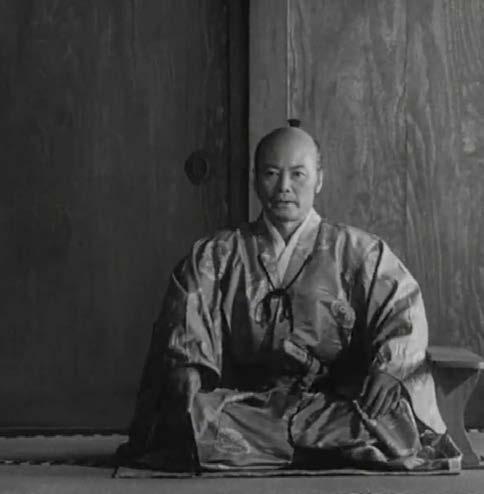

Although it is the same room where they had greeted Lord Tsuzuki earlier that day, it now looks relatively dark and grim with only a handful of lamps lighting the room.


61
Yes sir!
Yes sir!
And still you doubt. Listen. Great Lord places his trust in me above all others.
Thus he gives me the noble rank of vanguard commander.
This vanguard commander is vulnerable to arrows on every side. Great Lord is a fox. With easy words, he cheats you of the North Garrison, sends his trusted Miki out of danger to guard Spider’s Web Castle, and casts you, his most hated adversary, into danger.
The scene cuts to the corridor where the Great Lord’s soldiers guard his room....

We are with the Garrison.
From the heights of the castle keep, Miki will laugh as he watches you take your last gullible breath.
Who’s there?
I thank you for your labors. You may pass.
I do not seek his quarters. I come to air the sealed chamber. The place where the former Lord, Fujimaki, took his life. No scrubbing will cleanse the bloodstained floor, and thus the chamber remains locked.





That way lie the Great Lord’s sleeping quarters. No one may approach them.
Why open the room on such a night?
The Great Lord sleeps in our Lord’s chambers, thus he must rest here.
62
Most peculiar. Though I have waded through endless mires of battle dead, these blood stains never fail to chill my spine.
For this is dog’s blood. The blood of a traitor most foul who, when his rash schemes failed, begged our Great Lord for his life. This is coward’s blood.
*BIRD’S SCREECHING* Damn! (Scared) even the birds cry ominously.
Meanwhile, Asaji continues to convince Washizu to kill Tsuzuki....

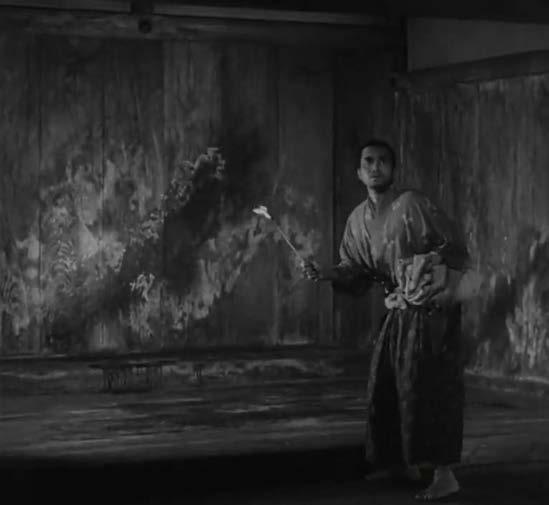

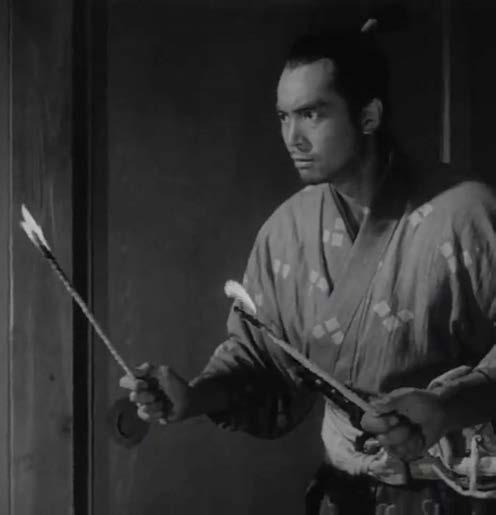

You accuse me of doubting too deeply. Yet even my distrustful heart, cannot help but trust that spirit’s prophecy.

63
Open your eyes and look for yourself. Each truthful provision of that prophecy has come to pass, without the slightest help from you.
And yet... under what pretext can I commit high treason? In any case, all his men will turn against me.
Do you still not comprehend it?
The Great Lord himself has flown into your very hands. If you let this night pass, such an opportunity will never come again.
Suddenly they hear some footsteps along with a torch, approaching their room....
Who’s there?
Your sleeping quarters are ready.(the retainer answers)
Though the Great Lord claims to trust you, he’s left Noriyasu’s men to guard him. This is our good fortune. We’ll quench their thirst with a sleeping potion mixed in sake. As his guards dream, you shall slay the Great Lord, and denounce Noriyasu as the murderer to his own men.





And how did you leave the Great Lord’s guards?
Spears poised, they maintain their sleepless vigil.
Indeed they do. Let us offer them some sake, then.
Good work.
The room from which she brings out the spiked/poisoned sake is completely dark which is in line with her dark and malicious intentions.

64
Soon, the guards fall asleep after consuming the spiked sake....
Washizu and asaji have now shifted to the other room.... After making sure that the guards have passed out, she goes back into the room and hands the spear to washizu, who takes it and finally goes to assassinate Lord Tsuzuki.





Interestingly, this is the room where the previous Lord -the treacherous Lord Fujimakicommitted suicide. And it is also the room where Washizu is convinced to assassinate the king and returns with blood-soaked hands after doing so. Which makes this room a symbol of treachery, bloodshed, and a bad omen. The fact that the bloodstain doesn’t come off the walls makes it a motif that conveys the message that one cannot ‘scrub off’ their treacherous deeds.
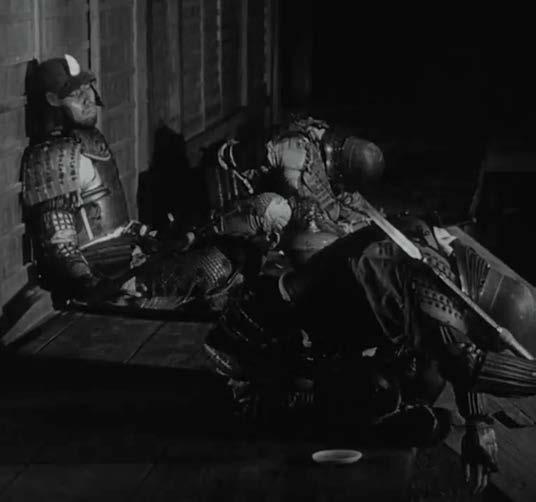
65
The Tragedy Of Macbeth (2021)
King Duncan arrives at Inverness (Macbeth’s castle) where Lady Macbeth greets him in the courtyard and then directs him to the room where he shall rest during his stay at the castle. Meanwhile, Macbeth standing alone by the corridor, looks at them from a distance. As they leave the court he begins to talk to himself, wondering if he should do the deed or not....




Joel Coen intended to keep the setting very minimal, and sharp retaining the ‘play-ness’ in it, so much to the point of it being almost unreal.37 At the beginning of the scene, we can see the castle in the background, devoid of any ornamentation or articulation almost falling into being brutalist in its nature which is contrary to the architecture of the time and place the story is set in.
37 Correspondent, Special. “Joel Coen Distills ‘Macbeth’ down to the Bone - New Delhi Times - India Only International Newspaper.” New Delhi Times, 23 Dec. 2021, https://www.newdelhitimes.com/joelcoen-distills-macbeth-down-to-the-bone/.
If it were done when ‘tis done, then ‘twere well It were done quickly. If th’ assassination could trammel up the consequence, and catch. With his surcease success, that but this blow. Might be the be-all and the end-all — here. But here upon this bank and shoal of time, we’d jump the life to come.
This evenhanded justice Commends th’ ingredient of our poisoned chalice to our own lips. He’s here in double trust: First, as I am his kinsman and his subject, Strong both against the deed; then, as his host, who should against his murderer shut the door, not bear the knife myself.

66 Sequence 2.13:
Besides, this Duncan Hath borne his faculties so meek, hath been so clear in his great office, that his virtues will plead like angels, trumpettongued against the deep damnation of his taking-off;
Wherein you dressed yourself? Hath it slept since? And wakes it now to look so green and pale a what it did so freely? From this time such I account thy love.

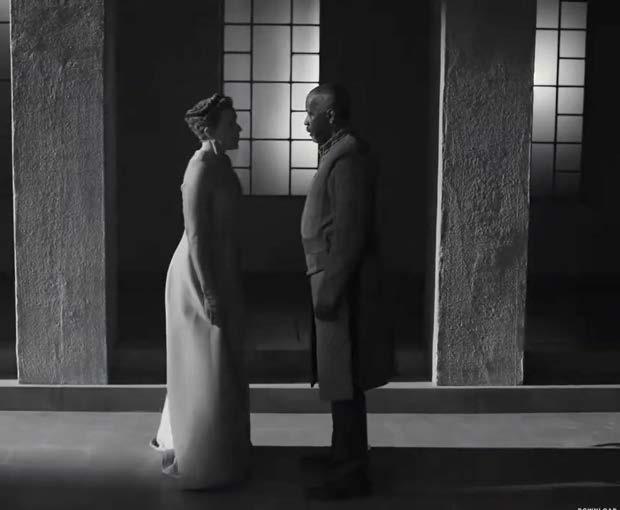

We will proceed no further in this business. He hath honored me of late, and I have bought golden opinions from all sorts of people, which would be worn now in their newest gloss, not cast aside so soon.
He has almost supped.
I have no spurt to prick the sides of my intent, but only vaulting ambition, which o’erleaps itself and falls on th’ other—



How now? What news?
Art thou afeard to be the same in thine own act and valor as thou art in desire? Wouldst thou have that which thou esteem’st the ornament of life, and live a coward in thine own esteem, letting “I dare not” wait upon “I would,”like the poor cat I’ th’ adage?
67
Hath he asked for me?
Know you not he has?
If we should fail?
Here, both Lady Macbeth and Macbeth are standing on the edge of the passage with the moonlight covering half their faces. Whenever Lady Macbeth speaks, the camera is inside the passage with only a part of the face, which is covered in shadow, visible. And wherever Macbeth speaks, it is an over-the-shoulder shot that also shows the other half that is lit with moonlight. By doing so the director informs the audience about their different states of mind. Lady Macbeth being decisive and consumed by her dark intentions, and Macbeth in conflict and unsure of what he must do.
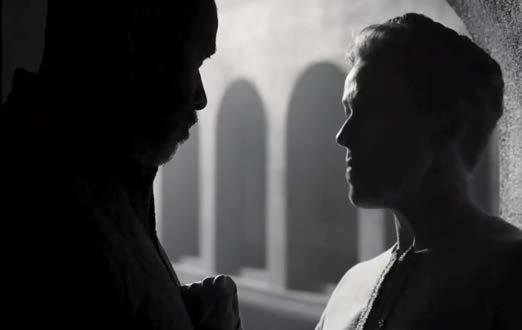

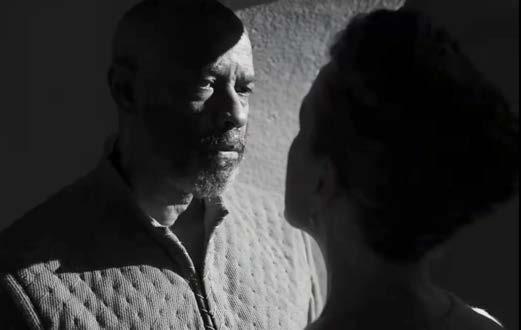
Will it not be received, when we have marked with blood those sleepy two of his own chamber and used their very daggers, that they have done’t?

We fail. But screw your courage to the sticking place and we’ll not fail. When Duncan is asleep, whereto the rather shall his day’s hard journey soundly invite him, his two chamberlains will I with wine and wassail so convince that memory, the warder of the brain, shall be a fume, and the receipt of reason a limbeck only
When in swinish sleep Their drenched natures lies as in a death, what cannot you and I perform upon th’ unguarded Duncan? What not put upon His spongy officers, who shall bear the guilt of our great quell?
Who dares receive it other, as we shall make our griefs and clamor roar upon his death?
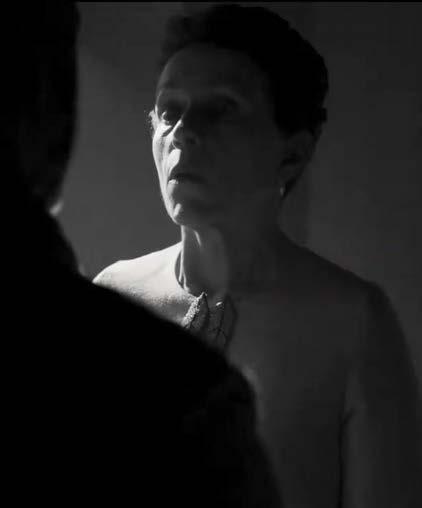
68
I am settled, and bend up each corporal agent to this terrible feat away, and mock the time with fairest show; False face must hide what the false heart doth know.
Since Macbeth is about to do the deed, in this shot where he comes in front of Banquo, he looks like a dark figure which symbolically tells us about his ‘dark’ intention.




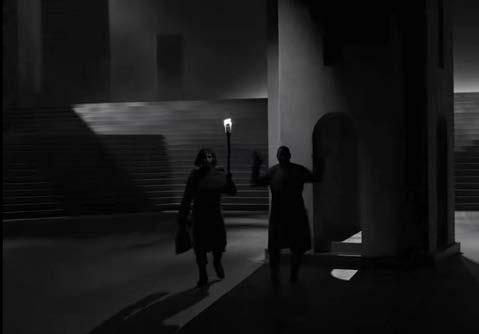



Give me my sword! Who’s there?
A friend.
I dreamt last night of the three weird sisters.
To you they have showed some truth.
I think not of them. Yet when we can entreat an hour to serve, we would spend it in some words upon that business, if you would grant the time.
69
What, sir, not yet at rest?
TIP! TAP! TIP! TAP!
Good repose the while.
At your kind’st leisure.
Thanks, sir. The like to you.
Go bid thy mistress, when my drink is ready, She strike upon the bell.
Get thee to bed.
The servant nods his head and leaves...
This light creates a sharp rhythmic pattern of light and shadow throughout the passage, which metaphorically talks about the conflict in his mind.




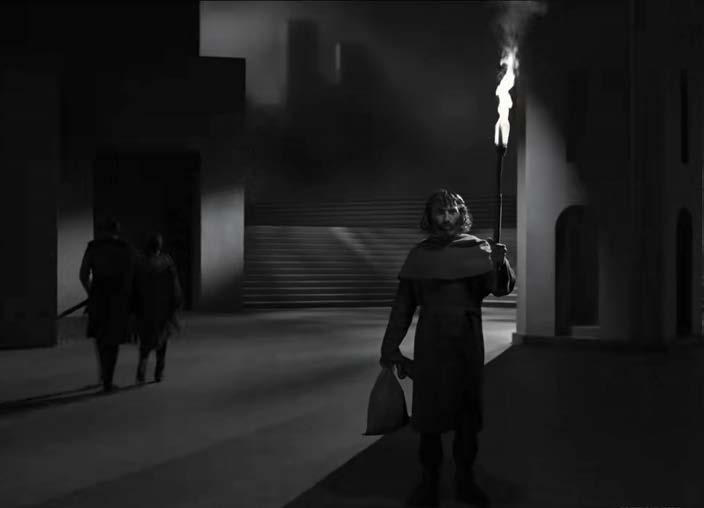
70
Is it a dagger which i see before me? Come, let me clutch thee. The handle toward my hand. I have thee not, and yet I see thee still.


As Macbeth begins to walk towards the door, his mind is still in doubt (which is evident from the dialogue) and this confusion is metaphorically articulated when he walks through that pattern of light and shadow.



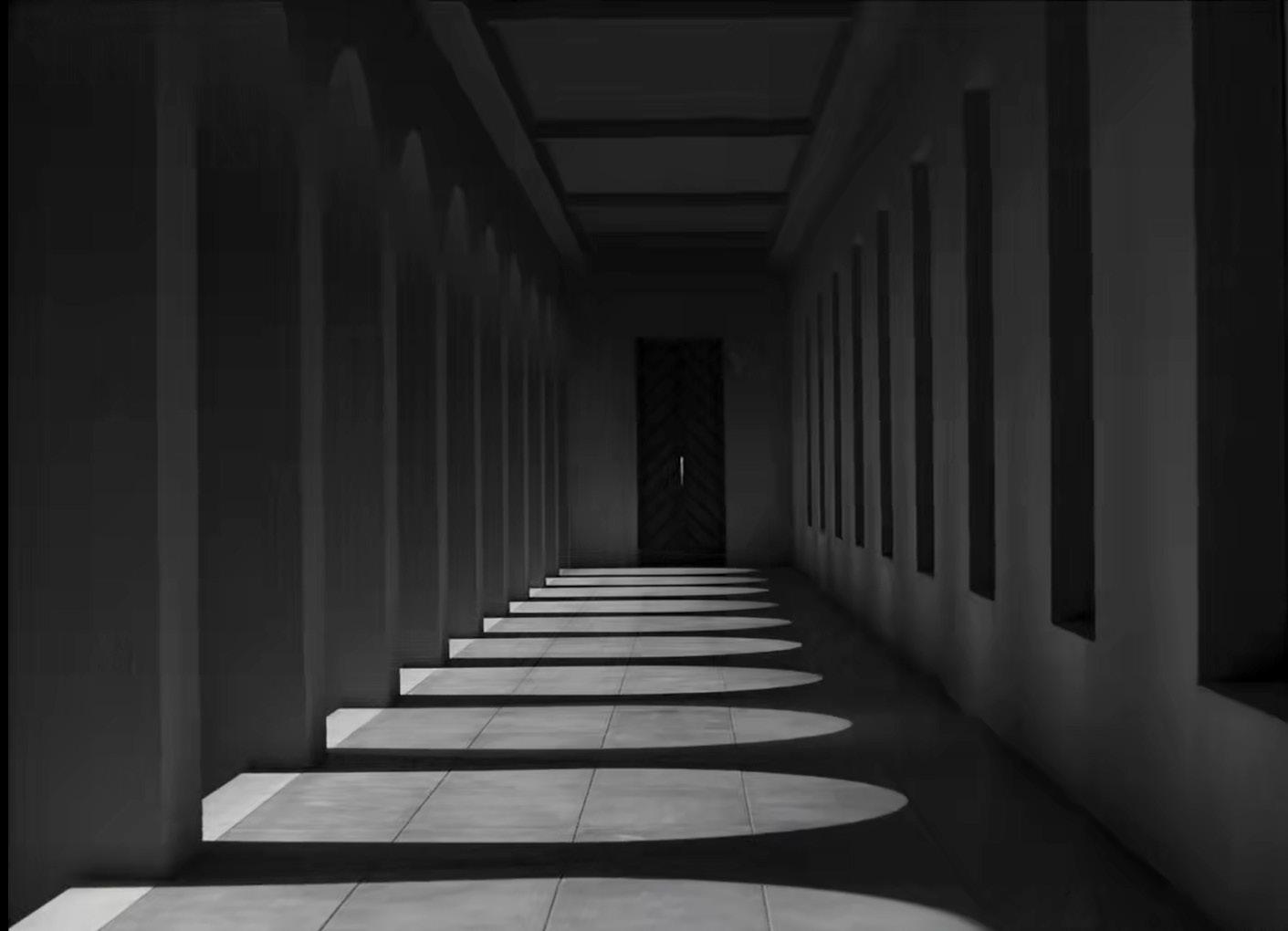
Art thou not, fatal vision, sensible to feeling as to sight? Or art thou but a dagger of the mind, a false creation proceeding from the heatoppresséd brain? I see thee yet, in form as palpable as this which now I draw.
Joel Coen takes this figuratively said dialogue and uses it to the advantage of the visual narrative by making the handle of the door in the shape of a dagger.
71 TIP! TAP! TIP! TAP! KA-CHING!
The sound of the boots build up the tension even further.


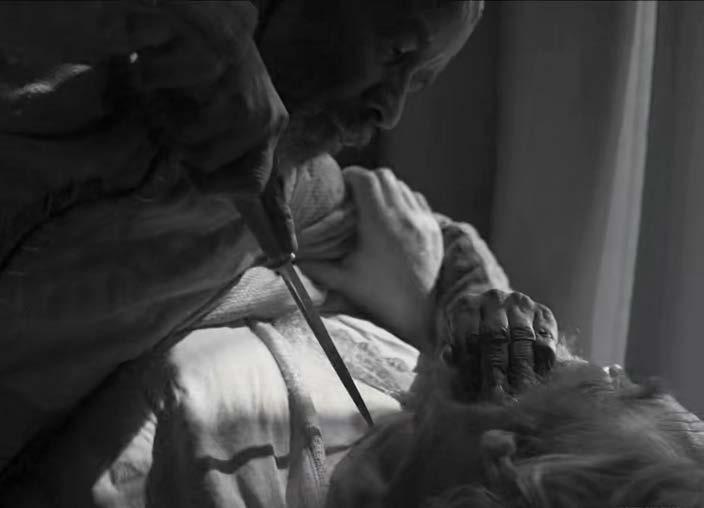


72 SHHH!! Hear it not, Duncan, for it is a knell that summons thee to heaven… UGH.. AAAHHGH!! As Macbeth begins the act, Duncan has a patch of moonlight on his face, whereas Macbeth’s face looks dark. Metaphorically suggesting the nature of both the characters.
In this frame we see Macbeth standing right in front of the window which blocks the light and also creates more contrast making him look like a dark silhouette. The Gothic proportion of the window here helps in accentuating his towering and evil presence because of its tall and narrow shape.




73
Blup!... Blup!... Blup!... Duncan’s guards lay of the floor after being poisoned by Lady Macbeth....
Sequence 2.14: Maqbool (2004)
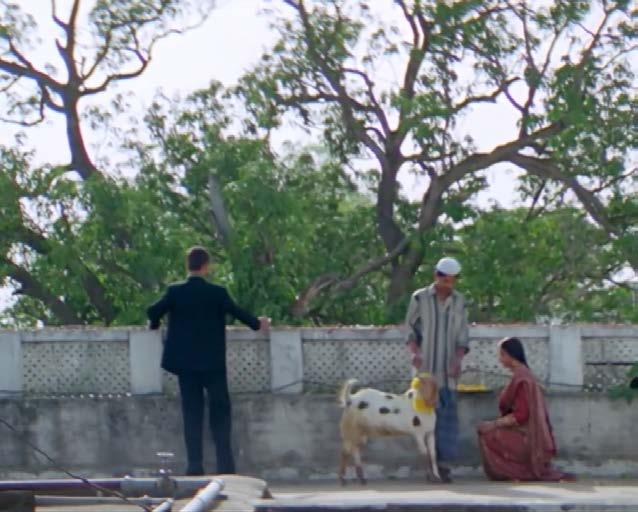
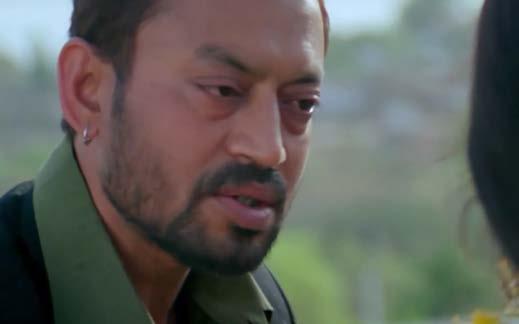


The sequence begins at the farmhouse, where Abbaji’s daughter gets engaged to Kaka’s son, Guddu. At the engagement party, Abbaji is seen dancing with another woman, and seeing this Nimmi gets worried because she thinks that Abbaji might leave her for that woman. And because Guddu will soon become Abbaji’s Son-in-law, he would become the obvious successor and not Maqbool, whom she loves and has a secret affair with.



74
It’s time you sacrificed me too… Jahangir’s got his new mistress…
He is like my father! I’ve been brought up in this house..
Even dogs are brought up in houses, Miyan...
Shush!
Here her resolute dialogue is complemented by a stark patch of evening light washing over her face, with Maqbool’s pale face looking at her.



The earlier shot cuts directly to the butcher slaughtering the goat and the blood coming onto the other part of the terrace through the drain hole of the parapet. This blood symbolizes the beginning of bloodshed for power and love (particularly in Maqbool) with the Abbaji subsequently becoming the first victim and the scapegoat for their unruly desires.


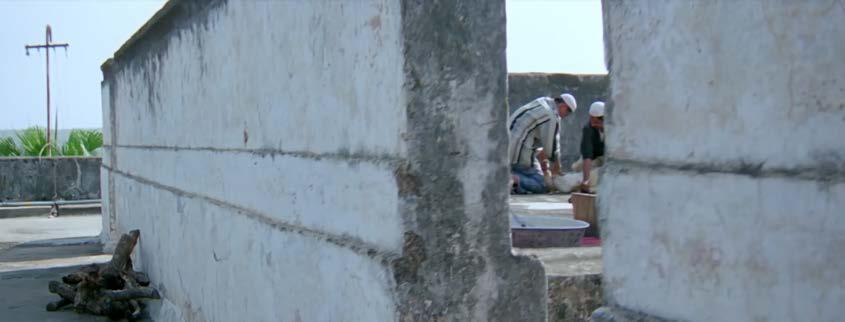
75
I can’t see you wagging your tail groveling behind Guddu. You’ll have to kill one of us...
Me... or Jahangir.
Here the terrace is starkly lit in moonlight, especially the area near the wall with Maqbool and Nimmi standing in front. Just like in the previous scene, Nimmi’s astute face is fully covered in the light, whereas the conflicted Maqbool has half his face covered in it and the other-half in sharp shadow.
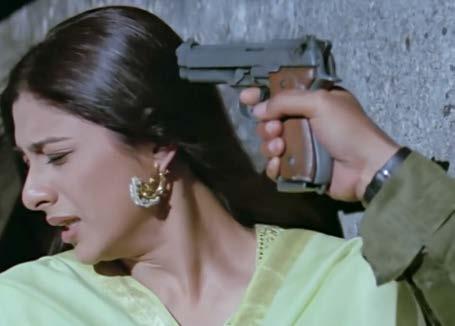
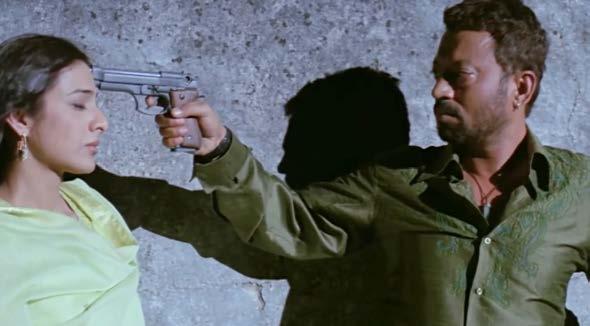
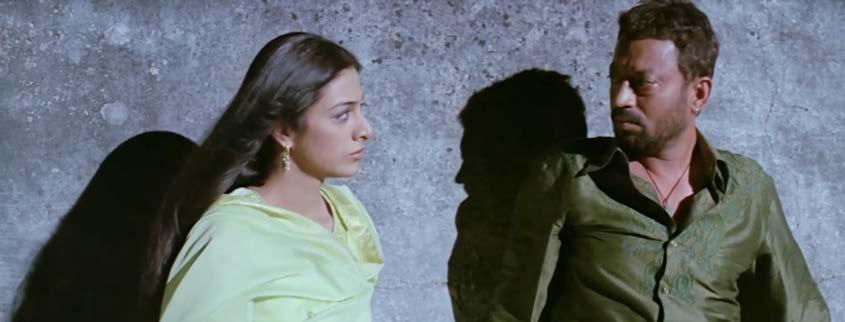


Such strange weather… In my seventy years, I’ve never seen it rain in this month… Lord have mercy…

76
At
night the
weather
begins to turn
stormy
and peculiar...
Have you decided?
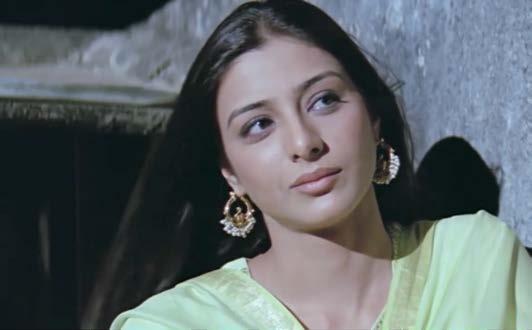
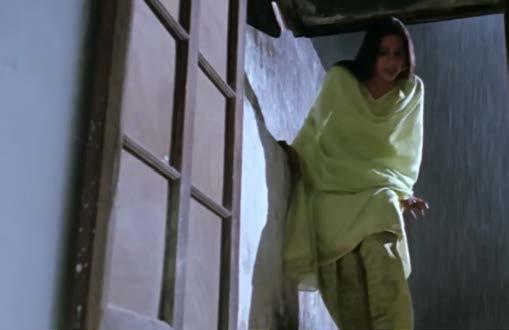



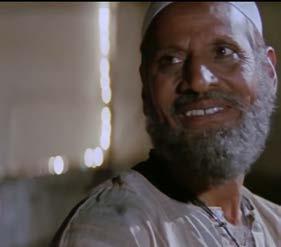

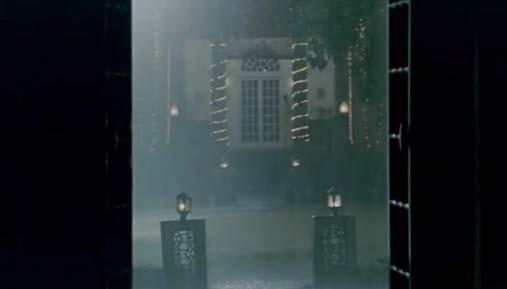



77
The puddle of blood on the terrace turns out to be just a puddle of rainwater that stayed on the floor.
The scene then cuts to him going downstairs, by then it has also started raining again. He then goes back inside the house and picks Usman’s(Abbaji’s bodyguard) gun, while he has passed-out after being forcefully asked to drink by abbaji.
Ramzu… Ahmed… Why has the blood not been washed off?
It’s clean sir
The light quality of the room keeps changing with the thunder and lightning that gets reflected inside.



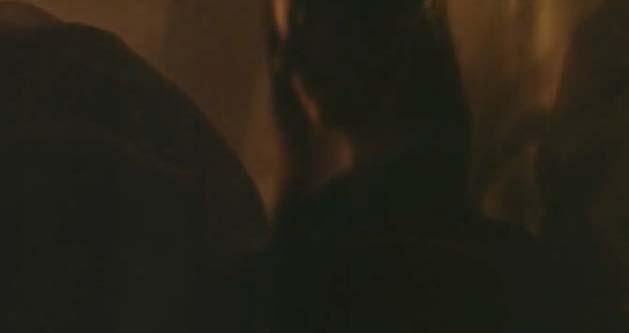

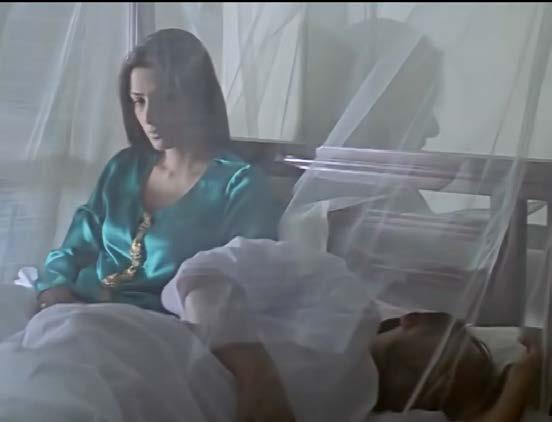


78
Maqbool sneaks into abbaji’s room where he is asleep while Nimmi is awake and sitting next to him, waiting for Maqbool to arrive...
The window next to the bed is open and a storm with thunder and lightning begins. The fluttering light of the lightning (which is the only source of light in the scene) gets reflected all over the room highlighting the theme of nature being at war with itself as something unruly is being done. This is a metaphorical sign of what is to happen.


After shooting Abbaji, Maqbool puts the gun back in Usman’s hand. Nimmi fires a gun shot through the window, knowing that hearing the gun-shot, Usman would be the first to come and when he does, she will shoot him and put the blame of killing Abbaji on him....
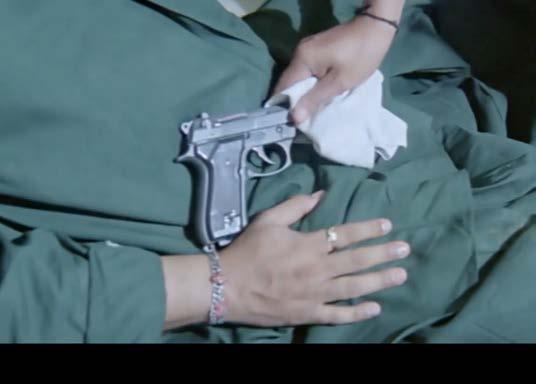





79
Sequence 3.11: Macbeth (1948)
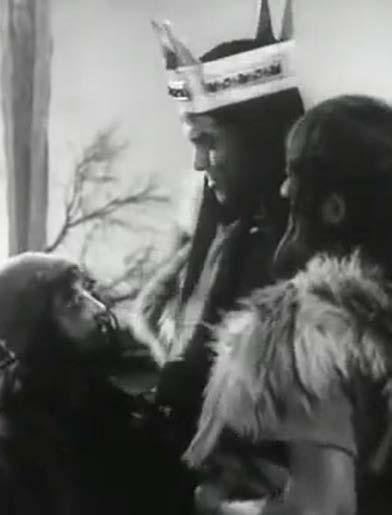



After Duncan’s death, his son, scared that he might be blamed for his father’s death, runs away and Macbeth takes the throne for himself. He begins to worry that according to the prophecy, Banquo’s son would succeed him. And so, he hires two assassins to kill Banqou and his son while they are on their way to the castle for the party at supper.
Just before supper, the assassins return with the news that although they successfully managed to kill Banquo, they were not able to kill Fleance as he managed to get away....
The room where these assassins meet is a very dark, grim, and labyrinth-like tunnel with niche-like spaces at some spots, one of which is occupied by them in this scene. The only visible source of light in this space is the ends of the tunnel but since the surfaces of this space are uneven, the light that falls on them and reflects is very irregular, forming strange pockets of light.
80
There’s blood on thy face. ’Tis Banquo’s then? Is he dispatch’d?
My lord, his throat is cut; that I did for him.
Then comes my fit again! I had else been perfect, whole as the marble, founded as the rock, as broad and general as the casing air:
Most royal sir, Fleance is ‘scaped.
Yet it was said It should not stand in thy posterity, But that myself should be the root and father of many kings.
Thou art the best o’ the cut-throats: yet he’s good that did the like for Fleance
Thou hast it now: king, Cawdor, Glamis, all; all, as the weird women promised. And, I fear, thou play’dst most foully for’t. Thou play’dst most foully for’t:
In this scene, like several others, the amount of light falling on Macbeth’s face tells us about the kind of emotional state he is in. In the beginning, when the assassins tell him about how they successfully killed Banquo, he is visibly happy and is covered in bright light but as soon as they tell him that they weren’t able to kill Fleance, he pushes them aside in anger and moves into the dark corner. To further accentuate this, the camera angle is such that it makes this setting seem even more claustrophobic.





81
While he is walking towards the banquet, we see a few drops of water leaking from the ceiling and then eventually see a puncture in the ceiling near the wall where a stream of water is flowing down which is symbolically showing his failing plans and him sweating because of fear and panic.






82
Macbeth, then reluctantly accepts his fate and starts walking towards the banquet where other courtiers are waiting for him.
And first and last the hearty welcome. Here had we now our country’s honour roof’d, Were the graced person of our Banquo present; His absence, sir, lays blame upon his promise.
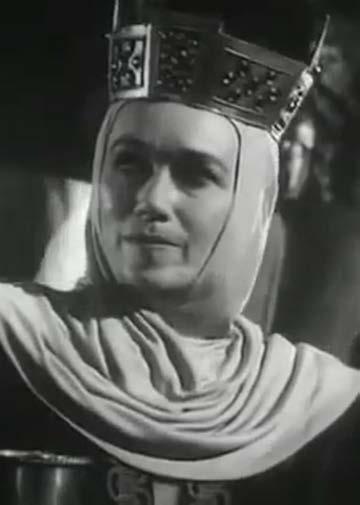

Sweet remembrancer! I drink to our good friend Banquo whom we miss! Would he were here!




Look!
Thou canst not say I did it; Never shake thy gory locks at me.
83
My royal lord, you do not give the cheer.
Just when Macbeth is addressing the people at the table, he begins to hallucinate Banquo’s ghost, smiling and sitting on the other end of the table.
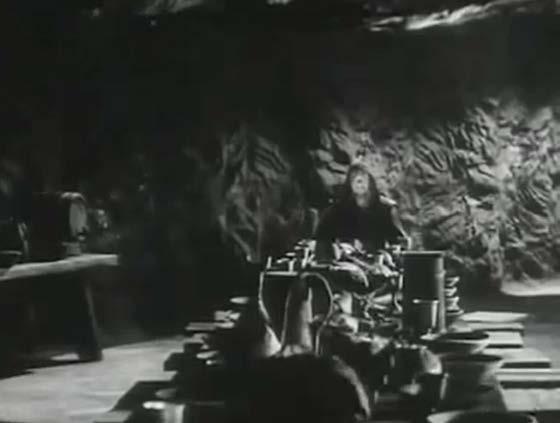





The movement of his hand creates a shadow in the background which keeps getting bigger as it moves further towards Banquo and this happens because the wall has an uneven surface which makes it appear in this way.


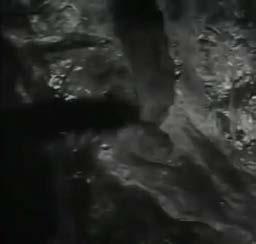
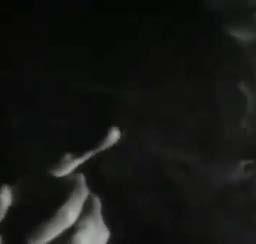
Avaunt! and quit my sight! Let the earth hide thee! Thy bones are marrowless; thy blood is cold. Thou hast no speculation in those eyes which thou dost glare with!
Shame itself! Why do you make such faces? When all’s done, you look but on a stool.
84
Duncan! Why, what care I? If thou canst nod, speak too. If charnel-houses and our graves must send those that we bury back, our monuments shall be the maws of kites.

The fit is momentary; upon a thought he will again be well. (to the guests)
This is the very painting of your fear.! This is the air-drawn dagger which, you said, led you to Duncan.(to Macbeth)




CLING! CLING!
The role of the canopy, apart from covering the table, is to shrink the scale of that space to make it appear a lot smaller and tighter, which accentuates Macbeth’s feeling of helplessness at this point.

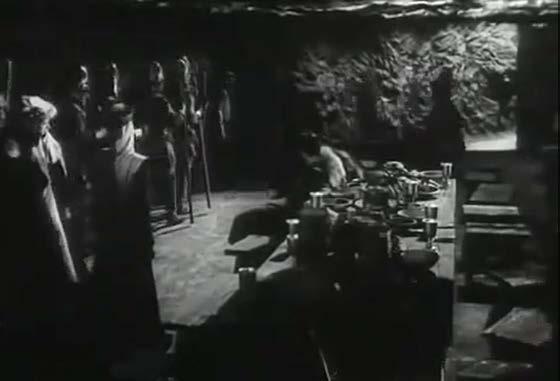

Blood hath been shed ere now, i’ the olden time, ere human statute purged the gentle weal Ay, and since too, murders have been perform’d too terrible for the ear.
Fie, for shame!
Everyone leaves the table but Macbeth stays....
I pray you, speak not; he grows worse and worse. Question enrages him. At once, good night. Stand not upon the order of your going, but go at once! (to the guests)
85
Sequence 3.12: Throne Of Blood (1957)






In ‘The throne of blood’, the chronology of the turn of events is changed. Here the Washizu doesn’t know if the assassin has done the job or not until the end of the feast. The sequence begins with the courtiers in the hall sitting on the floor mats, on either sides of Wasizu, while he and Asaji sit on a thicker mattress.

That’s enough.
Enough of your dancing.
Washizu vents out his anxiety on the performer, telling him to stop it at once...
Sir...
The camera zooms on to Washizu’s face while he is nervously having his sake. Then suddenly his nervousness turns into fright. As the camera zooms out we see Miki’s ghost sitting on the spot that had been kept vacant for him, but we soon realize that this is in fact a projection of Washizu’s mind.
86
Damn you, Miki. Such insolence.
Lately, he is often this way when he has had too much to drink. No doubt his predecessor’s violent death tears at his heart.


Remove yourself!
Calm yourself. He has imbibed too freely.
The room here is lit by candles at regular intervals in front of all the people who are present for dinner that night and all the shutters are closed. The enclosed nature of the space heightens Washizu’s feeling of being trapped.
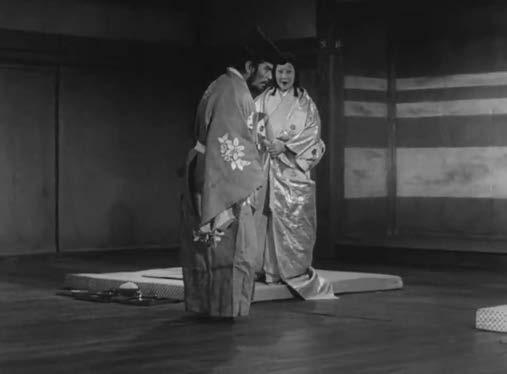





87
I’m terribly drunk.


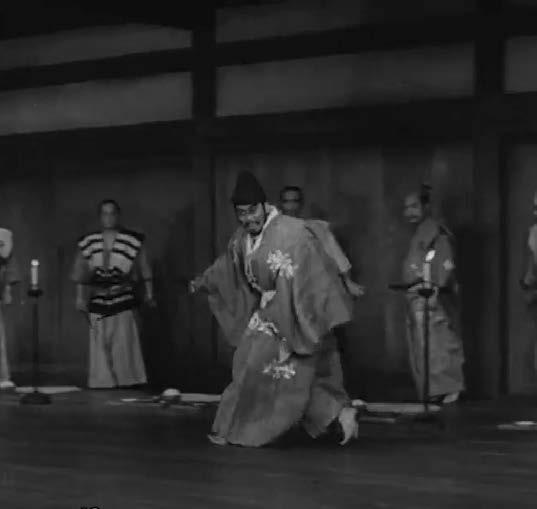



88 Throughout
the
film Washizu
expresses his fear by finding a corner, which is metaphoric to being
cornered
and intimidated; the design of the setting in the film provides such spaces for that.
Washizu finally musters some courage, picks up his sword, and starts frantically swinging it on his projections of Miki, while the guests look on trying to get to terms with what’s going on....
There
he is again!
If
you reprove me so,draw your sword and strike.
I’ll
slay you yet again!
My
Lord.!
Pay him no mind. His confusion will subside with the liquor.








89
Washizu slays the assassin and kills him, leaving him in pain.... But as he is still scared of Miki’s ghost, he timidly moves back to the wall distancing himself from Miki’s the severed head...
Forgive this unseemly disruption of our feast. Please retire for the night. How brilliant.
A Great Lord, his ambitions set on the world, terrorized and undone by phantoms.
Lord Miki is done with...
I wounded him, but he escaped, clinging to his steed.
AUGHHH!!
(As the man begins to open Miki’s severed head)Enough!
There is a more pressing question. His son?
The Tragedy Of Macbeth (2021)



After Duncan’s death, the action shifts to Foress (Duncan’s castle). Banquo begins to wonder if it was the Witches’ prophecy that was coming true or was it Macbeth who killed Duncan. Macbeth invites him and his son Fleance for a feast that night and also asks him about his travel plans that evening and those of his son....
The setting in this scene is pitch dark; with only a ray of light to highlight Banquo is similar to a spotlight that is commonly used in theatre. This is one of the many ways that director Joel Coen has brought ‘set-like’ and ‘theatreisque’ elements to the setting of the film.
Thou hast it now — king, Cawdor, Glamis, all, as the weird women promised; and I fear thou play’dst most foully for’t. Yet it was said it should not stand in thy posterity, but that myself should be the root and father of many kings. If there come truth from them— As upon thee, Macbeth, their speeches shine—Why, by the verities on thee made good, may they not be my oracles as well, and set me up in hope?
The rectangular and semi-circular arched openings and cloisters are replaced by pointed arches which do not just bring in the Gothic proportions but are also similar to the shape of a dagger, which becomes a motif of bloodshed and treachery in the film.


Ay, my good lord.
As far, my lord, as will fill up the time ‘Twixt this and supper. Go not my horse the better, I must become a borrower of the night for a dark hour or twain.

We should have else desired your good advice, which still hath been both grave and prosperous, in this day’s council; but we’ll take tomorrow. Is’t far you ride?
Fail not our feast.
Here’s our chief guest. Tonight we hold a solemn supper, sir, and I’ll request your presence. Ride you this afternoon?

90 Sequence 3.13:
You made it known to us.
Know that it was Banquo, in the times past, which held you so under fortune, which you thought had been our innocent self. This I made good to you in our last conference, passed in probation with you how you were borne in hand, how crossed; the instruments; who wrought with them; and all things else that might to half a soul and to a notion crazed say “Thus did Banquo.
We are men, my liege.
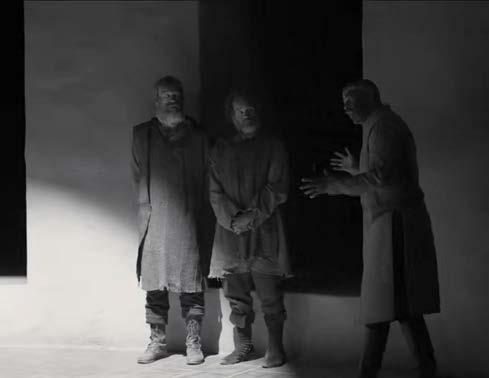
Ay, in the catalogue ye go for men.
Do you find Your patience so predominant in your nature that you can let this go? Are you so gospeled to pray for this good man and for his issue, whose heavy hand hath bowed you to the grave and beggared yours forever?
And though I could with barefaced power sweep him from my sight and bid my will avouch it, yet I must not, for certain friends that are both his and mine, whose loves I may not drop, but wail his fall who I myself struck down.
We shall, my lord, perform what you command us.

Though our lives—
Your spirits shine through you. It must be done tonight and something from the palace — always thought that I require a clearness; and with him, to leave no rubs nor botches in the work, Fleance his son, that keeps him company, whose absence is no less material to me than is his father’s, must embrace the fate of that dark hour.
Resolve yourselves apart.
Both of you know Banquo was your enemy. So is he mine, and in such bloody distance that every minute of his being thrusts against my near’st of life





And thence it is that I to your assistance do make love, masking the business from the common eye for sundry weighty reasons.
We are resolved, my lord.

91
Macbeth gets two assassins to kill Banquo and his son. Because as per the prophecy, Banquo’s son who would succeed Macbeth to become the King of Scotland, which means that Macbeth’s dynasty would be short-lived....
How now, my lord? Why do you keep alone, of sorriest fancies your companions making, using those thoughts which should indeed have died with them they think on? Things without all remedy should be without regard. What’s done is done.


We have scorched the snake, not killed it. She’ll close and be herself, whilst our poor malice remains in danger of her former tooth.
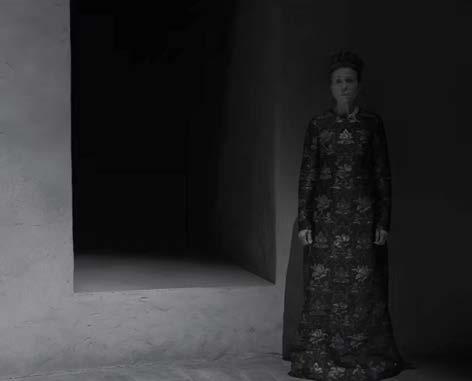
Come on. Gentle my lord, sleek o’er your rugged looks. Be bright and jovial among your guests tonight.



Thou know’st that Banquo, and his Fleance, live. And in his royalty of nature reigns that which would be feared. ‘Tis much he dares; And to that dauntless temper of his mind he hath a wisdom that doth guide his valor to act in safety. There is none but he whose being I do fear.


Be innocent of the knowledge, dearest chuck, till thou applaud the deed.
What’s to be done?
92
As
the
assassins leave, Lady Macbeth enters the room....
The idea of having a spotlight-like light coming through the oculus is carried forward but here as opposed to the previous instance, the characters in this scene never stand at the center of the spotlight, as if they are trying to hide their dark intentions.
My lord, his throat is cut: That I did for him. Most royal sir, Fleance is escaped.

This idea of using water leaking through the oculus is similar to what was done by Orson Welles in ‘Macbeth’, which is to symbolically portray Macbeth’s panic and fear because of his failing plans.



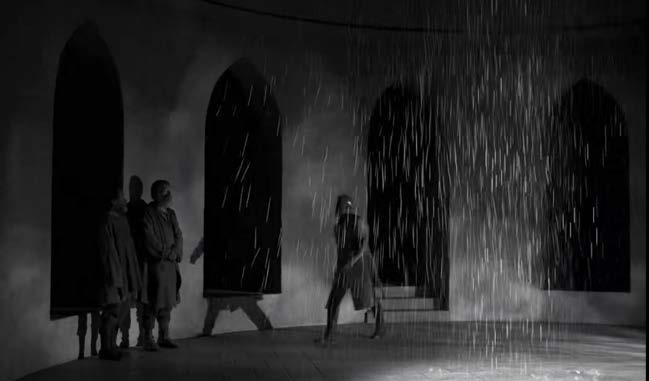
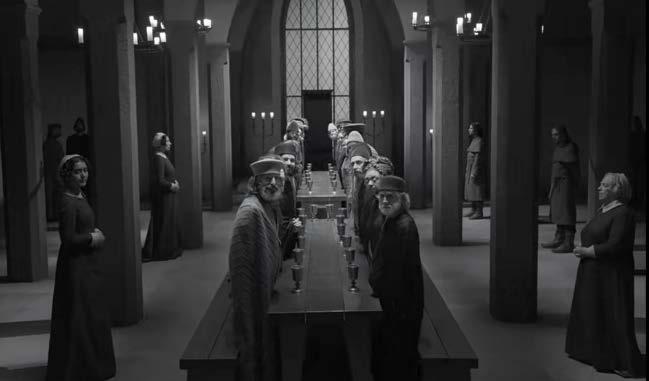
There’s blood upon thy face. ‘Tis better thee without than he within. Is he dispatched?

Then comes my fit again. I had else been perfect; whole as the marble, founded as the rock, as broad and general as the casing air. But now I am cabined, cribbed, confined, bound in—

93
Macbeth and Lady Macbeth go to the Dining hall where they address their guests....
A servant enters the room signaling to him that the Murders(Assassins) have returned...
There the grown serpent lies; the worm that’s fled hath nature that in time will venom breed, no teeth for th’ present. Get thee gone.


Now good digestion wait on appetite, and health on both. Here had we now our country’s honor roofed were the graced person of our Banquo present— Who may I rather challenge for unkindness than pity for mischance.

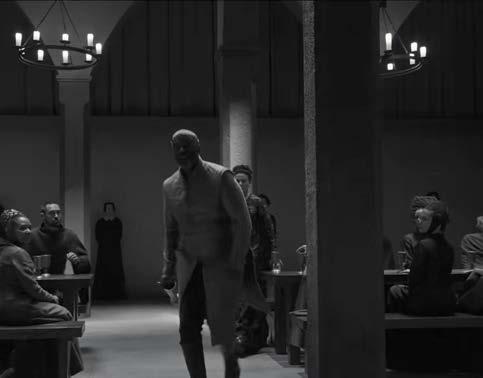
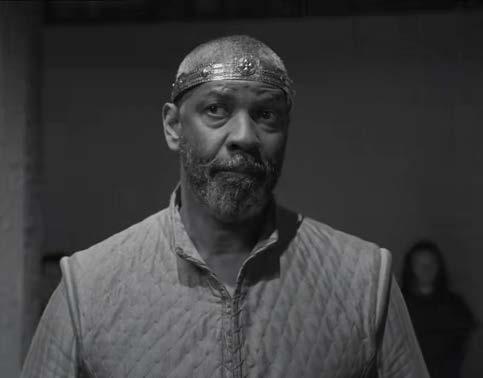

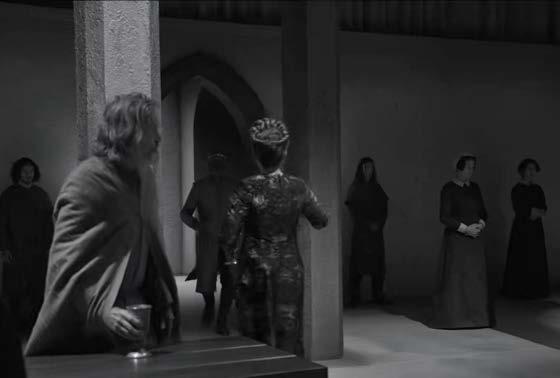

94
TAP!TIP! TAP! CLINGGG! Macbeth throws his glass of wine and starts following Banquo’s ghost, while others are puzzled as they can’t see ghost.....
What, quite unmanned in folly?
Are you a man?
Ay, and a bold one, that dare look on that Which might appall the devil.
The time has been that, when the brains were out, the man would die, and there an end. But now they rise again, with twenty mortal murders on their crowns.
The sound of the wings begins to get louder along with a thumping noise from a room towards the end of the hall...






The time has been that, when the brains were out, the man would die, and there an end. But now they rise again, with twenty mortal murders on their crowns.


CREEKK!
95
Why so, being gone, I am a man again.




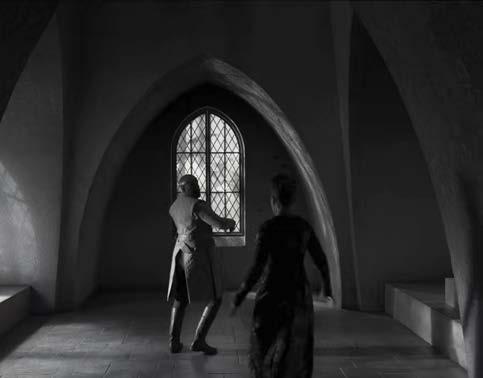



96
Lady Macbeth and the other guests are perplexed to see Macbeth fighting with a raven....
AVAUNT AND QUIT MY SIGHT! LET THE EARTH HIDE THEE! THY BONES ARE MARROWLESS.
Do not muse at me, my most worthy friends: I have a strange infirmity, which is nothing to those that know me.
I pray you speak not: he grows worse and worse; Question enrages him. At once, good night. Stand not upon the order of your going, but go at once.
The guests leave following Lady Macbeth’s orders, leaving both of them alone in the room...

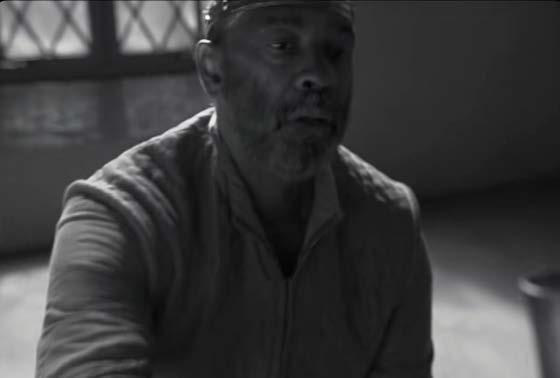





What is the night?
Almost at odds with morning, which is which.
My strange and self abuse is the initiate fear that wants hard use.
It will have blood, they say: blood will have blood. Stones have been known to move and trees to speak; Augurs and understood relations have by the magpies and crows and rooks brought forth the secret’st man of blood.
You lack the season of all natures, sleep.
Come, we’ll to sleep.
The emptiness of the room is a metaphor for the emptiness in his life and the unfruitful pursuit of trying to save his throne.
We are yet but young in deed.

97
Sequence 3.14: Maqbool (2004)




The ordeal begins at Abbaji’s haveli (mansion). We see Maqbool is praying in the bedroom where Abbaji used to stay along with Nimmi. Visibly annoyed, Nimmi enters the room and sits on the rocking chair waiting for Maqbool to finish his prayers...


The room is filled with mild diffused light coming from the open door and the glass pane in the other door that is closed. The light condition compliments his clarity and conviction in his plan, which is to kill Kaka and his son Guddu.
Miyan... Miyan, don’t feed the serpent it’ll turn on you.
The only way Guddu will enter this house in the evening... is over my corpse...
Here, we see Maqbool sitting on Abbaji’s chair (which shows that he has now assumed Abbaji’s position as the leader of the gang) talking to other Gang members and politicians. The scene is lit from above which makes the light quality in this scene a little grim and accentuates the shadow around the eyes making them look intimidating.
Wait till the evening, darling...
I am not assuming command by force, anyone wants to say anything, say it now
98
You’ll be the first to be bitten. Are the Niyaz preparations over?
the way, Kaka gets down to pray and take

from a small shrine on the edge of the road. When Kaka takes
long to get back, Guddu goes to check and finds that Kaka







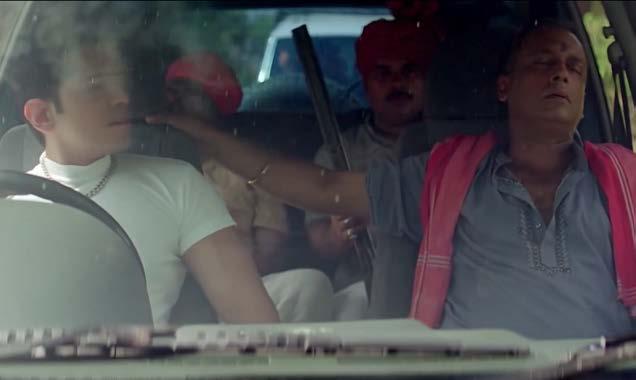
been
is under attack...
99
Meanwhile,
Guddu
and
Kaka are
on
their way to
the
Haveli (mansion) to attend Abbaji’s niyaz ceremony... On
blessings
unusually
has
shot and even he
Isn’t
Kaka asking for a bit too much today?
Look Miyan...
We all have faith in you Palekar has been waiting for this day
One misunderstanding
amongst us and the govt. will collapse
PHFOOM! PHFOOM!
Meanwhile, the proceeding at the haveli (mansion) begin...




In the frame, we can see Maqbool sitting right next to the Kazi in the first row, right in the center, and only his reflection is visible in the large mirror hanging on the wall in front of him. This may signify that he is selfreflecting in his prayer.



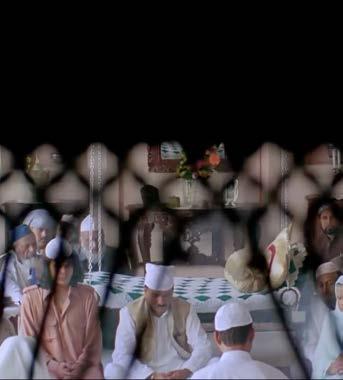

100
Somehow Guddu manages to escape and run away, but Kaka dies...
Who do you think it was? That bastard he’d brought up.. who else?
At first, Maqbool acts as if he is sad and angry about this, but then he suddenly has a hallucination that kaka

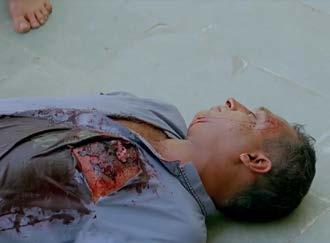









still alive
is staring at him.
Out of utter shock and fear,
right back inside the
The
of feeling safe
the house makes him
Take him away..
alive. Take him away right now... he’s opening his eyes

101
The
prayer is interrupted when Pandit
and
Purohit enter
with Kaka’s
dead body....
is
and
Maqbool jumps
passage and starts screaming...
tendency
inside
jump back inside instead of going in any other direction. MIYAN..! Who was it?
Guddu..!
He’s
Ahaaa!!
Soon after his meltdown at the party, Macbeth sits at the table distraught with himself. Then in a fit of rage, he runs atop the inclined edge and calls forth the three witches to answer his plight.


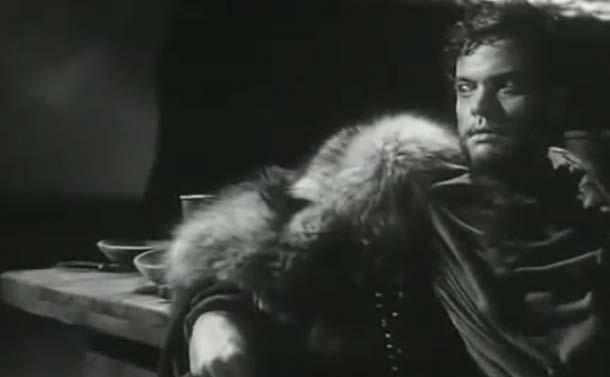
Howe’er you come to know it, answer me.
More shall they speak; for now I am bent to know, by the worst means, the worst.
How now, you secret, black, and midnight hags! I conjure you, by that which you profess.
Though you untie the winds and let them fight against the churches;
*WINDBLOWING*
Though the yesty waves confound and swallow navigation up;
This steep and rocky edge on top of which he stands, is the only thing seen in the frame, isolating him from the rest of the castle.



Simultaneously, the weather begins to worsen, with stormy winds along with thunder and lightning in the background, making the atmosphere frightening and exhilarating for the audience.

102
Sequence 4.11: Macbeth (1948)
*WIND BLOWING*







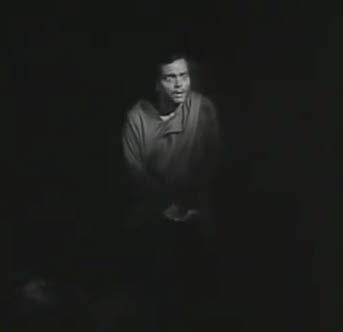


103 In this lightning, we see the shadow of both, the dry tree (that is symbolically associated with the witches) as well as a crucifix. *THUNDER!* *THUNDER!* *THUNDER!* The violent storm suddenly subdues and we hear the witches coming up with their second prophecy.... Though palaces and pyramids do slope their heads to their foundations; Though the treasure of nature’s germens tumble all together, even till destruction sicken; even till destruction sicken; Macbeth! be bloody, bold, and resolute; laugh to scorn the power of man; for none of woman born shall harm Macbeth. (witches) Macbeth! Macbeth! Macbeth! beware Macduff;(witches) He’s fled to England. But I’ll reach him still; give to the edge o’ the sword his wife, his babes..... That will never be. ...and all unfortunate souls that trace him in his line. Macbeth shall never vanquish’d be until Great Birnam wood to high Dunsinane hill. (witches) Answer me! Though bladed corn be lodged and trees blown down; Though castles topple on their warders’ heads;
Sequence 4.12: Throne Of Blood (1957)


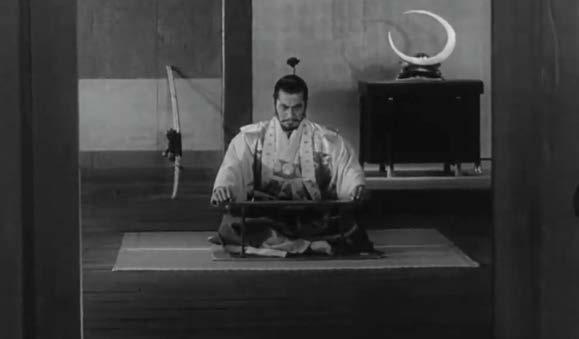
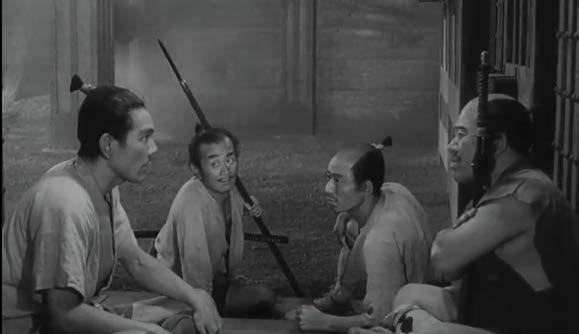


In the ‘Throne of Blood’, the sequence begins in the court near the entrance of the Spider’s web castle. The weather seems as if there is a storm approaching, with torrid winds and the loose volcanic soil flying with it. We see gatekeepers discussing rumors that Miki’s son has formed an alliance with their enemy, Inui, and that the future of the castle now seems doomed...
A fierce wind blows. As if to shake the castle to its foundation .
In any case, we can no longer trust this castle’s invincibility.
The scene cuts to Washizu sitting in his room, when suddenly Asaji’s caretaker comes outside his room to give him the bad news...
I’ve heard tell that Miki’s son has taken shelter with Inui.
Sir...
There is nothing to speak of. My lady has given birth. The child was stillborn.
Speak. Why are you silent?
Speak. Why are you silent?
And lifeless first some days within my lady’s womb, my lady’s health is far from certain.
How is she? My lady, how does she fare?
The partially opened shutter visually communicates Washizu’s emotion that his desire is being contained with him being stuck in the situation.
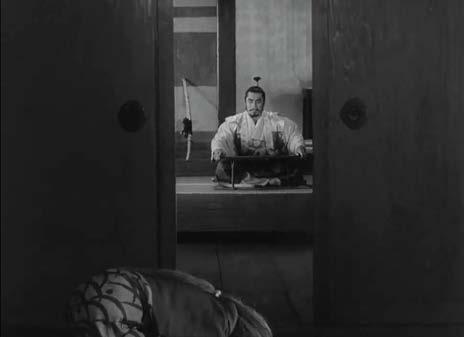
104
Inui’s men swarmed our border, taking the First Fortress. Noriyasu leads the vanguard, swearing vengeance for the prince’s father. The Second Fortress is surrounded. Miki’s son commands them.







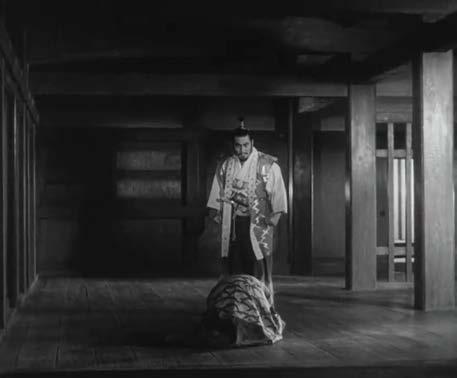
105 Fool! Fool... I’m terribly
drunk.
Washizu then comes out of his room and starts rushing towards Asaji’s room, but he is again stopped by the sobbing caretaker.
Distraught and angry with himself, he sits facing the crown, the raised platform and the sword. Which are the elements in the room that symbolize the throne...
Great
Lord!



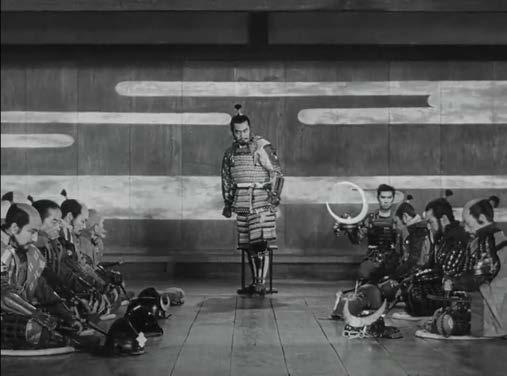




106
First and Second Fortresses are both lost, our foe has joined forces and approaches the Third Fortress.
Cowards. It is two hours since I called council. How can we greet this attack?
Enough with you! What need for the advice of cowards, who quake and pale under fire?
Bring my horse. My horse!
Suddenly lightning strikes, which acts like a call to Washizu from the evil spirit..
Damn you. Answer me plainly. Is it true Miki’s son will be Lord of Spider’s Web?

So I see, you have finally come to the end of your wanderings. You have done well. You may set your fears to rest. Until the very trees of Spider’s Web Forest rise against Spider’s Web Castle, you will not be defeated in battle.
If you choose the path of bloodshed, then climb to the very pinnacle of evil.
If you choose to build a mountain of corpses, build its summit as high as you dare.

I’ll lay a fresh mountain of corpses over these bleached bones. A deluge of blood shall stain these woods crimson.








107
Is this not the Great Lord of Spider’s Web Castle?
Come forth. Evil spirit! Evil spirit! Come forth!
The Tragedy Of Macbeth (2021)

At the end of the previous sequence, Macbeth is sedated and put to sleep by Lady Macbeth. When he gets, up he sees the three witches sitting on what looks like juxtaposed beams on the walls that form the court.





The courtyard of this room is disturbingly deep, with no openings on the wall around. This along with the overcast weather outside, work in tandem to create an atmosphere that is intimidating and frightening at the same time.
I conjure you by that which you profess, howe’er you come to know it, answer me. Even till destruction sicken, answer me, to what I ask you.
By the pricking of my thumbs, something wicked this way comes.
Speak. Demand. We’ll answer.

108 Sequence 4.13:
Double, double toil and trouble, fire burn and cauldron bubble.

The witches use the room as an architectural metaphor for a cauldron by filling it up with water, which was used as a mystical element in the previous sequences as well.




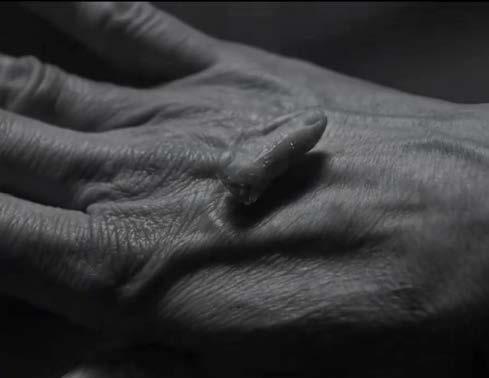


109
Finger of birth strangled babe ditchdelivered by a drab!
The witches then begin to conjure up a spell to reveal the second prophecy to Macbeth. For that, they suddenly fill up the room with water while simultaneously reciting incantations...
BLUP! SPLASH!SPLASH!
Tell me, thou unknown power—

Whate’er thou art, for thy good caution thanks: Thou hast harped my fear aright. But one word more—Macbeth, Macbeth, Macbeth, beware Macduff, beware the Thane of Fife.

Macbeth, Macbeth, Macbeth— Be bloody, bold, and resolute. Laugh to scorn the pow’r of man, for none of woman born shall harm Macbeth.
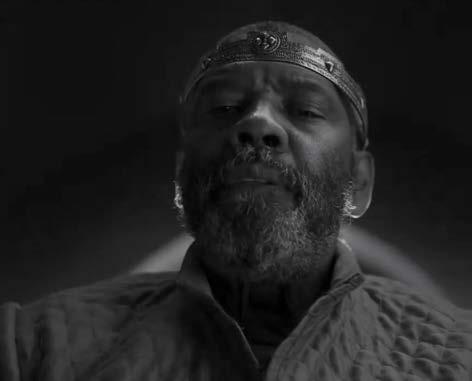
Then live, Macduff, what need I fear of thee? But yet I’ll make assurance double sure and take a bond of fate. Thou shalt not live, that I may tell pale-hearted fear it lies and sleep in spite of thunder.

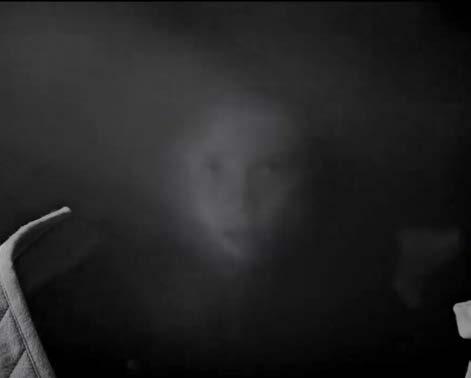


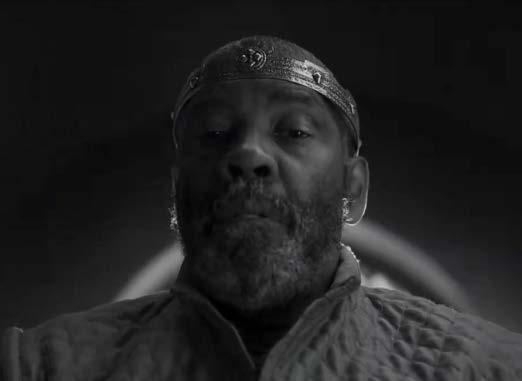
Macbeth shall never vanquished be until Great Birnam Wood to high Dunsinane Hill shall come against him.
That will never be. Who can impress the forest, bid the tree unfix his earthbound root? Yet my heart throbs to know one thing more. Tell me, if your art can tell so much: Shall Banquo’s issue ever reign in this kingdom?
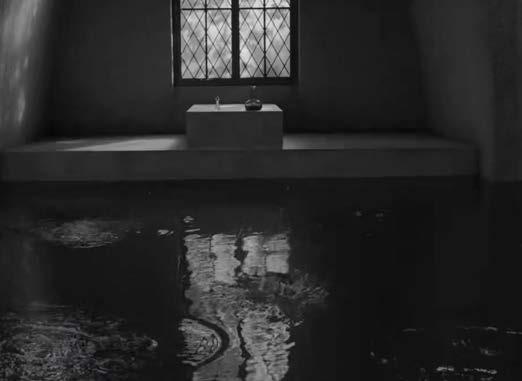
110
Once the witches are done with their business there, they suddenly disappear, and along with them goes the water through the grout of the flooring (as if it were a drain).
Seek to know no more.
The dark gray clouds steer away, infusing the room with bright diffused natural light which looks divine. This clear sky and light signifies the clarity of thought and assurance in Macbeth’s mind regarding what he must do next.



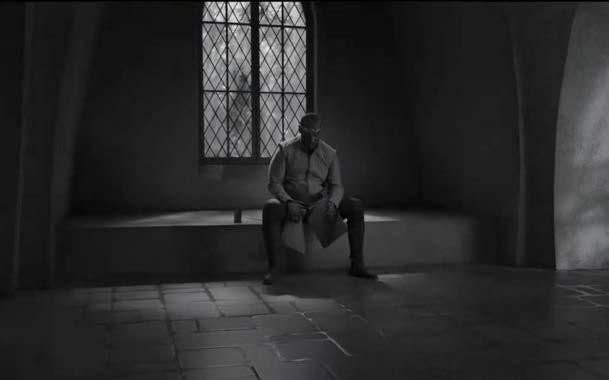




111
Maqbool (2004)
Maqbool gets a call from his man, Chinna, that his men and his business are in danger as Guddu and Riyaz, a member of his gang (Macduff) have allied with the rival gang and have turned against him. Meanwhile, Nimmi begins to keep up at night as the guilt of killing Abbaji begins to get the better of her.
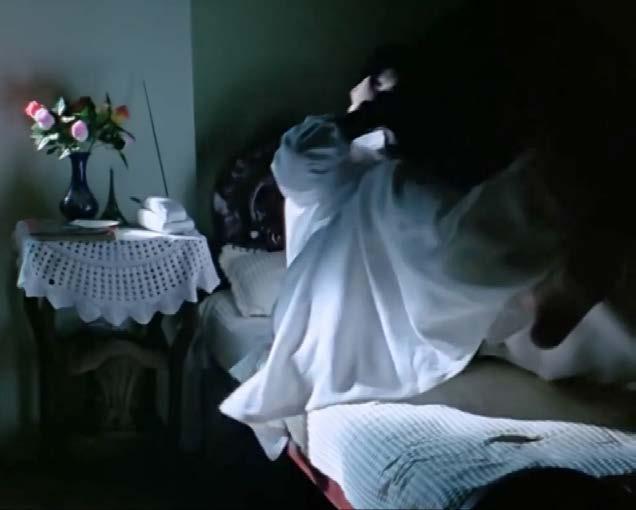

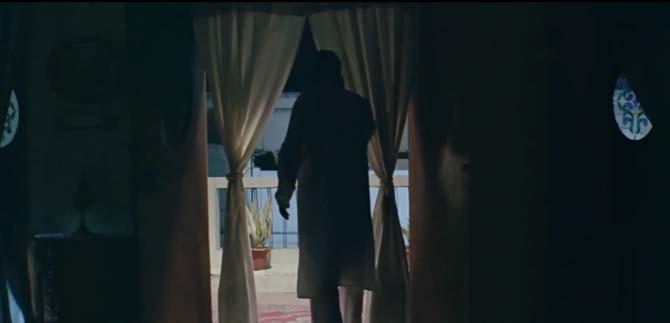

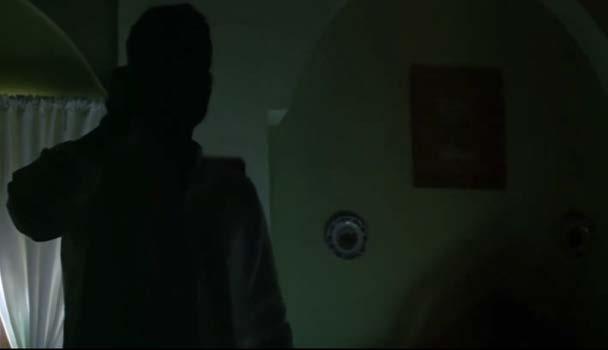
Miyan.. Miyan.. Thana, Panvel, Kalba, Ambarnath each and every district has been targeted... Tavde’s dead too...
Don’t know yet. Bhosle’s also... Bhosle’s screwed. 15 of his party members have gone missing he’s asked for you at once...
Since Maqbool is worried about Nimmi’s whereabouts, he pays no heed to the guy on the phone. And in the end, the man from the rival gang standing next to Chinna, shoots and kills him.
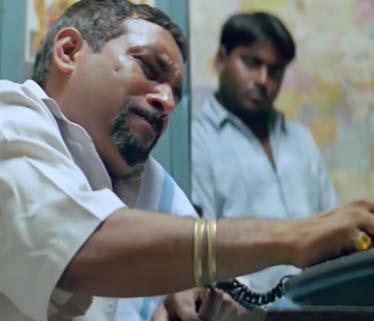
112 Sequence 4.14:
Who was it? Nimmi!...
What
Nimmi sits next to parapet’s edge, presumably contemplating jumping and committing suicide. Throughout the film the terrace becomes a safe and secluded place and also symbolic as a place where Nimmi and Maqbool’s relationship arc develops.
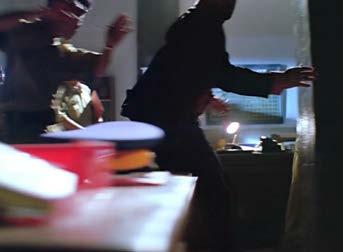
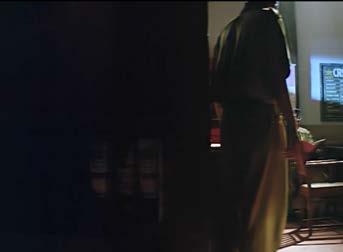




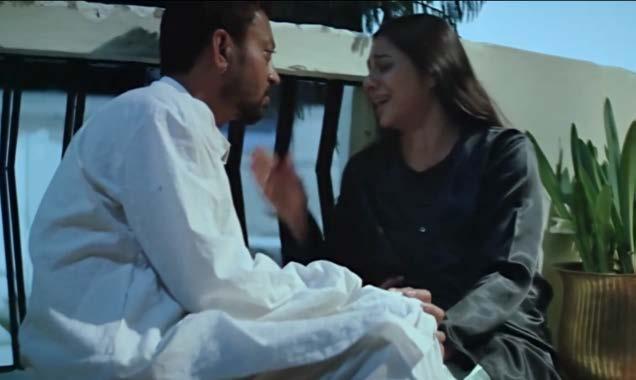
After all, we killed its father.

Maqbool then goes to his gang member and political party leader Vikas Bhosle, who tells him that he would need 3 crores to save their falling party. Maqbool tells him that he cannot arrange that large a sum in such a short period. Bhosle insults and threatens him, that if he shall fail to do so, he would be the first to go to jail. Maqbool furiously storms into the police station where he meets Pandit and Purohit beating a suspect in the jail...

113
Maqbool finds Nimmi sitting next to the parapet on the terrace outside
their room....
It’s father is still alive! This baby is mine. Understood... mine!
happened, Nimmi? This.. (pointing towards the child in her womb) Who..? Don’t harass my dear wife now get back to sleep like a good baby.. Doesn’t let me sleep He won’t sleep Keeps wailing all the time
Miyan.. you
Purohit

shoots the
a



This guy just doesn’t speak up.. Let me ask him in front of you, Miyan...
of
find
Boti and Guddu are not kids It’s all the moon’s fault, Miyan. Everything has gone haywire in the last two months... There’s supposed to be an eclipse in three days time... as long as that passes....


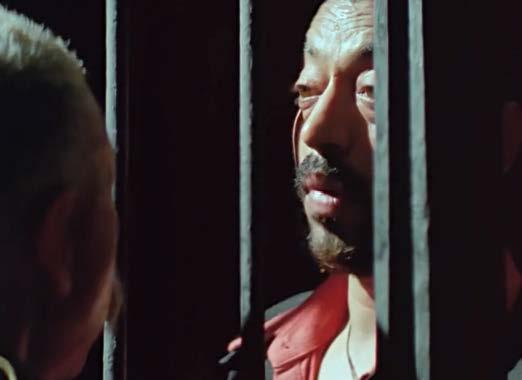
114
here! You should have just called for me... Who
has tried
to mess in Maqbool’s domain? I have no clue, Miyan, honestly..
Who was it? Miyan.. Miyan.. We’ll
out soon Miyan...
eventually
suspect in
fit
rage...
I need 3 billion.. ... before your eclipse appears.

How much..?
There hasn’t been such an eclipse for 80 years now Many big boys drowned then.
How can you sink Miyan? The police are with you. Bhosle’s backing you up that leaves Guddu and Boti...
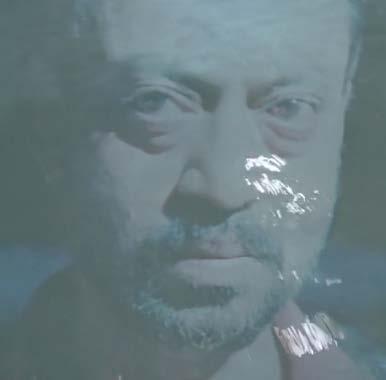

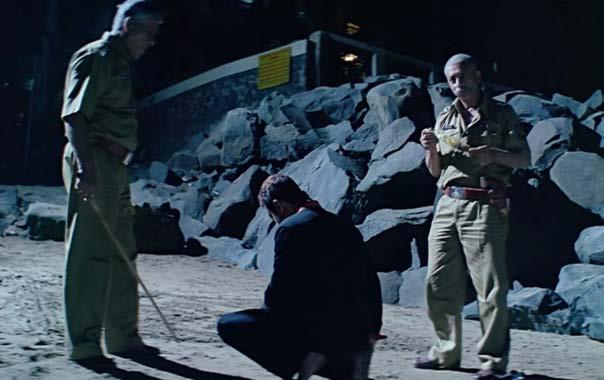


They convince Maqbool that he is safe and that he would ‘drown’ (die) only if the sea itself comes to his house to get him, and they also suggest him to ‘enter\invade the sea’s house’ (to trade and bring in goods through the sea). The place that they are sitting at this point is the beach, on the edge between the sea and land. Throughout the film we are conveyed that ‘fire should always have the fear of water’ and ‘the balance of power shall prevail’. Throughout the film, Maqbool has been associated with fire, so when in the next scene he plans to smuggle through the sea ( after being insisted by Pandit and Purohit), he gets caught since that is not his comfort zone.
The sea will come to drown you....
Before it comes to you, you crash into the sea.
115
Will I sink or sail?
Will I sink or sail?
Sequence 5.11: Macbeth (1948)







The guilt of murdering Duncan begins to affect Lady Macbeth as she starts sleepwalking in the castle through the night which makes her servant worry for her. The servant is eventually compelled to call a doctor to understand why she has been behaving in such a strange manner.
She has light by her continually; ‘tis her command. You see, her eyes are open. /Ay, but their sense is shut.
How came she by that light?
Yet here’s a spot.
Lo you, here she comes! And, upon my life, fast asleep.
Look, how she rubs her hands. It is an accustomed action with her, to seem thus washing her hands.
Out, damned spot! out, I say! One: two: why, then, ‘tis time to do’t.
Hell is murky! Fie, my lord, fie!
This is also the first time that we are shown the space next to the stairs. It is because of its particular shape and design (which is similar to the ‘Voodoo Macbeth’ play) that the doctor and the caretaker are able to hide behind it and observe her strange and disturbing behavior.
*WINDBLOWING*
Do you mark that? Yet who would have thought the old man to have had so much blood in him.
The thane of Fife had a wife: where is she now? What, will these hands ne’er be clean? No more o’ that, my lord, no more o’that, you mar all with this starting.
116
Here’s the smell of the blood still. All the perfumes of Arabia will not sweeten this little hand. The heart is sorely charged. I would not have such a heart in my bosom for the dignity of the whole body.
In this scene, the emotion has completely changed as compared to Sequences 2.11 and 3.11 where the tower in which Duncan was asleep that night looked aspirational. Lady Macbeth who was astute in the earlier sequence is drowned in doubt and guilt, and the tower is nowhere to be seen because it is now something that she despises. The scene is also filmed in such a way that the steps don’t look as grand as they did in the earlier scenes.


The following scene begins with the images of the castle from a distance. By doing so the director reminds us of the context and the terrain on which the castle is built; a steep rocky hill.


To bed, to bed! Come, come, come, come, give me your hand. What’s done cannot be undone. To bed, to bed!
Wash your hands, put on your nightgown; Look not so pale. I tell you yet again, Banquo’s buried; he cannot come out on’s grave. There’s knocking at the gate:
117
This metal grill is an inverted ‘fishbone’ structure seen first as a window-barrier in Macduff’s castle.
This increasingly pervasive metal configuration embodies features of both the ‘Y’ of the witches’ stave, and the cross (crucifix)38.

38 Davies, Anthony. “Ch 5 Orson Welles’s Macbeth.” Filming Shakespeare’s Plays, Cambridge University Press, Newyork, 1988, p. 96.





118
Lady Macbeth runs out of her room in the tower, towards a secluded edge on the hill....
*GASPS*
*WIND BLOWING*
What is that noise?
It is the cry of women, my good lord.
I have almost forgot the taste of fears; The time has been, my senses would have cool’d to hear a night-shriek.
She should have died hereafter.
There would have been a time for such a word.
*SCREAMING*
Wherefore was that cry?
The queen, my lord, is dead.
As Macbeth speaks, the screen fades into the clouds....
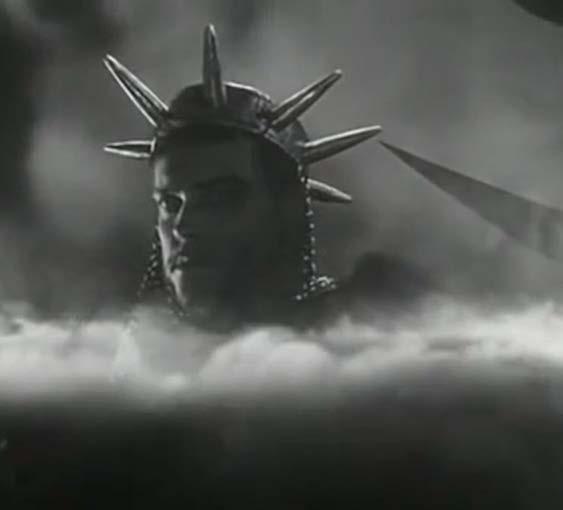




To-morrow, and to-morrow, and tomorrow, creeps in this petty pace from day to day to the last syllable of recorded time, And all our yesterdays have lighted fools the way to dusty death.
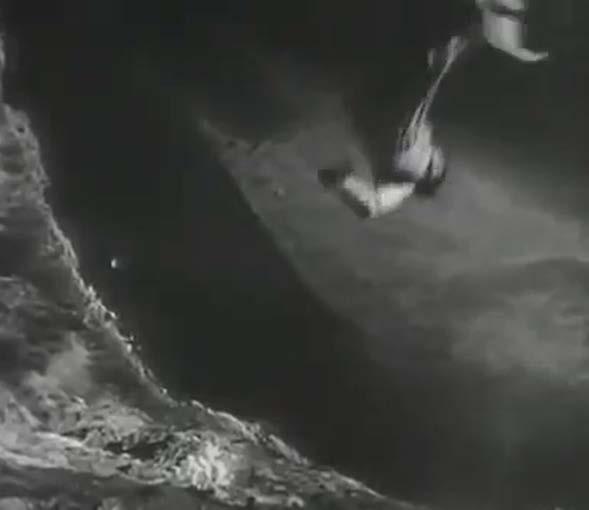
119
AAAAAAAAAA!!!
Sequence
Throne Of Blood (1957)







It is late in the night and Washizu, along with his commanders are sitting in a hall anticipating the enemy to strike, when suddenly a large flock of birds enters the castle...
Birds entering the castle indicates that the enemy have started cutting the forest. It is assumed that the castle was built using wood from the same forest, thus when those trees are cut it is as if the birds are reclaiming the wood that was provided by the forest. It symbolically portrays how nature takes over man’s creation.
What is it? Is it a covert attack?
No doubt they’ve abandoned their attack to build defenses. Even the formidable Noriyasu has no power against these legendary fortifications. The attackers can see nothing inside the castle. Yet we have a bird’s-eye view of them. If they do attack us, let them draw near and then shower them with arrows.
120
5.12:
*FLUTTERING* *FLUTTERING* *FLUTTERING*
What is it?
Commanders of cowardice who quake and pale.
Do you not see this as good omen? How dare you let an auspicious omen of our victory fluster you.
An ill omen...
As Washizu and his commanders are sitting in the hall anticipating the enemy to strike, suddenly Washizu hears the sound of wailing women. He gets up and quickly walks inside to investigate...








121
The camera captures his movement from outside the corridor which frames Washizu through the wooden frame. This is another way through which the director shows Washizu’s feeling of being stuck and enclosed as if the walls have begun to close in on him. The shape of the frame also becomes symbolic of the surrounding trees in the Spider’s web forest which is where the evil spirit resides.





Along the way, he collides with a group of women who are visibly horrified by what they have encountered...
When he reaches the room, he finds Asaji’s caretaker, looking at Asaji on the other side of the cloak hung from the hanger.
122
The room here is brightly lit because Asaji is trying to make sure that there is no spot of blood left on her hand as she vigorously washes them. The brightness also indicates that she has realized her mistake and she doesn’t care about hiding her guilt anymore.






It won’t come out. What an awful bloodstain. No matter how I wash it, why won’t this blood wash away?
It reeks of blood even now. Why can I not clean this blood from my hands? What is the matter with this blood? The stain will not leave my hands.
Asaji...
Washizu tries to talk to her but she keeps on washing her hands and repeating her words....


123
Wahiszu removes the cloak and is shocked to see Asaji washing her visibly clean hands in a large bowl of water...
Sequence
The Tragedy Of Macbeth (2021)
The sequence in ‘The tragedy of Macbeth’ begins with sleepwalking Lady Macbeth standing on the edge of the hill near the castle, as she is facing the opposite side. We are then shown the doctor along with one of Lady Macbeth’s caretakers explaining and showing him how Lady Macbeth has been sleepwalking around for a few nights.


The arched opening perfectly frames her in this still, highlighting her position as well as the verticality of the setting.



124
5.13:
When was it she last walked?
In this slumbery agitation, besides her walking and other actual performances, what, at any time, have you heard her say?

When Lady Macbeth reenters the castle with a candle in her hand, it is her shadow that enters the frame before she does, which appears like an eerie witch-like silhouette.





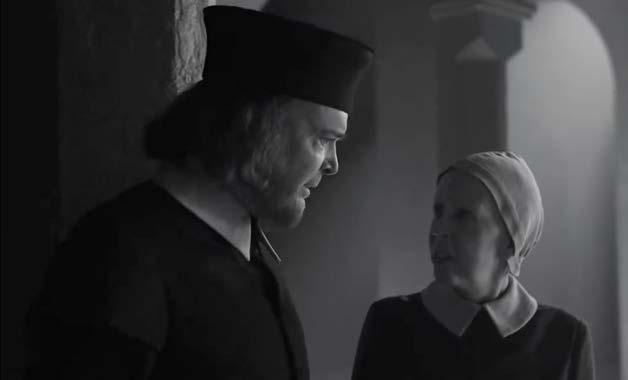
Since His Majesty went into the field, I have seen her rise from her bed, throw her nightgown upon her, unlock her closet, take forth paper, fold it, write upon it, read it, afterwards seal it, and again return to bed. Yet all this while in a most fast sleep.
Look you, here she comes.
What is it she does now?
That, sir, which I will not report after her Neither to you nor anyone, having no witness to confirm my speech.
Look, how she rubs her hands. I have known her continue in this a quarter of an hour.

125
Yet here’s a spot. Out, damned spot. Out, I say. One… two. Hell is murky.


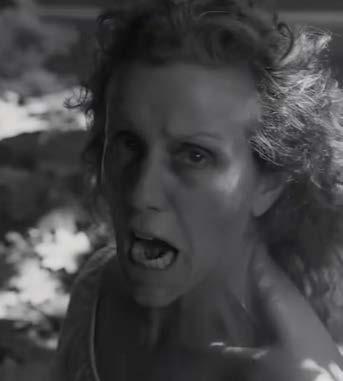


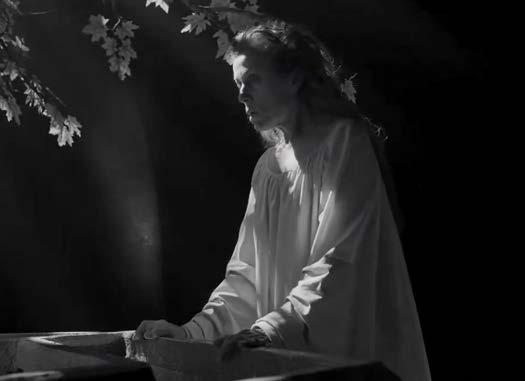



The Thane of Fife had a wife. Where is she now?
The court has a maple tree at the center, and around it is a channel that contains water where she goes to wash the blood off her hands. The peculiar thing here is that the light is actually falling from two directions. First, we see Lady Macbeth coming down from the steps and we can see a clear patch of stark light in which we see her shadow. However, when she goes down to the court which is on the opposite end, the court is also lit and this time the light is coming from the opposite end. This further highlights the fact that the setting here is far from realistic and its sole purpose here is to back the story and to highlight the emotions.
She has spoke what she should not. I am sure of that.
126
What need we fear who knows it, when none can call our power to account?
AGAHHHH!
What? No more o’ that, my lord, no more of that. Go to, go to. You have known what you should not.
Here’s the smell of the blood still. All the perfumes of Arabia will not sweeten this little hand.
This disease is beyond my practice. Yet I have known those which have walked in their sleep who have died holily in their beds.
God, God forgive us all.
To bed.
Wash your hands, put on your nightgown. Look not so pale. I tell you yet again, Banquo’s buried. He cannot come out on’s grave. Foul whisperings are abroad.


There’s knocking at the gate. Come! Come! Come, come. Give me your hand. What’s done cannot be undone.

The doctor and the caretaker, scared by her glare, look on as Lady Macbeth walks up to her bedroom...
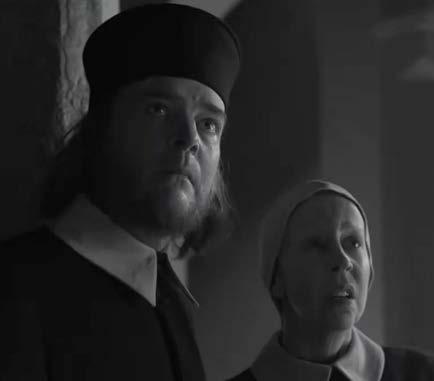


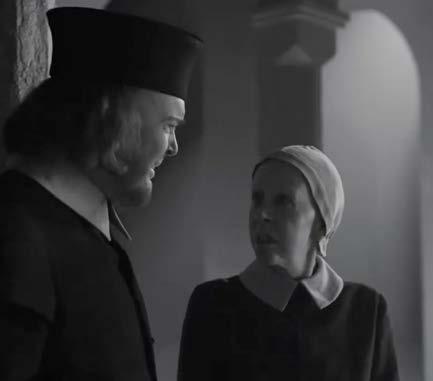

127
The next day while Macbeth is busy maneuvering his troops for the battle against Macduff and his army, Lady Macbeth gets up from her bed begins to sleepwalk again...
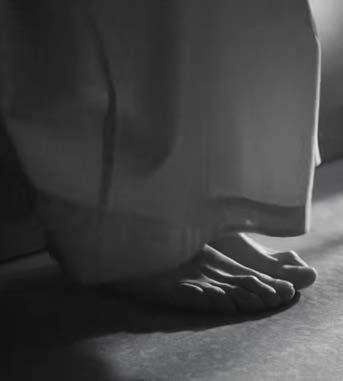



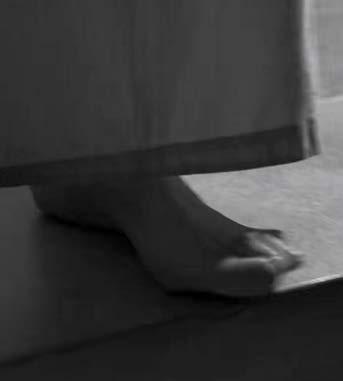
She walks up to the edge of the staircase and stops... It is then that one of the kingdom’s council members sees her and slowly walks up to her....


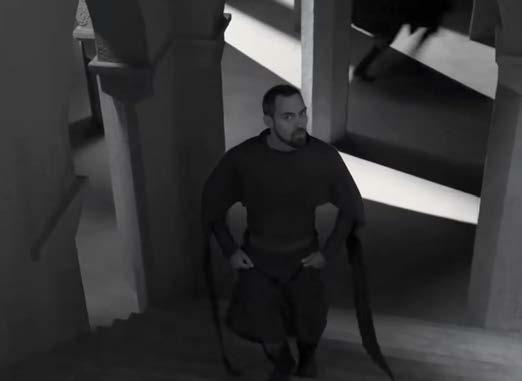
The room is lit in such a way that one cannot see anything more than what is necessary for the scene, which in this case is the bed.
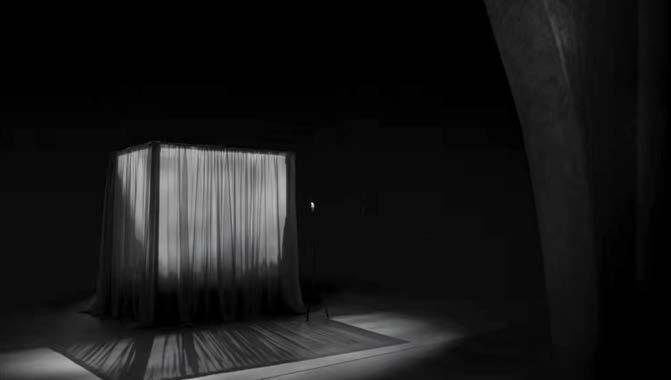
128
Wherefore was that cry?!


What is that noise?
It is the cry of women, my good lord.
I have almost forgot the taste of fears. The time has been my senses would have cooled to hear a night-shriek, and my fell of hair would at a dismal treatise rouse and stir as life were in’t.
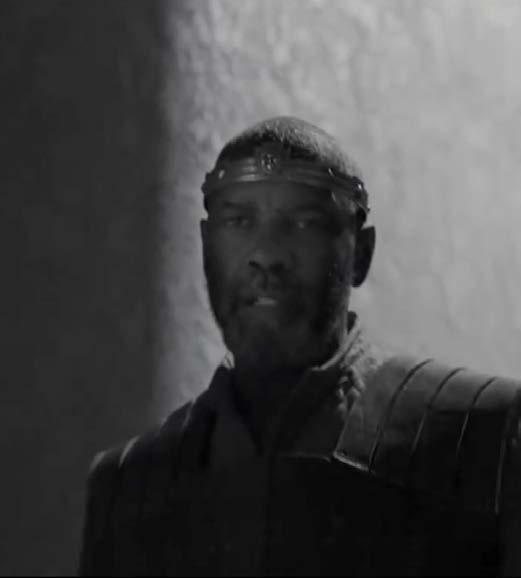

The queen, my lord, is dead.
She should have died hereafter: There would have been a time for such a word. Tomorrow, and tomorrow, and tomorrow creeps in this petty pace from day to day to the last syllable of recorded time, and all our yesterdays have lighted fools the way to dusty death. Out, out, brief candle, life’s but a walking shadow, a poor player that struts and frets his hour upon the stage and then is heard no more. It is a tale told by an idiot, full of sound and fury, signifying nothing.
Here, while Macbeth stands leaning on a column in the dark corner of the landing, Lady Macbeth lays lifeless on the floor, covered in warm and subdued light as though she has finally found peace.

129
The scene again cuts back to the action at the rampart....
Sequence

Maqbool (2004)
When Maqbool finds out that he is in trouble and either the navy or Guddu will hunt them down, he takes Nimmi back to his farmhouse from the hospital even though she is unwell after having had a premature delivery. The sequence begins from the point when Maqbool reaches the farmhouse with Nimmi. As she is still not in a position to walk herself, Maqbool carries her inside.


As he enters the house he hears music coming from the central hall of the house. At first, the room is dark and empty, but then suddenly he sees Abbaji, Usman, and Badi Bi, -all of whom are dead- happily dancing just like they did at Sameera and Guddu’s engagement party....


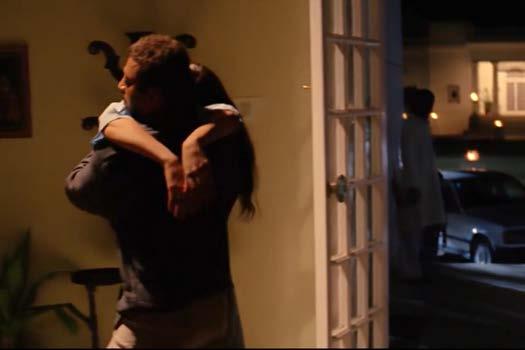
130
5.14:
The pitch dark room, which symbolizes the current dark times, is in stark contrast with the one that Maqbool hallucinates, where the whole room is decorated and brightly lit up for the celebration.




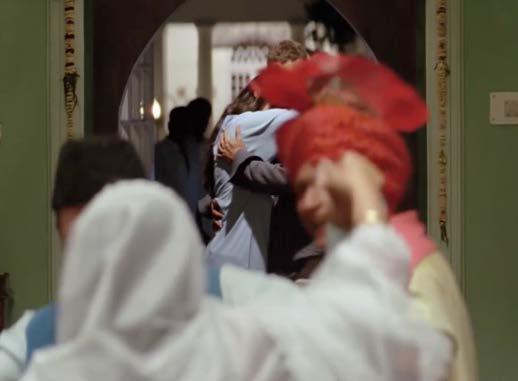


He soon realizes that what he is seeing is just a projection of his guilt-ridden mind and moves ahead....


131
The room’s not been cleaned for ages.. See.. the blood has stained all over the walls..

Coming back to the room reminds her of that night they had killed Abbaji, which makes her uncomfortable. And just like Maqbool, because of her guilt-ridden mind, she begins to hallucinate that the bed sheet and the walls are still covered in blood even though they are visibly clean....







Where?....
Oh God ..even the sheets haven’t been changed.. Let me go... These servants are good for nothing...who is supposed to look after the cleaning up..
Let go Miyan... The stench of blood is all over, let me wash it up It will keep us up all night...
132
Maqbool and Nimmi sit right in front of the mirror as if they were reflecting upon their deeds. The fact that she dies there in his arms in that particular room where they committed their first murder, symbolically completes her character’s emotional arc.


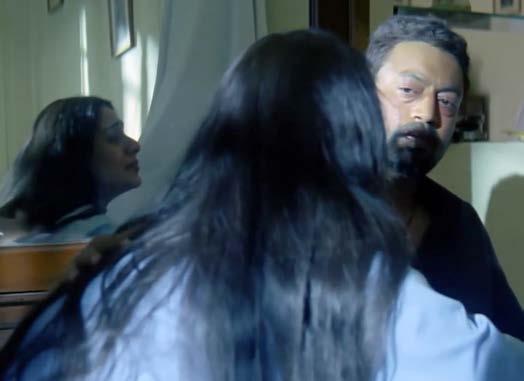

Miyan....was everything a sin..? Our love was chaste, wasn’t it..? Miyan our love was pure, wasn’t it..? Wasn’t it Miyan..tell me.. our love was chaste, right?(sobbing)

Similar to what Orson Welles did with the setting in ‘Macbeth’(1948), Vishal Baradwaj also uses the same setting and this time conveys emotions like hopelessness and despair through it as opposed to the thunderous night in the earlier sequence. The sound of rain and thunder is replaced by utter silence and the thunder and lightning is replaced, initially by the cool moonlight, and later by the mellow morning sun.


133
Maqbool realizes that Nimmi neither has the physical nor the mental capacity to flee from there as her mind has completely been taken over by her guilt.
I’m going mad, aren’t I? Tell me I am going insane, aren’t I?
134
3.12 Hamlet
Sequence 1.2 Hamlet returns home and is disturbed by his father’s untimely death.
Sequence
Hamlet’s meeting with his father’s spirit.
‘To be or not to be’ soliloquy.
Hamlet’s play depicting his father’s murder through the ‘mouse-trap’ play.
Hamlet’s attempt to kill his uncle.
135 —
—
2.2 — Sequence 3.2 — Sequence 4.2 — Sequence 5.2
Sequence 1.21: Hamlet (1948)

The film begins with bird-eye views of the Elsinore castle where the King of Denmark resides. the narrator’s voice tells the audience that this is the story of a man who couldn’t make up his mind. We are told that King Hamlet, Prince Hamlet’s father has died after being bitten by a snake and his younger brother, Claudius has assumed the throne and also married his wife Gertrude within a month of his demise.

The jumbled and complex layout of the castle along with numerous stairs make it look like a labyrinth, which complements Prince Hamlet’s confusion in the film.

Although we are told that this story is set in 17th-century Elsinore, Denmark, the design of the castle has more to do with the need of the play and the character than the architecture of that time and region. The bird’s eye view of the multiple towers metaphorically signifies that ‘looking’ and ‘spying’ are major themes of the film.

136
Ah. And now, Laertes, what’s the news with you?....
You told us of some suit. What is’t, Laertes?....
You cannot speak of reason to the Dane and lose your voice.
What wouldst thou beg, Laertes, that shall not be my offer, not thy asking?
Dread, my lord. Your leave and favor to return to France, from whence, though willingly, I came to Denmark to show my duty in your coronation. Yet now, I must confess, that duty done, my thoughts and wishes bend again towards France and bow them to your gracious leave and pardon.

And now, our cousin, Hamlet, and our son, how is it that the clouds still hang on you?
Good Hamlet... cast thy nighted colour off, and let thine eye look like a friend on Denmark. Do not forever with thy lowered lids seek for thy noble father in the dust.
While these proceedings are going on, a distraught hamlet sits at the other end of the table, still mourning his late father’s untimely death...


Thou know’st ‘tis common. All that lives must die, passing through nature to eternity.

137 Proceedings at the great hall
If it be, why seems it so particular with thee?
sorrow. But to persist in obstinate condolement is a course of impious stubbornness. ‘Tis unmanly grief. A fault to heaven, a fault against the dead. A fault to nature, to reason most absurd, whose common theme is death of fathers and who still hath cried from the first corpse till he that died today, “This must be so. “ Why should we, in our peevish opposition, take it to heart?
Aye, madam, it is common.
Seems, madam?
Nay, it is. I know not “seems”. ‘Tis not alone, my inky cloak, good mother, nor customary suits of solemn black, together with all forms, moulds, shows of grief that can denote me truly. These indeed seem, for they are actions that a man might play But I have that within which passeth show these but the trappings and the suits of woe.
For let the world take note, you are the most immediate to our throne, and with no less nobility of love than that which dearest father bears his son do I impart towards you.
We pray you, throw to earth this unprevailing woe and think of us as of a father.
‘Tis sweet and commendable in your nature, Hamlet, to give these mourning duties to your father. But you must know your father lost a father, that father lost, lost his and the survivor, bound in filial obligation for some term to do obsequious





138
As the proceedings end, King Claudius goes back to his room with Gertrude and so do the rest of the people, Prince Hamlet being the only one staying back.




139
Claudius and Gertrude convince Prince Hamlet to not go back to school in Wattenberg and stay with them in Elsinore.
The sheer scale of the massive columns in the room enhances Hamlet’s feeling of being out of place, overwhelmed and left out. Making him look lonely, helpless and minuscule in the current scenario.






‘Tis an unweeded garden that grows to seed. Things rank and gross in nature possess it merely. That it should come to this. But two months dead. Nay, not so much, not two!
So excellent a king that was to this Hyperion to a satyr. So loving to my mother that he might not suffer the winds of heaven visit her face too roughly. Heaven and earth, must I remember?
Why, she would hang on him as if increase of appetite had grown by what it fed on. And yet, within a month... Let me not think on it. Frailty, thy name is woman! A little month, with which she followed my poor father’s body, like Niobe, all tears or ere those shoes were old.
140
Hamlet’s soliloquy ends and he sits back on his chair, consumed in his thoughts. The camera then pans ahead and zooms into the arched colonnade; towards Ophelia’s room.






Out of all the rooms in the castle, Ophelia’s room is brightly lit since its located on the outer edge of the castle and has a window that looks directly outside, towards the vast green expanse. This is in contrast to the dark and grim spaces in the rest of the castle. This signifies that her character is away and unaware of the treachery and dark deeds being carried out by others living there.
Ophelia talking to Laertes in her room in the next scene.
141
Sequence 1.22: Hamlet (1996)
Kenneth Branagh in his 1996 adaptation of ‘Hamlet’ chose to set it in the 19th century. “In our Hamlet setting is impressionistic. We’re not going for a particular year and particular country. We borrow shapes and images from the Hapsburg and the Romanovs. Just a general sense of a period where large, extended royal families rule Europe, and were always arguing, always changing the borders, and there’s always intrigue and scandal, mad princes. Hamlet is not about 1850 in Russia; it is just a good point to start from.”39

39 Kurtia, Tetiana k. “Hamlet on Screen: William Shakespeare’s Play in Film Adapta tion.” Charles University in Prague – Faculty of Philosophy Institute of Anglophone Literature and Cultures., n.d..pp. 31
The newly wed King and Queen walk up the podium as Ophelia, Polonius and Laertes look-on.

The people have gathered in the great hall for their newly crowned king, King Claudius’s marriage with their Queen Gertrude a month after King Hamlet’s demise.


142
The actors portray their characters at a very high pitch, enunciating and emphasizing every emotion, which might have been done because the source material is a play. And thus the inherent grand and articulate nature of Baroque architecture complemented the film.

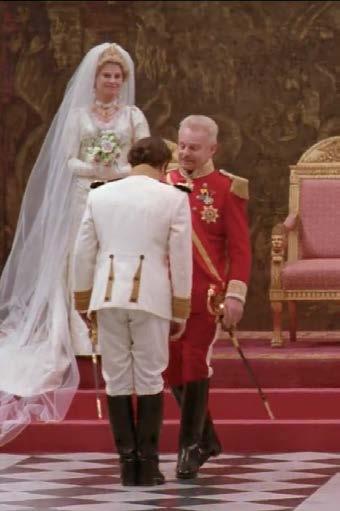
During the proceedings, Laertes asks for the permission of King Claudius to go back to France to continue his studies since he has completed his duties here. And King Claudius graciously allows him to do so if he has the permission of his father, Lord Polonius.


143 Proceedings at the great hall...
While all this is happening, Prince Hamlet (wearing black; mourning his father’s death) quietly stands in the corner behind the curtain, dissociating himself from the celebration.
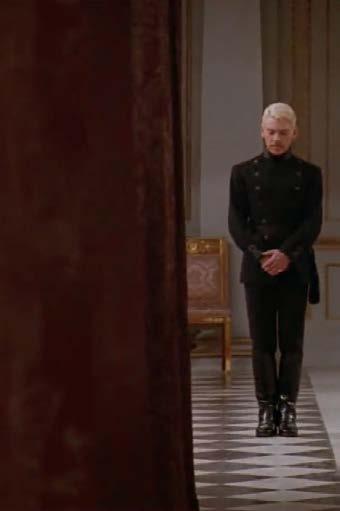



But now, my cousin Hamlet... ...and my son. kind.
[Whispers] A little more than kin, and less than
How is it that the clouds still hang on
you Not so, my lord... ...I am too much in the sun.
Good Hamlet... cast thy nighted colour off, and let thine eye look like a friend on Denmark.

Do not forever with thy lowered lids seek for thy noble father in the dust. Thou know’st ‘tis common.
All that lives must die, passing through nature to eternity.
Ay,madam, it is common.
144
Seems, madam?
Nay, it is. I know not “seems”. ‘Tis not alone, my inky cloak, good mother, nor customary suits of solemn black, together with all forms, moulds, shows of grief that can denote me truly. These indeed seem, for they are actions that a man might play But I have that within which passeth show these but the trappings and the suits of woe.
‘Tis sweet and commendable in your nature, Hamlet, to give these mourning duties to your father. But you must know your father lost a father, that father lost, lost his and the survivor, bound in filial obligation for some term to do obsequious sorrow. But to persist in obstinate condolement is a course of impious stubbornness. ‘Tis unmanly grief.



A fault to heaven, a fault against the dead. A fault to nature, to reason most absurd, whose common theme is death of fathers and who still hath cried from the first corpse till he that died today, “This must be so. “ Why should we, in our peevish opposition, take it to heart? We pray you, throw to We pray you, throw to earth this unprevailing woe and think of us as of a father.
For let the world take note, you are the most immediate to our throne, and with no less nobility of love than that which dearest father bears his son do I impart towards you.
145
Claudius and Gertrude convince Prince Hamlet to not go back to school in Wattenberg and stay with them in Elsinore.



146 PHUFF!... CLAP! CLAP! CLAP! CLAP! *CHEERING*
O that this too solid flesh would melt... ...thaw and resolve itself into a dew... ...or that the Everlasting had not fixed his canon ‘gainst self-slaughter. O God, God... ...how weary, stale, flat, and unprofitable... seem to me all the uses of this world. Fie on’t, ah fie.
So excellent a king that was to this Hyperion to a satyr. So loving to my mother that he might not suffer the winds of heaven visit her face too roughly. Heaven and earth, must I remember?
The checkered flooring in the rooms signify that the characters are always at odds with each other, and just like in a game of chess, they are also trying to outwit one another. Thus, highlighting the theme of conflict that the story explores.







‘Tis an unweeded garden that grows to seed. Things rank and gross in nature possess it merely. That it should come to this. But two months dead. Nay, not so much, not two!
Why, she would hang on him as if increase of appetite had grown by what it fed on. And yet, within a month... Let me not think on it. Frailty, thy name is woman! A little month, with which she followed my poor father’s body, like Niobe, all tears or ere those shoes were old.
147
The proceeding ends and King Claudius goes back to his room accompanied by Gertrude, and so do the rest of the people. But Prince Hamlet is the only one who stays back.
UGHH!!..
The same, my lord,and your poor servant ever.
glad to see thee well. (sigh)
Hail to your lordship!I am
I pray thee do not mock me, fellow student. I think it was to see my mother’s wedding.

Horatio! Or I do forget myself?



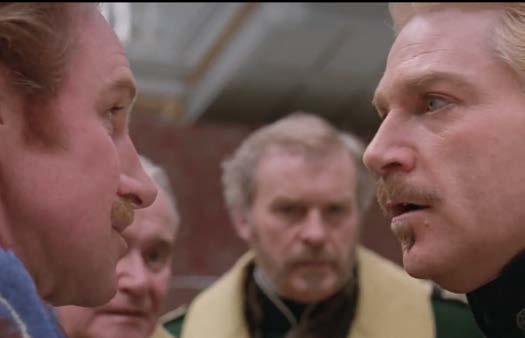


But what is your affair in Elsinore?
My lord, I came to see your father’s funeral.
My lord... ...I think... ...I saw him yesternight. Saw? Who?
My lord, the king... ...your, father.
Indeed, my lord, it followed hard upon.
Season your admiration for a while with an attent ear till I may deliver... upon the witness of these gentlemen, this marvel to you. Two nights together had these gentlemen, Marcellus and Barnardo, on their watch... ...in the dead waste and middle of the night, been thus encountered. A figure like your father...
Thrice he walked by their oppressed and fear surprised eyes... within his truncheon’s length, whilst they distilled...
148
As Hamlet finishes his soliloquy, his friend Horatio enters the hall accompanied by Fransisco and Bernardo (the two guards).
This to me in dreadful secrecy impart they did... ...and I with them the third night kept the watch... ...where, as they had delivered, both in time... form of the thing, each word made true and good... ...the apparition comes.
Did you not speak to it?
My lord, I did. But answer made it none. Yet once methought... it lifted up its head and did address itself to motion like as it would speak... but even then the morning cock crew loud... and at the sound it shrunk in haste away and vanished from our sight.
Although Hamlet isn’t fully convinced, he still decides to go to meet the ghost that night, and asks them to not tell anyone about it.

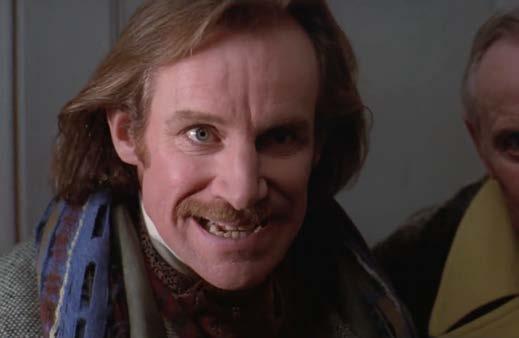
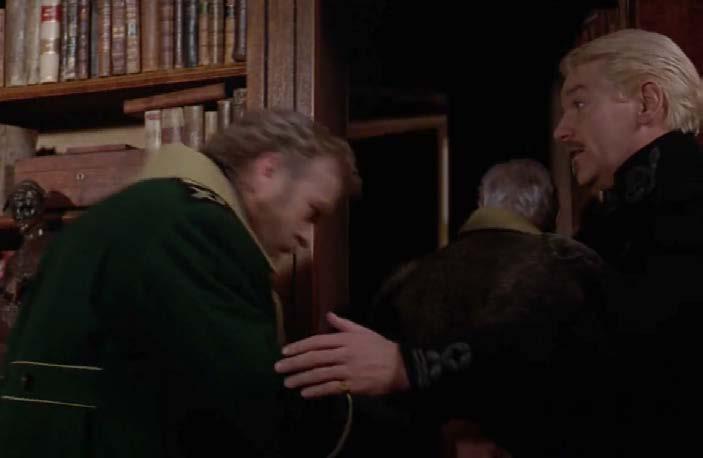

(Fig. 18.34)
Hamlet’s room has bookshelves on almost all walls (one of them is also a secret door) which tells us that he is an avid reader; knowledgeable and constantly ‘thinking’ as a person. This sets a base for his ‘questioning’ and indecisive nature because a person who reads a lot and studies things from different perspectives always has a lot going on in his mind.
In the meantime he starts reading about evil spirits and ghosts from the books he has in his room...

149
Haider (2014)


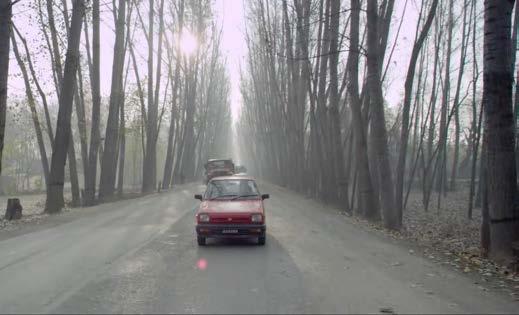

Haider, a student from Allahabad University, returns home after getting to know that his father has been taken into custody by the Indian army for treating a militant in his house.
Here, unlike the earlier adaptations, the architectural setting is not limited to a castle but it is the whole town that is used.
Stop the car.... I want to go home..
In this adaptation, the story is shifted from 17th and 19th century Denmark to Srinagar in 1995. Although the context of the story has been changed, the idea of the setting being in isolation is still very much there because of Kashmir’s geographical and political contexts.
Haider... There isn’t much of a home left in what remains...


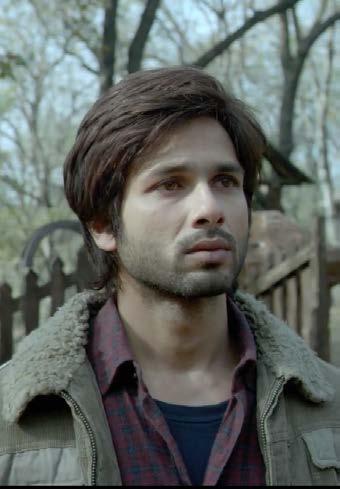

150 Sequence 1.23:
Haider’s house before the army attacked it....
Haider reaches his house and is gutted to look at the lamentable state it is in....


He silently moves around the house in utter shock and dismay....
The fact the house had timber members made it even more vulnerable to the damage caused by the blast as opposed to some other material. Especially the roof, since its structure was predominantly made of timber.


151
While walking around, he gets reminded of the happier times that he had spent in this very house that is now a pile of derbies and ash.

The light quality in these scenes is kept very stark and mystical on purpose. Since Kashmir is a cold place, the sunlight for them brings respite and warmth. And in these scenes, Haider is remembering his happier days and it is through this light that we know that it is the ‘warmth’ that he now longs for.



152
*Singing ‘guloon mai rang bhare’ *




153
The house here symbolically represents his happy childhood and the time he spent with his parents. So when the house is blown to pieces, is as though some one has attacked and shattered his childhood.
Haider picks up whatever remembrances that are left of his father...
*Sobbing*

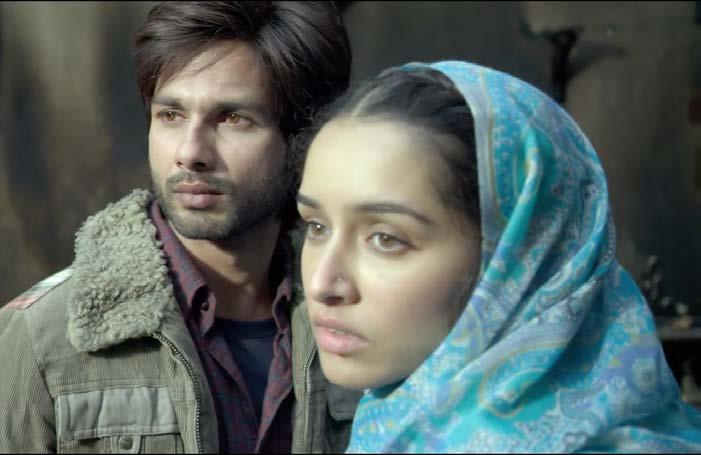


154
While Arshia consoles a weeping Haider, her brother, who doesn’t approve of their relationship enters the scene.
Of course, you couldn’t drop me at the airport.
If I ever see you around her... you will disappear. Just like your father!
Now that is quite an interview!
By just looking at the scale of the house and the court, one can judge that this house is owned by an aristocratic family and was meant to accommodate a lot more people than it currently does.


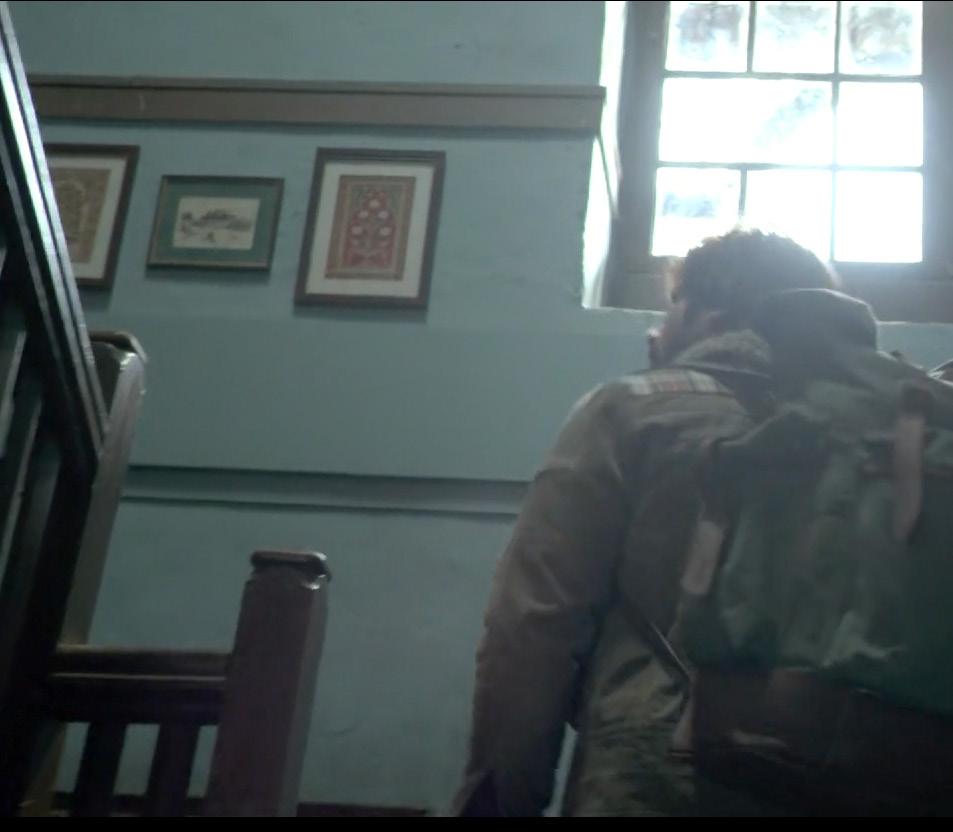


155
Liyaqat forcefully takes Arshia home with him. Haider goes to his ancestral house where Khurram Meer (his uncle) lives, and his mother, Ghazala has shifted after the attack on their house.
Let go of my hand!
Come with me!
Haider enters the room and is shocked to see no sign of sadness or mourning and his mother along with his uncle are happily singing in the ‘dub’(cantilevered balcony) .

The ‘Zoon Dub’( balcony to view the moon) and the room are separated by a translucent curtain, because of which Ghazala and Khurram aren’t able to notice Haider entering the room. However, the curtain is transparent enough for Haider to see through.
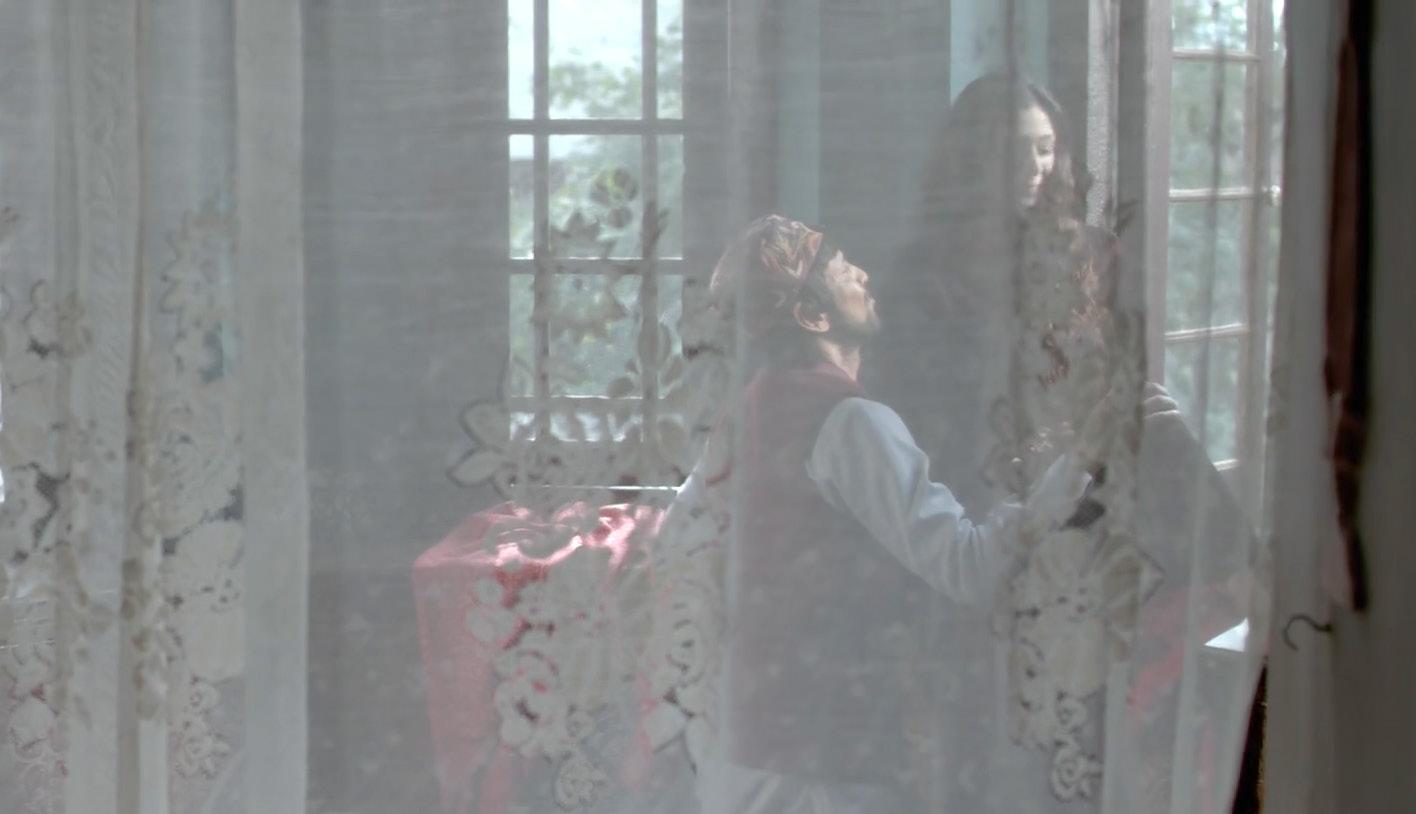
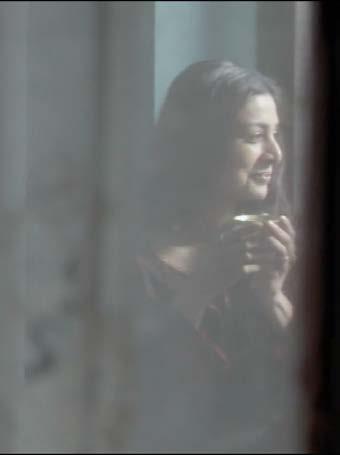


156
Haider angrily leaves the house, while Ghazala runs behind to stop him...





The two of you seem very happy. with,my father’s disappearance. Dear uncle... Has your musical been on for a while? Or did this romantic production begin.. After father’s disappearance?
The way light falls on Haider here puts him in focus and makes him look righteous.

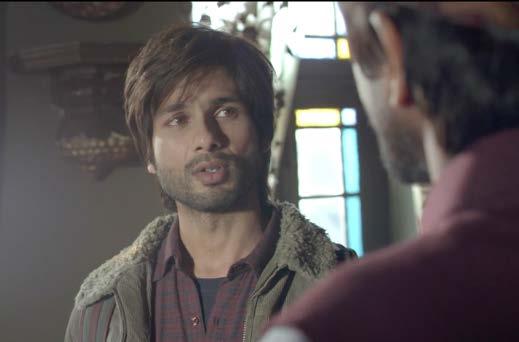
157
Haider.... Jaana(beloved)...
*Sobbing*
Hamlet (1948)


Horatio (Hamlet’s friend) tells Hamlet that he and the other guards had encountered a spirit that seemed like that of his father’s, and that it refused to talk to anyone but Prince Hamlet. Although a little reluctant at first, he agrees to accompany them that night and asks them to not tell anyone about it.

PHOOFF!! BOOMM!!
Hamlet and his accomplices look at other guards celebrating from atop one of the many towers of the castle...

The King doth wake tonight and makes carouse, keeps wassail and the swaggering up spring reels. And as he drains his droughts of Rhenish down the kettle-drum and trumpet thus bray out the triumph of his pledge.
But to my mind, though I am native here and to the manner born, it is a custom more honored in the breach than the observance. This heavy-headed revel east and west, makes us traduced and mocked by other nations.
They call us drunkards. And, with swinish phrase, soil our reputation. And indeed, it takes from our achievements, though performed at height.
So oft it chances in particular men that for some vicious mole of nature in them, by the o’ergrowth of some complexion, oft breaking down the pales and forts of reason, or by some habit grown too much that these men, carrying, I say, the stamp of one defect, their virtues else, be they as pure as grace, shall in the general censure take corruption from that particular fault.
158 Sequence 2.21:
Ay, marry is’t.
Is it a custom?
What does this mean, my lord?
Suddenly the fog becomes even denser and out of nowhere, king Hamlet’s spirit appears before them...


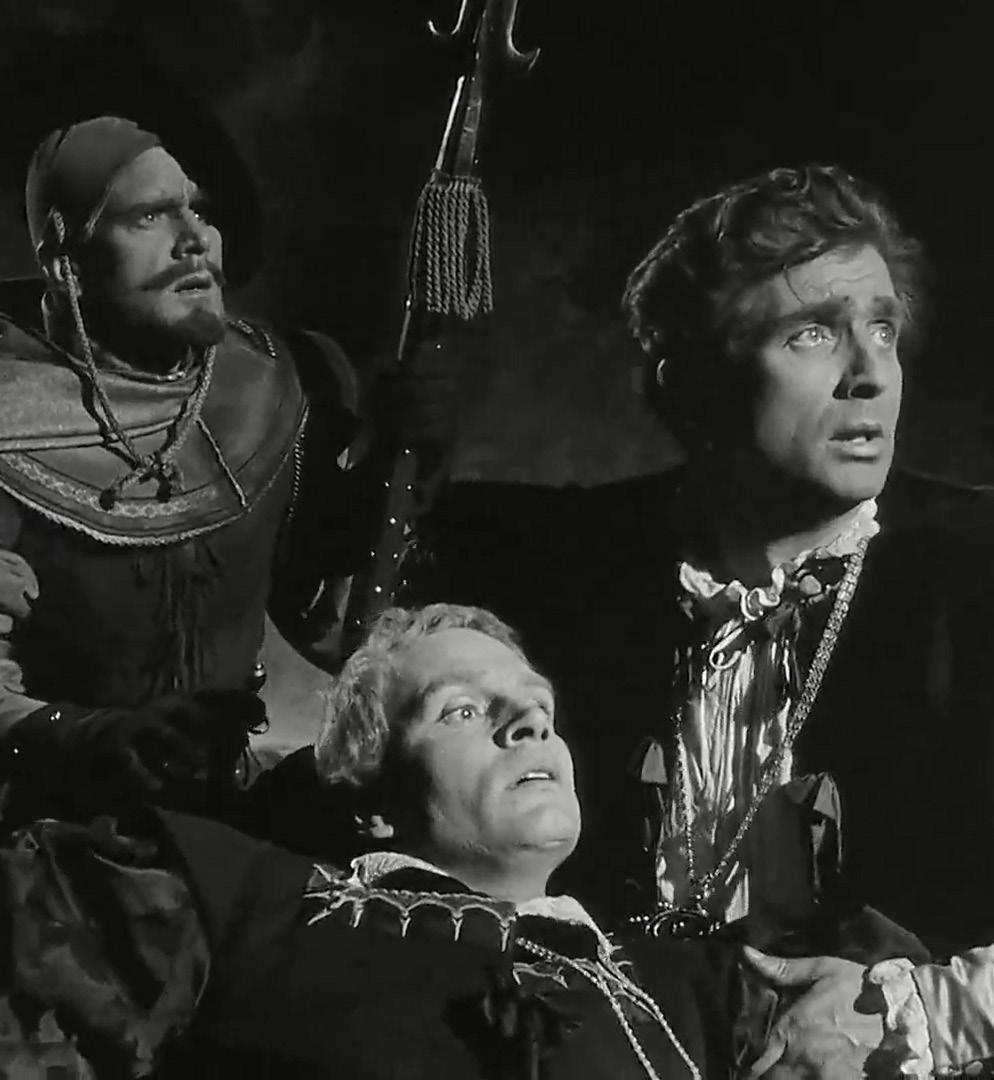
It beckons you to go away with it.... It waves you to a more removed ground. But do not go with it... No, by no means.
Be
It will not speak. Then I will follow it!
159
thou a spirit of health or goblin damned, thou comest in such a questionable shape... that I will speak to thee. I’ll call thee Hamlet.
Look, my lord, it comes!
KING!... FATHER!.... Royal Dane, O answer me! *Breathing heavily* Angels and ministers of grace defend us!
Why? What should be the fear?
Do not my lord!
I do not set my life at a pin’s fee and for my soul, what can it do to that, being a thing immortal as itself? It waves me forth again. I’ll follow it.
What if it tempt you toward the flood, my lord? Or to the dreadful summit of the cliff that beetles o’er his base into the sea and there assume some other horrible form... which might deprive your sovereignty of reason and draw you into madness?
Meanwhile, King Hamlet’s spirit continues to wave, asking him to follow him....




You shall not go, my lord!
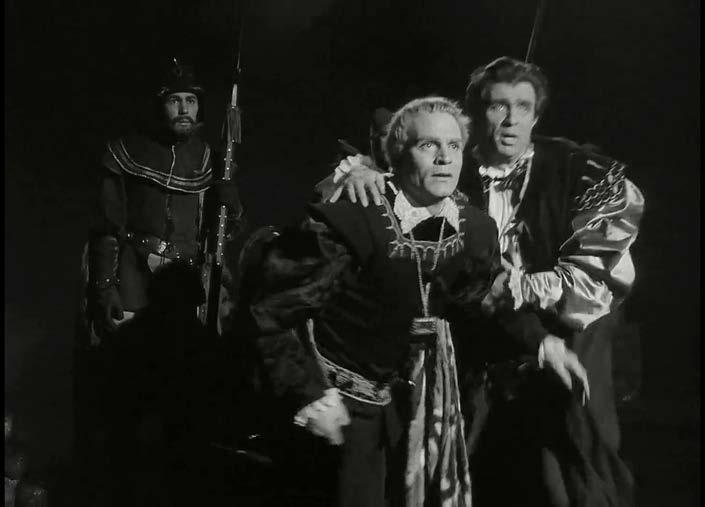
160
King Hamlet’s spirit takes Prince Hamlet on top of one of the towers, which allowed them to have a conversation without anyone noticing them, with the misty weather accentuating the surreal and mystical nature of this encounter. The top of the tower is also in contrast to the convoluted and labyrinth-like indoors, which highlights the sense of clarity that he gets here.





161
Hamlet manages to get out of their clutches, threatens them with the sword, and starts following the spirit...
He holds the sword upside-down making it look like a crucifix...
By heaven, I’ll make a ghost of him that hinders me. I say away!
Go on..I’ll follow thee.
I am thy father’s spirit, doomed for a certain time to walk the night...and for the day confined to fast in fires... till the foul crimes done in my days of nature...



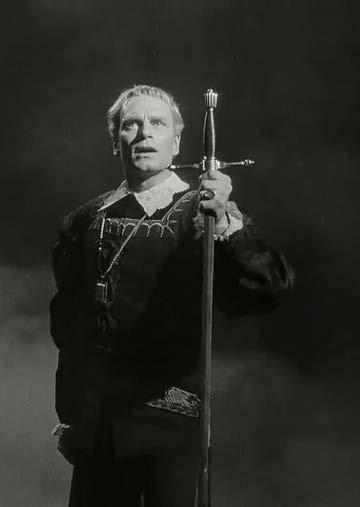
Speak. I’ll go no further.
‘Tis given out that, sleeping in my orchard, a serpent stung me. So the whole ear of Denmark is by a forged process of my death rankly abused. But know, thou noble youth, the serpent
that did sting thy father’s life now wears his crown. Ay, that incestuous, that adulterate beast, with traitorous gifts won to his shameful lust the will of my most seeming-virtuous

Queen. Sleeping within my orchard, my custom always in the afternoon, upon my quiet hour thy uncle stole with juice of cursed hemlock in a vial and in the porches of my ears did pour the leprous, distilment, whose effect holds such an enmity with blood of man that swift as quicksilver it courses through the natural gates and alleys of the body.

162
If thou hast nature in thee, bear it not. Let not the royal bed of Denmark be a couch for luxury and damned incest. But howsoever thou pursuest this act, taint not thy mind, nor let thy soul contrive against thy mother aught. Leave her to heaven.
REMEMBER THEE.... ADIEU....
O all you host of heaven! O earth. What else? And shall I couple hell? Hold. Hold, my heart. Ay, thou poor ghost, while memory holds a seat in this distracted globe. Remember thee? Yea, from the table of my memory I’ll wipe away all trivial fond records that youth and observation copied there. And thy commandment all alone shall live within the book and volume of my brain, unmixed with baser matter!
Yes! By heaven! Most pernicious woman. O villain.
Villain! So, uncle, there you are.
Now to my word.
It is, “Adieu, adieu, remember me.” I have sworn it.

after listening to his father’s spirit Hamlet is shattered.... He then swears to avenge his father by killing his treacherous uncle.
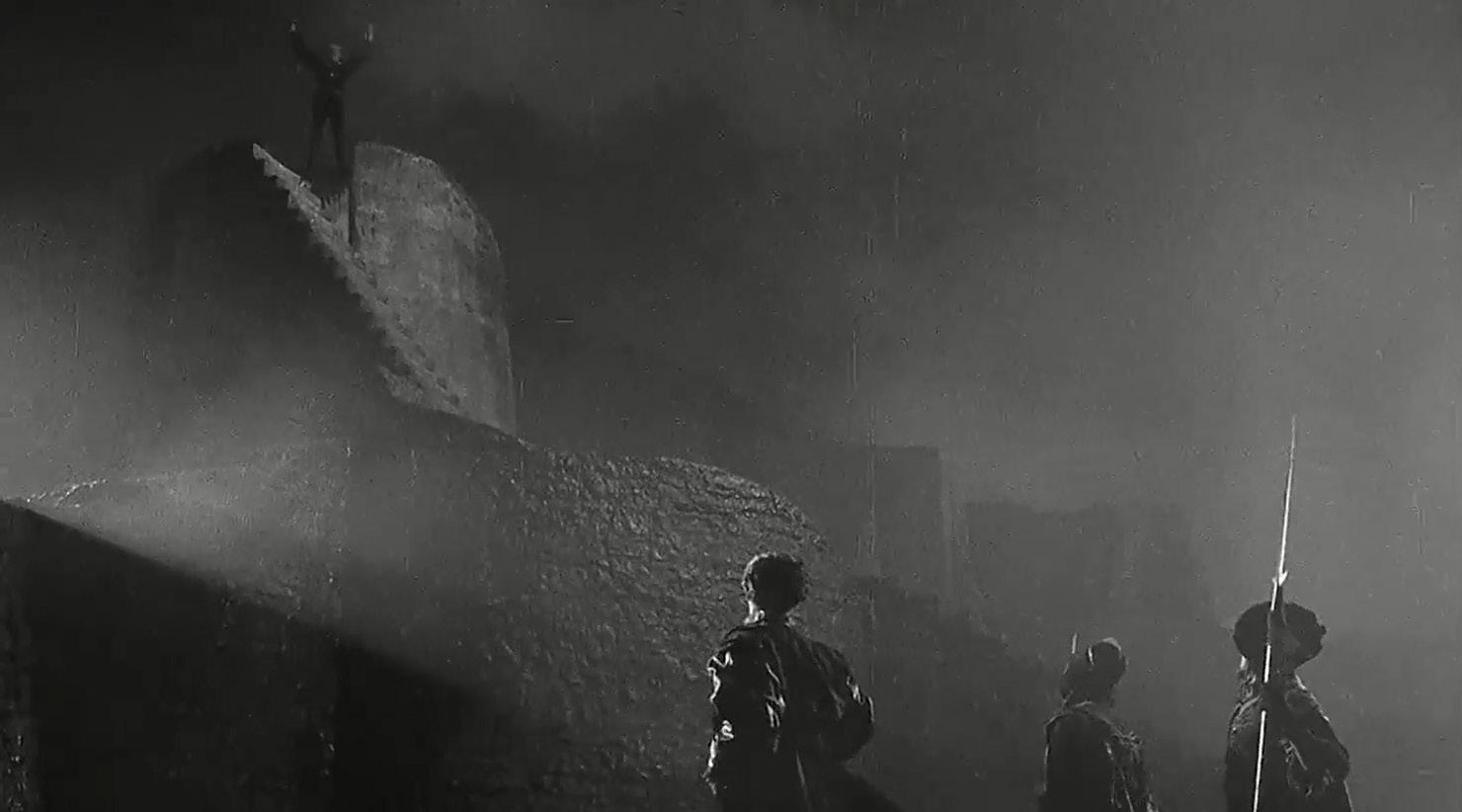

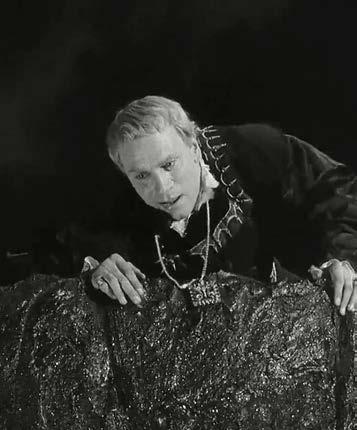

163
Later Horatio and the guards find hamlet and he briefly tells them about his encounter and orders them to not tell anyone about it.
Hillo! Ho, ho, boy. Come, bird, come.
Hillo! My lord!
Sequence
Hamlet (1996)
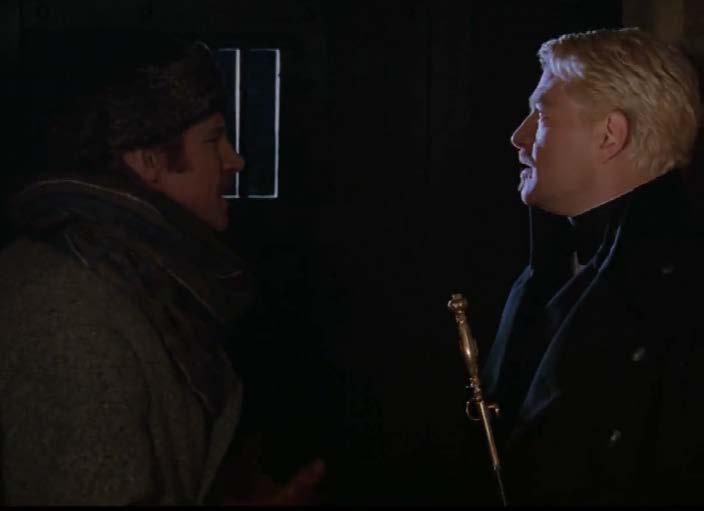
After agreeing to meet the spirit, Hamlet, Horatio, and the two other guards who were present the earlier nights go to the main gate, where they met the spirit...

The exterior shots of the for the Elsinore palace were of the Blenheim Palace, an English Baroque style county house that was built in the early 18th century in Wood stock, England.


164
2.22:
In this shot, the walls have a similar finishing material to that of the Elsinore Castle. It tells us that they are walking in a passage much closer to the exterior and are on their way to the exit to the building without actually showing it. This may also be one of the passages that are rarely used since they do not wish to be noticed while going out.

Look, my lord, it comes!
It beckons you to go away with it.... It waves you to a more removed ground. But do not go with it... No, by no means.
It will not speak. Then I will follow it!
Meanwhile, King Hamlet’s spirit continues to wave asking him to follow him....





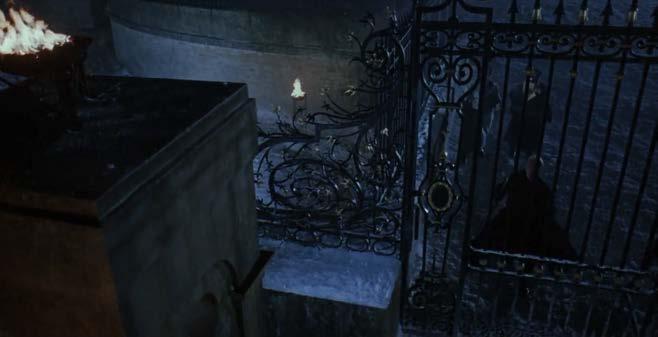
165
I do not set my life at a pin’s fee and for my soul, what can it do to that, being a thing immortal as itself?
It waves me forth again. I’ll follow it.
What if it tempt you toward the flood, my lord? Or to the dreadful summit of the cliff that beetles o’er his base into the sea and there assume some other horrible form... which might deprive your sovereignty of reason and draw you into madness?
By heaven, I’ll make a ghost of him that hinders me. I say away!


Hamlet manages to get out of their clutches by threating them with the sword and starts following the spirit into the woods...
You shall not go, my lord!

As Hamlet follows the spirit and enters the woods, the ground begins to crack open and fog starts rising through it. This adds to the supernatural and surreal nature of this encounter with his father’s spirit (The fog/mist was also used to a similar effect in the earlier scene as well).


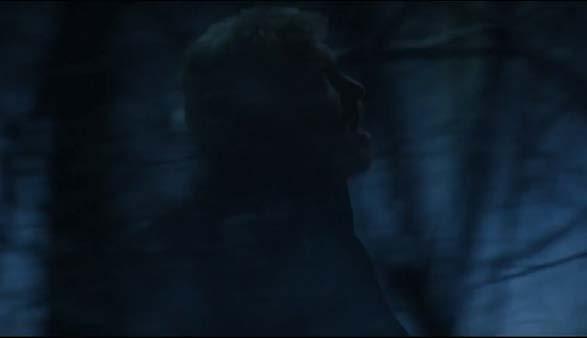

166
Say, why is this?
Wherefore?. What should we do?
Whither with thou lead me?
Speak. I’ll go no further!
I am thy father’s spirit, doomed for a certain time to walk the night... and for the day confined to fast in fires... till the foul crimes done in my days of nature... Revenge his foul and most unnatural murder....
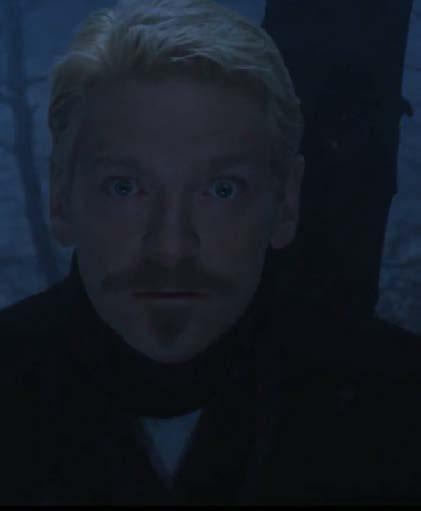
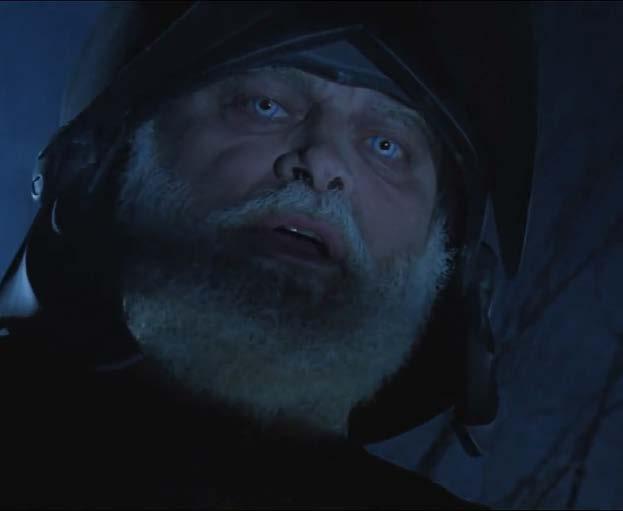



167
Soon the whole forest is covered in thick fog, and suddenly King Hamlet’s spirit disappears...
And through this thick fog, the spirit suddenly reappears...
MURDER?
Murder most foul, as in the best it is... ... but this most foul, strange,and unnatural. ‘Tis given out that, sleeping in my orchard, a serpent stung me. So the whole ear of Denmark is by a forged process of my death rankly abused. But know, thou noble youth, the serpent that did sting thy father’s life now wears his crown....
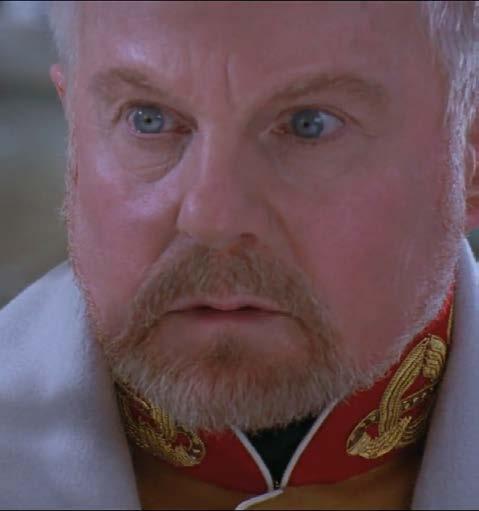
Ay, that incestuous, that adulterate beast, with traitorous gifts won to his shameful lust the will of my most seeming-virtuous Queen. Sleeping within my orchard, my custom always in the afternoon, upon my quiet hour thy uncle stole with juice of cursed hemlock in a vial and in the porches of my ears did pour the leprous, distilment, whose effect holds such an enmity with blood of man that swift as quicksilver it courses through the natural gates and alleys of the body.
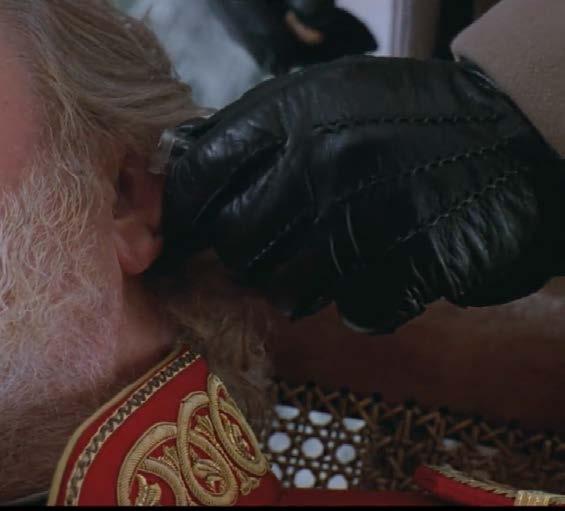
The snow helps to metaphorically indicate the ‘cold’ and sly nature of the crime.
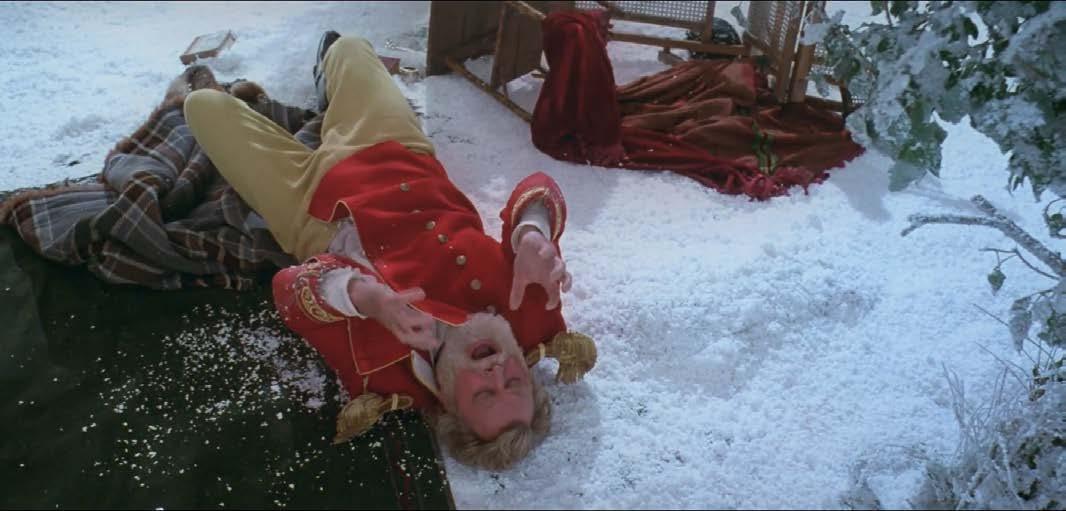
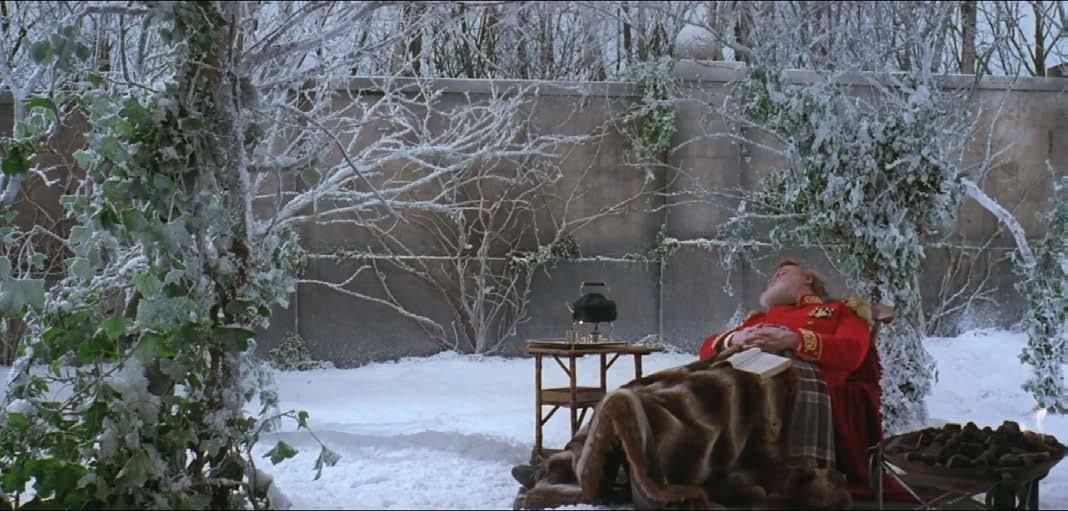
168
ADIEU HAMLET, ADIEU....


If thou hast nature in thee, bear it not. Let not the royal bed of Denmark be a couch for luxury and damned incest. But howsoever thou pursuest this act, taint not thy mind, nor let thy soul contrive against thy mother aught. Leave her to heaven.. and to those thorns that in her bosom lodge... to prick and sting her.
O all you host of heaven! O earth. What else? And shall I couple hell? Hold. Hold, my heart. Ay, thou poor ghost, while memory holds a seat in this distracted globe. Remember thee? Yea, from the table of my memory I’ll wipe away all trivial fond records that youth and observation copied there. And thy commandment all alone shall live within the book and volume of my brain, unmixed with baser matter!
Yes! By heaven! Most pernicious woman. O villain. Villain! So, uncle, there you are. Now to my word. It is, “Adieu, adieu, remember me. “ I have sworn it.



169
King Hamlet’s spirit disappears....
Sequence
Haider (2014)
After a few weeks, Haider’s search for his missing father reaches a dead end as he receives little to no support. His mother has accepted her fate as a half-widow and the police refuse to help him in any manner....
The wives of disappeared people are called ‘half-widows’ here. We can only wait. That is all I can do. Wait....
For Abbuji to return?
Yes..
Or for his corpse..
For Abbuji to return?
The colour red has a lot of significance throughout the film with the director using it as a motif to convey emotions like love, passion, power, and anger -emotions that are generally associated with that color-. In the still above, Haider is sitting at the Parvez’s office (Arshia’s father and Khurram’s friend and ally) who is the Superintendent of Police. The curtains here are red in colour which suggests his ‘power’ over Haider.

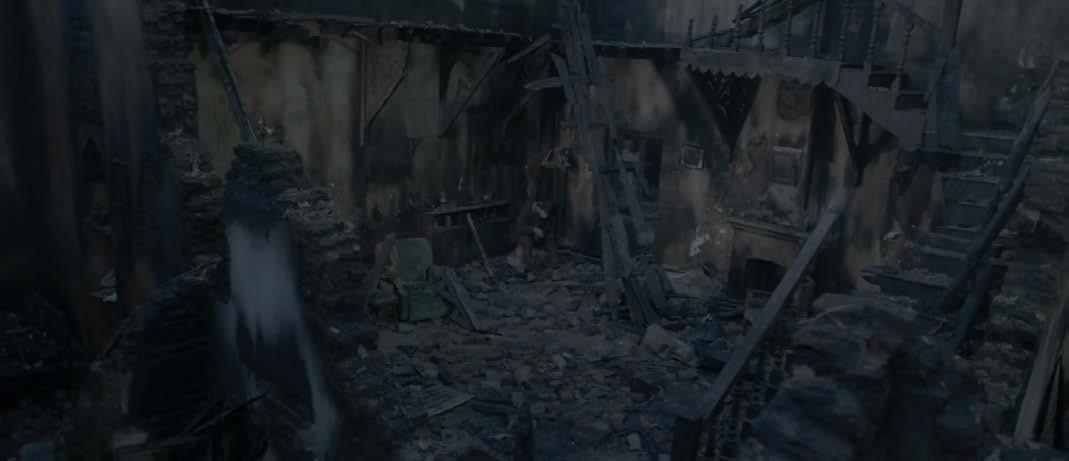
The film also uses the change in seasons to show the progression of time as well as the emotions he is going through. The colour of the dried leaves, as well as the one’s on the ground, suggest that it’s the ‘fall’ (autumn) season. It is after this scene that Haider gets to know the truth about his father’s disappearance. It is metaphorically suggested with the trees shedding leaves that the characters in the film would be ‘shedding’ their false image/masks and revealing their true selves.

The colours that Haider is wearing in this still make him merge with the surroundings of his dilapidated house. It also helps the audience understand his mental space which has become like the house; shattered and burnt out.

170
2.23:
The change in climate, from autumn to winter also suggests the beginning of a new phase in the story.

This scene marks the entry of a new character in the film, Roohdaar. This character is in place of Haider’s father’s spirit that we saw in previous adaptations.



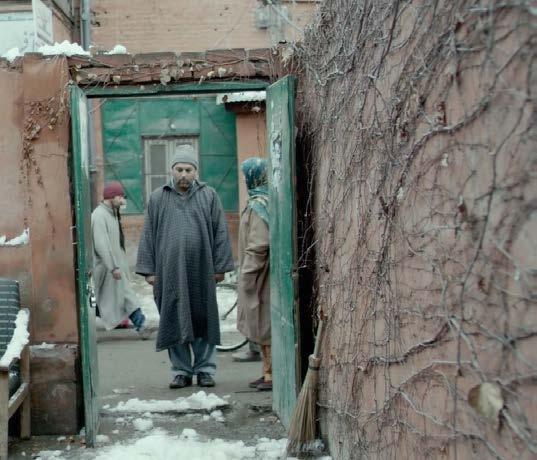

The man here suffers from a psychological disorder due to which he stands at the entrance of his own house for hours without responding, if he is not frisked. This is because of being treated like that for a long time in the detention center. Roohdaar comes and explains his condition to his wife and Arshia, who is standing next to them.
Where are you coming from?..
Where are you going?....
What’s in your pockets?..
This still is framed in such a way that the dried vines resemble the chain-link that would have been at the detention center.
Your identity card?... You may go now.

171
The
People have become so used to body searches...that unless they are frisked... they fear entering their own homes. It’s a psychological disorder... the
Disease’...
Roohdaar keeps following Arshia on her way to her office...
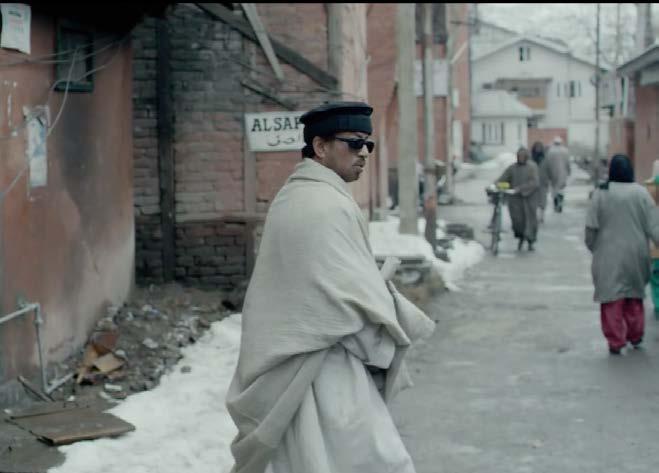




Why are you following me? What do you want?
I have no message for anyone.
A message. A message for Haider, from his father A message for Haider shall be delivered to Haider! Right?

Here is my number. I will wait for his call.
Are
a doctor?
Rooh...
What is your name?

172
‘New
you
doctor’s soul.
A message. But I do...
Roohdaar.
Arshia tells Haider about
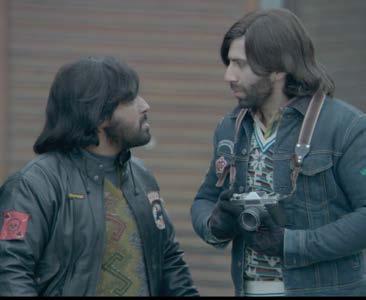

and they contact him. Rooddaar then
Zaina
The bridge here connects downtown -which is plagued by militants and terroriststo the safer part of the town.

Salman...to go?
What’s he heading to Downtown
Or not to go?
Haider reaches the bridge on time and contacts Roodaar. On his way, he is followed by his friends and Parvez’s spies, the Salman brothers. They follow him up until the bridge, although apprehensive at first because of downtown’s maligned reputation, they eventually decide to go ahead anyway. Meanwhile, Haider follows Roohdaar through the lanes in downtown and is eventually kidnapped and taken to a remote location in a vehicle.



173
Roohdaar
asks him to meet him in Downtown,
Kadal bridge at 9am the next day
for? UGHH!..
The idea of selecting a graveyard as a hideout is interesting because it doesn’t just make it unsuspicious, but it also metaphorically means that it is where the ‘dead’ and buried secrets would come alive. Also, in the climactic sequence, the tombstones are used as bunkers by the armed forces fighting under Khurram’s command. And because of the dense white snow, the blood and gunpowder that is spilled is even more accentuated.







174
They take him to their hideout which is a house in a secluded graveyard....
Where is my father?
You said you had a message from him... In a faraway place... Yes. Revenge! Vengeance! From a murderer... for a murder...
You seem to have confused matters. My father was arrested by the army and one of these days... we will find out where they’re holding him.
And he suddenly stops...
As Haider turns to leave, Roohdaar begins to sing the song that his father used to sing....
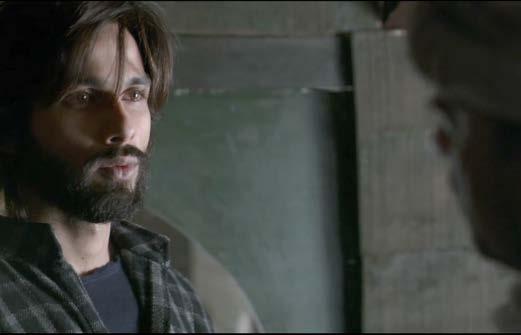

As Haider stops, Roohdaar begins to narrate his and the ‘message’ to Haider. He tells him about how he met his father at MAMA2 the detention center where he was also a prisoner with his father.... He tells him how his father’s song was a balm to their agony when fatigue would muffle their screams in the prison.......


The first shot of the prison, MAMA 2 is taken through the chain-links. (this is like a callback to the earlier encounter with the mentally ill man shown earlier in the film)
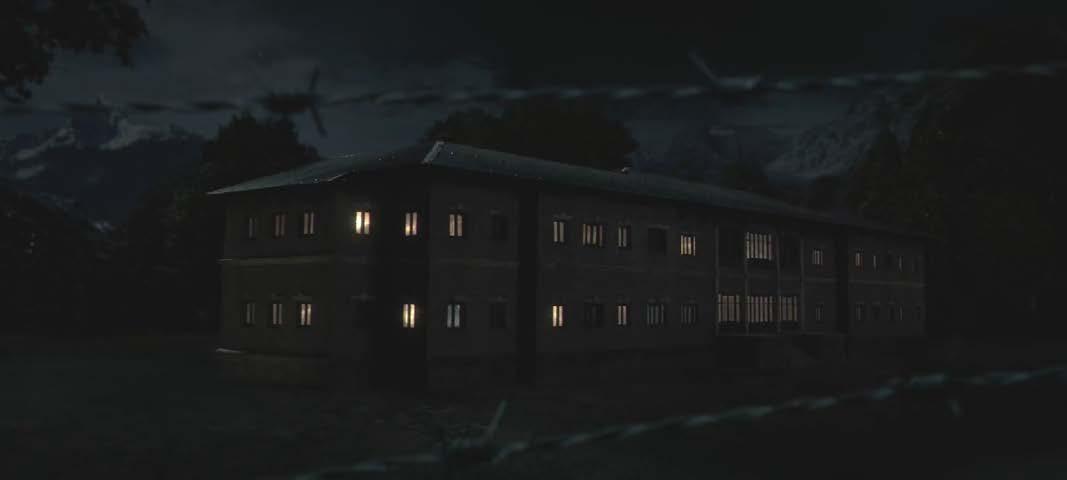
175
*Singing ‘guloon mai rang bhare’ *
In this scene we can see the sorry state in which the prisoner are kept. The harsh nature of the prison is further accentuated by the material pallet along with the raw and ‘brutalist’ textures of the buildings.



Men returned from there as mere shadows of themselves.
The lights were never turned off... we craved for the darkness. Lice roamed on our broken bodies... and vengeful snakes in our hearts. MAMA-2 was the other name for hell.
One day in the camp the prisoners were asked to repeat ‘Jai Hind’ and there were just two people who did not, Roohdaar and Hilaal...



Since that day doctor and I were always together...like body and soul... We bore our torments together in the same cell.
From that day onwards both were shifted to the cell in the dungeon with stricter punishments...

176
*Hilaal singing ‘guloon mai rang bhare’ *
You can die docter but I won’t.
You are the body and I’m the soul... You are mortal and I’m immortal!
One day they took them to another camp, Faraz cinema, for more interrogation....
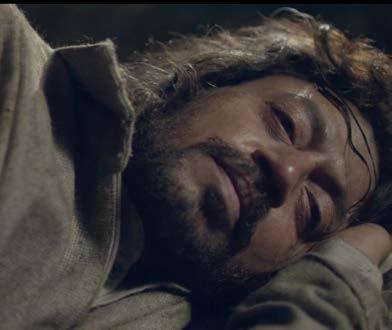


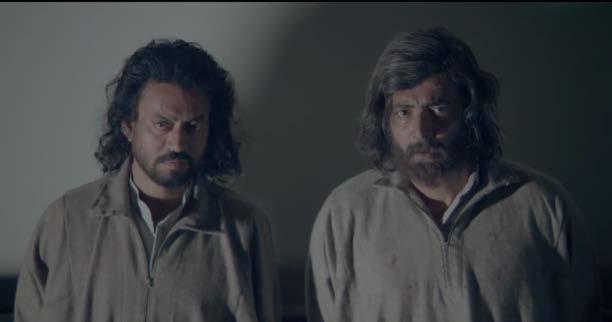


It was Khurram who betrayed your father. The army crackdown in your village was not a matter of chance. Khurram was the army’s informer...
And his mother?
It seems we will be killed together as well.
And how is that?
Roohdaar... If you do make it out alive... Convey my message. To my son, Haider. Tell him to avenge my betrayal... by my brother. Tell him to aim his bullets at those cunning, deceiving eyes... that entrapped his mother... that made him an orphan.

God will be her judge.
And one day, there was a revelation.
177
The shot here is lit from behind in order to have high contrast, thus making Roohdaar and Hilaal look the same which is symbolically in line with what he says that they became like ‘body’ and ‘spirit’.
We had become a burden for everyone... They handed us over to the lkhwan.
TRAT!
SPLASH!
Both of them are tied, shot and then thrown off the bridge, into the cold Jehlum river....



He told him that a little ahead of Baramulla, at Boniyar village there is a graveyard where the unknown dead are buried.... And that is where he would find his father’s grave. They also give him a gun and tell him to aim at the eyes that entrapped his mother and orphaned him.

It was a miracle! The rope that bound us came loose... The icy water of the Jhelum stopped my bleeding. Sand-miners on the river bank saved me. A few days later, they found the doctor’s body.

178
TRATT!
Haider goes to his father’s grave and bursts into tears.....

Since this scene is after he gets to know the truth, the trees are also bare just like how the mystery regarding his missing father is now known to him, which is a followup to the beginning of the sequence when the trees had just begun to shed their leaves.



*Sobbing*
The scene shows Haider’s descent into madness as he jumps off the bridge...

179
Sequence 3.21: Hamlet (1948)


Polonius is convinced that Prince Hamlet has gone mad and does not want his daughter Ophelia to have any relations with him. He puts forth his concerns to the King and the queen, telling them about Hamlet’s strange behavior, and this conversation is heard by Hamlet. To prove his claim, he has a conversation with Hamlet in the hall while the queen and the king hide and listen to them. Throughout the conversation Hamlet purposely behaves eccentrically and keeps slyly insulting Polonius. To make his point, he further calls Ophelia and asks her to walk in the hallway with a book until Hamlet arrives and also asks her to returns him his love letters and ‘tokens of affection’, whilst he and King Claudius hide behind the curtains to see his reaction.
One of the major characteristics of the characters in the play and the film is spying. Thus there are a lot of corners, niches, and alcoves, some even covered (like the one above) -an inherent quality in Romanesque architecture40- the style in which the building was designed. It doesn’t just facilitate their intention and actions but also helps in giving the setting similar characteristics, thus complementing each other.
40 “The World of 1940s Design in Olivier’s Shakespeare Films.” British Film Institute, 19 Apr. 2016, https://www2.bfi.org.uk/news-opinion/newsbfi/features/designs-laurence-olivier-henry-v-hamlet.

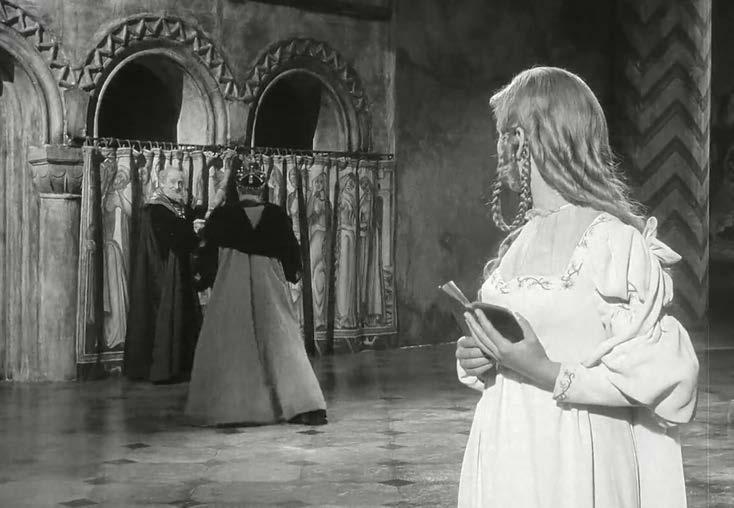
180
Let’s withdraw, my lord.
Hamlet, aware of Polonius’s, plan walks into the hall and greets Ophelia
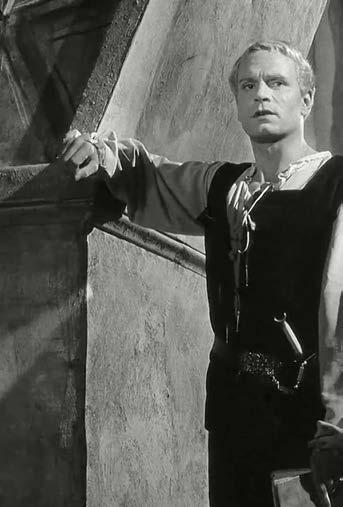
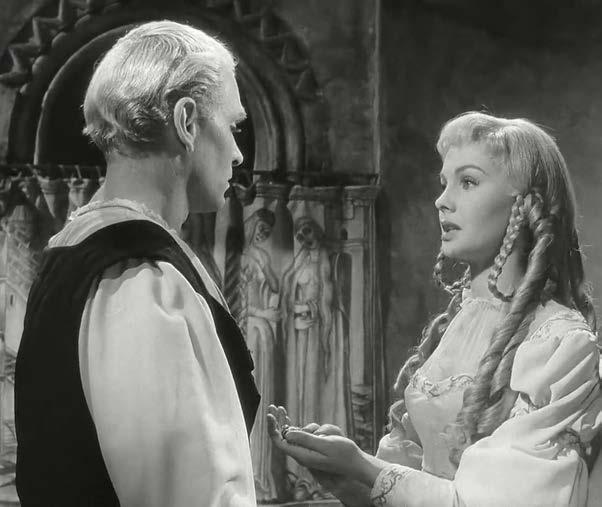




Soft you, now... the fair Ophelia.
Nymph, in thy orisons be all my sins remembered. (Hamlet reads from her book)
I humbly thank you.
My lord, I have remembrances of yours that I have longed long to re-deliver. I pray you now receive them.
No, not I. I never gave you aught.
Are you honest?
I did love you once.
My honoured lord, you know right well you did. And with them words of so sweet breath composed as made the things more rich.
My lord. Indeed, my lord, you made me believe so
181
Good my lord... How does your honour for this many a day?
You should not have believed me. Get thee to a nunnery. Why wouldst thou be a breeder of sinners? I am myself indifferent honest, but yet I could accuse me of such things that it were better my mother had not born me. We are arrant knaves, all. Believe none of us. Go thy ways to a nunnery!
Where’s your father? Let the doors be shut upon him, that he may play the fool nowhere but in his own house.
Here Hamlet uses the stairs to establish his ‘moral superiority’ in front of Ophelia, whom he accuses of impropriety.

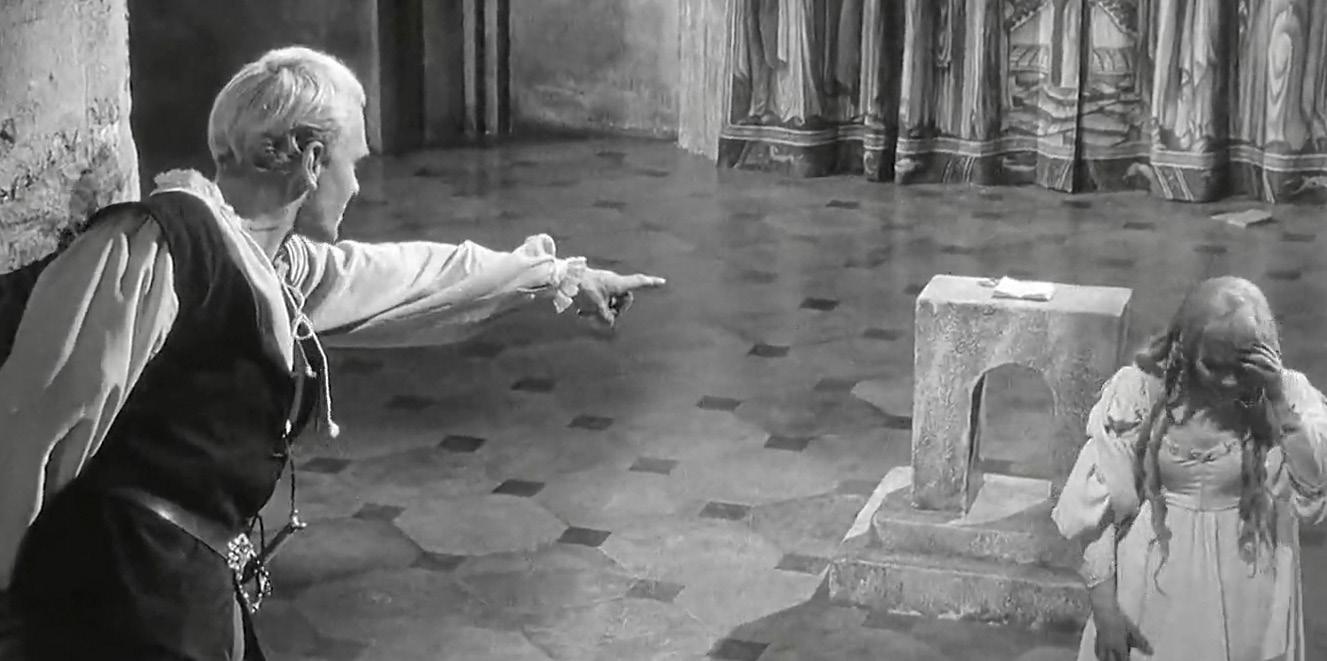
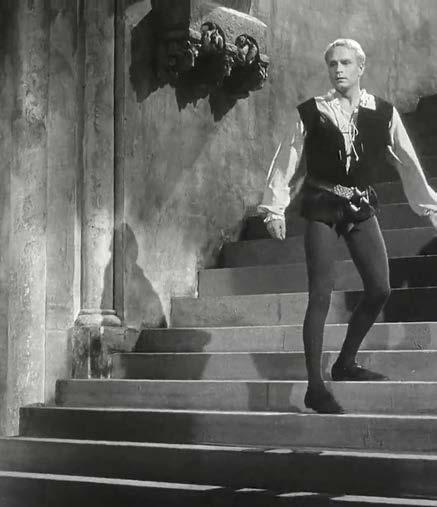
I have heard of your paintings, too, well enough. God hath given you one face and you make yourselves another. You jig, you amble, you lisp. You nickname God’s creatures and make your wantonness your ignorance. Get thee to a nunnery! Farewell!

The rest shall stay as they are. To a nunnery. Go... (whispers softly)
Or if thou would needs marry, marry a fool, for wise men know well enough what monsters you make of them. Go to, I’ll no more of it! I say we will have no more marriages. Those that are married already all but oneshall live.
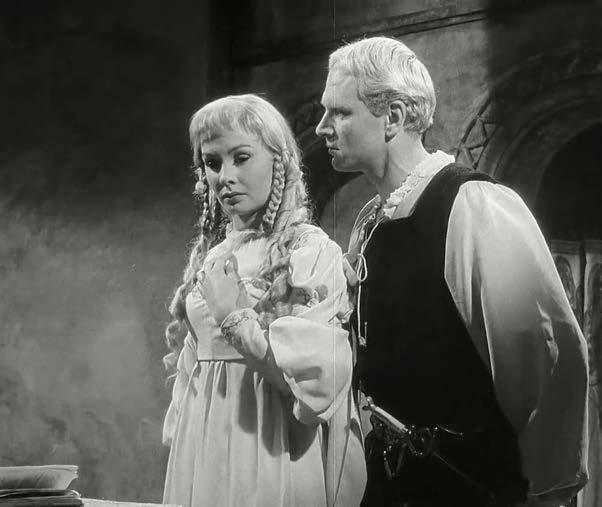
182
Hamlet wants to make sure that Polonius and most importantly Claudius, think that he has lost his mind and do not suspect him of planning to do something against him to avenge his father. But while doing so he has to break his and Ophelia’s hearts. And so, Hamlet purposely insults her and leaves her sobbing on the staircase.....




183
*Sobbing* WAA AH AH UG!....
The camera is continuously moved through the cyclical motion of the spiral staircase to emphasize Hamlet’s mental conflict.



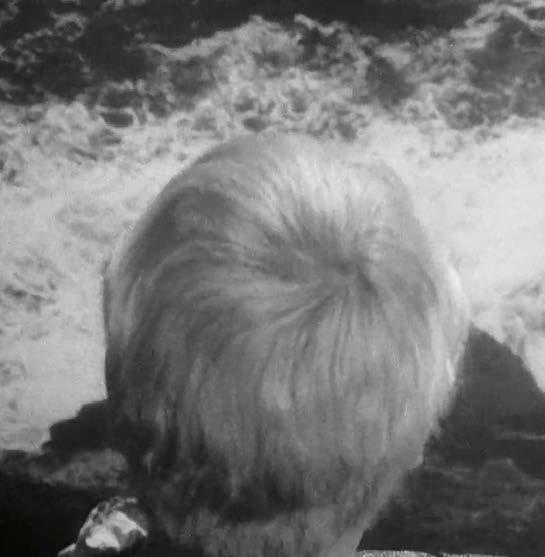


Whether ‘tis nobler in the mind to suffer the slings and arrows of outrageous fortune, or to take arms against a sea of troubles, and, by opposing.. end them. To die, to sleep, no more, and by a sleep to say we end the heartache and the thousand natural shocks that flesh is heir to, it is a consummation devoutly to be wished.

184
The camera pans out, goes up the staircase, and through the window and back on to the stairs, and finally reaches at the top of the tower, where Hamlet sits contemplating his thoughts and actions....
To be, or not to be.... That is the question.....
To die, to sleep, to sleep... Perchance to dream. Ay, there’s the rub, for in that sleep of death what dreams may come when we have shuffled off this mortal coil must give us pause. There’s the respect that makes calamity of so long life, for who would bear the whips and scorns of time, the oppressor’s wrong, the proud man’s contumely, the pangs of despised love, the law’s delays, the insolence of office, and the spurns that patient merit of the unworthy takes, when he himself might his quietus make... with a bare bodkin?
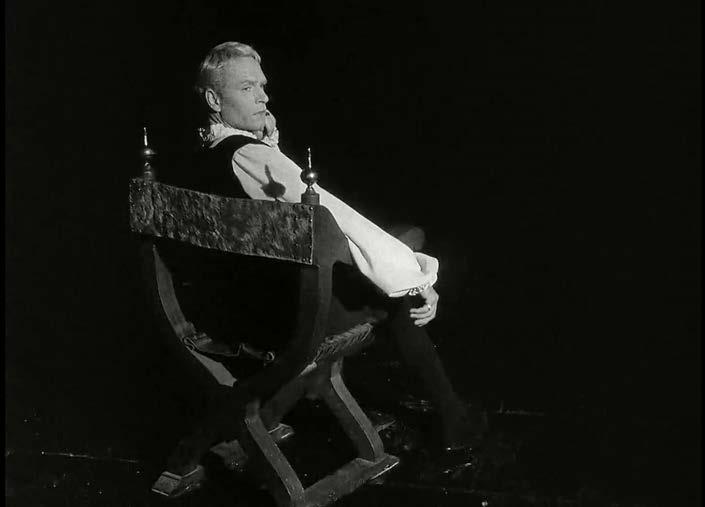
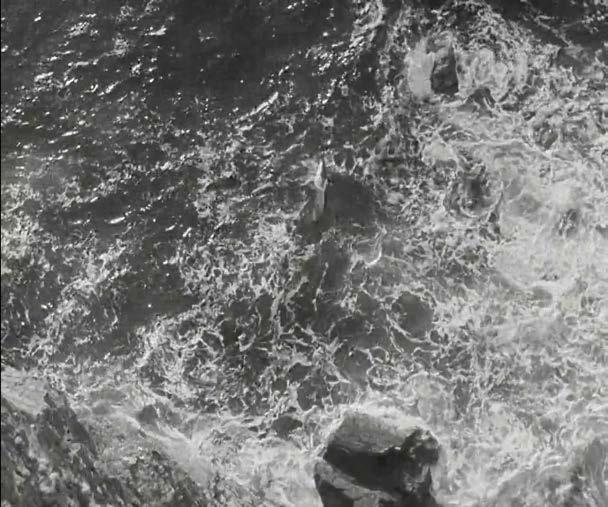
Who would fardels bear, to grunt and sweat under a weary life but that the dread of something after death, the undiscovered country from whose bourn no traveler returns, puzzles the will and makes us rather bear those ills we have than fly to others that we know not of? Thus conscience doth make cowards of us all. And thus the native hue of resolution is sicklied o’er with the pale cast of thought. And enterprises of great pith and moment, with this regard their currents turn awry... and lose the name of action.
Similar to the previous sequence, here too it is a time that Hamlet has to be alone, talking aloud to himself. And the top of the tower provides him with such a place because of its height and the mist that comes with it because of the altitude. At one point, Hamlet is also positioned on the edge of the tower contemplating killing himself and the edge condition that is devoid of a parapet adds thrill to the whole sequence. Him choosing this place over any other room is also metaphorical because by doing so he is trying to ‘reach to his higher self.



185
Sequence 3.22: Hamlet (1996)

This sequence begins with Polonius trying to prove his point that Prince Hamlet is beginning to lose his mind. As opposed to the 1948 adaptation here the sequence begins with Polonius and Claudius hiding behind the two-way mirror door and asking Ophelia to hide until Hamlet arrives....
Let’s withdraw, my lord.
The harlot’s cheek, beautied with plast’ring art...is not more ugly to the thing that helps it. Than is my deed to my most painted word. O heavy burden!
This sequence is very unique to this particular film adaptation because of it’s choreography and its use of the setting. “The execution of this scene would have been hard to achieve on stage as the camera dollies Hamlet, until he stands in front of the mirror reciting the monologue, and slowly eases into a close-up to focus on his reflection. (On stage an actor would have to either stand with his back to the audience, which is unacceptable, or use a prop in front of his face, but the intensity as well as the desired perspective would have been lost.)”41



41 Kurtia, Tetiana k. “Hamlet on Screen: William Shakespeare’s Play in Film Adaptation.” Charles University in Prague – Faculty of Philosophy Institute of Anglophone Literature and Cultures., n.d..pp. 36-37
As Hamlet enters the grand hall he sees that there is no one there. Unaware that Polonius, Claudius and Ophelia are hiding, he takes this rare opportunity of solace to vent out his conflict and begins his soliloquy.....

186
TICK TAK TICK... To be, or not to be.... That is the question.....
Apart from the theme of spying which was integral to the architectural setting in the 1948’s adaptation, here it also talks about self reflection and that is presented major by using mirrors.
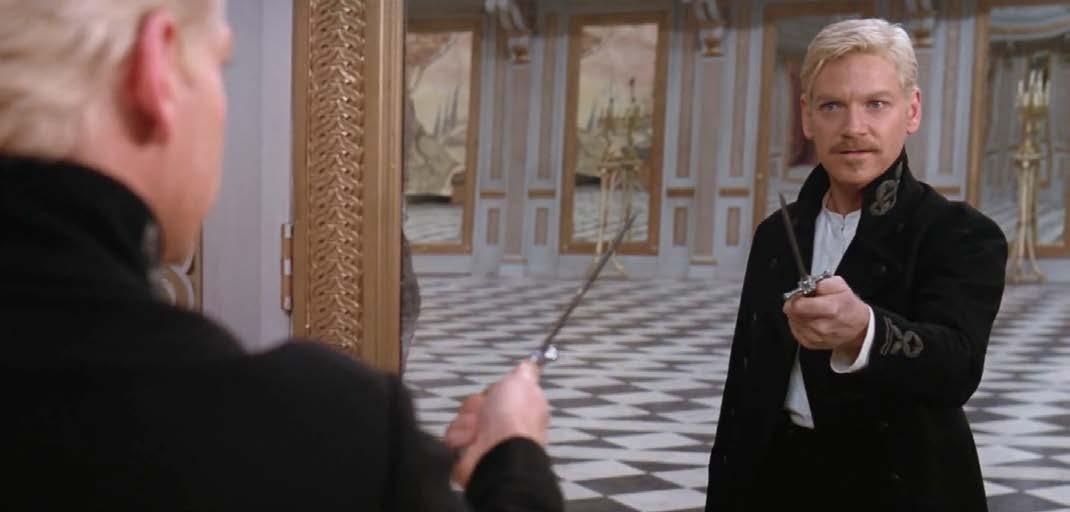


‘Tis a consummation devoutly to be wished. To die... ...to sleep. To sleep... ...perchance to dream. Ay, there’s the rub. For in that sleep of death... ...what dreams may come... ...when we have shuffled off this mortal coil... ...must give us pause.
Whether ‘tis nobler in the mind to suffer the slings and arrows of outrageous fortune, or to take arms against a sea of troubles, and, by opposing.. end them. To die, to sleep. No more... ...and by a sleep to say we end... ...the heartache and the thousand natural shocks... ...that flesh is heir to.
continues while Polonius and Claudius look on...

“Not only by the means of the close-up shot the importance of his musings is stressed, but that seamless transition between ‘two Hamlets’ illustrates a confrontation with himself. Mirrors distort the reality and Hamlet’s absorption in his meditation erases the boundaries between the reality and his reflection.”42
Kurtia, Tetiana k. “Hamlet on Screen: William Shakespeare’s Play in Film Adaptation.” Charles University in Prague – Faculty of Philosophy Institute of Anglophone Literature and Cultures., n.d..pp.
There’s the respect that makes calamity of so long life. There’s the respect that makes calamity of so long life, for who would bear the whips and scorns of time, the oppressor’s wrong, the proud man’s contumely, the pangs of despised love, the law’s delays, the insolence of office, and the spurns that patient merit of the unworthy takes, when he himself might his quietus make... with a bare bodkin?
“Due to the distortion of the reality implied by mirrors, one cannot decide on who is the recipient, ‘for the dagger moves forward the men on both sides of the mirror.”43
Kurtia, Tetiana k. “Hamlet on Screen: William Shakespeare’s Play in Film Adaptation.” Charles University in Prague – Faculty of Philosophy Insti tute of Anglophone Literature and Cultures., n.d..pp.
187 Hamlet
43
36-37
42
36-37
Who would fardels bear, to grunt and sweat under a weary life but that the dread of something after death, the undiscovered country from whose bourn no traveler returns, puzzles the will and makes us rather bear those ills we have than fly to others that we know not of?

Thus conscience doth make cowards of us all. And thus the native hue of resolution is sicklied o’er with the pale cast of thought. And enterprises of great pith and moment, with this regard their currents turn awry... and lose the name of action.

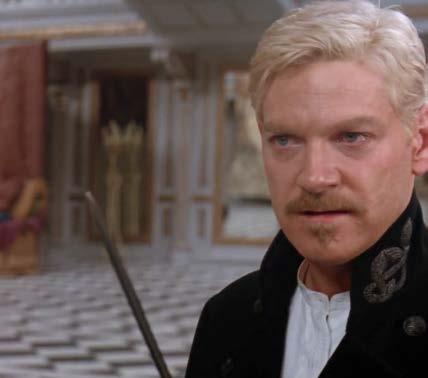



Nymph, in thy orisons be all my sins remembered.
Good my lord... How does your honour for this many a day?
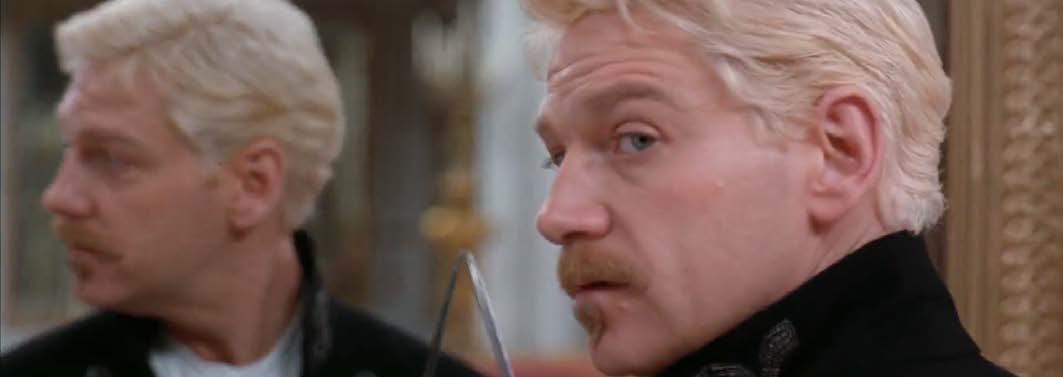
188
CLICK! TICK TOCK TICK... Ophelia walks up to the center of the hall.... Soft you, now... the fair Ophelia....
No, not I. I never gave you aught.
Are you honest?
My lord, I have remembrances of yours that I have longed long to re-deliver. I pray you now receive them.
My honored lord, you know right well you did. And with them words of so sweet breath composed as made the things more rich.
KLIINNGGG!
I did love you once.

Indeed, my lord, you made me believe so
Claudius’s movement in the room makes a noise which is heard by Hamlet. And he figures out that this was Polonius’s plan all along....
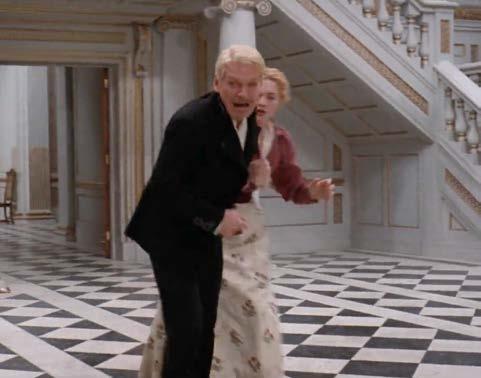
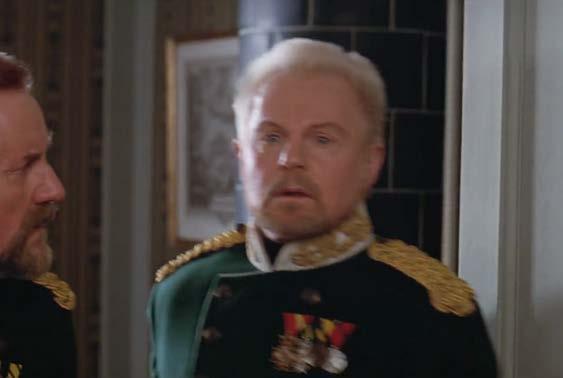




Indeed, my lord, you made me believe so
Let the doors be shut upon him... ...that he may play the fool... nowhere but in his own house. Farewell!
189
THUD!
*Shrieks*




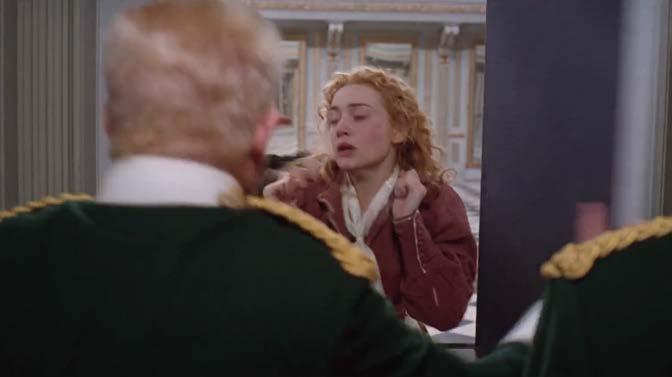
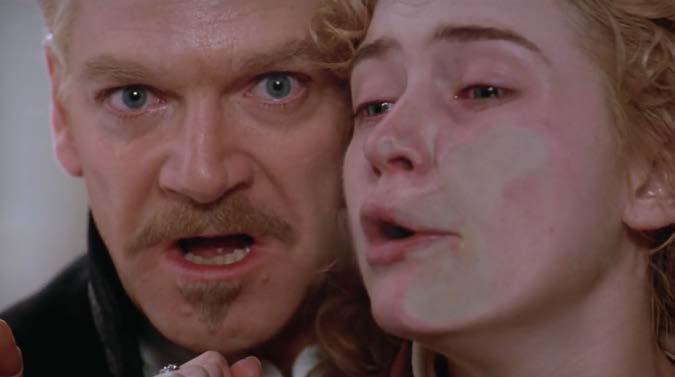


190 If thou dost marry, I’ll give thee this plague for thy dowry... Be thou as chaste as ice, as pure as snow... ...thou shalt not escape calumny. Get thee to a nunnery, go, farewell! For wise men know well enough what monsters you make of them. You nickname God’s creatures and make your wantonness your ignorance. Get thee to a nunnery! Farewell! UGHHH! To a nunnery, go, and quickly too. Farewell. Heavenly powers, restore him. I have heard of your paintings too, well enough. God hath given you one face, and you make yourselves another. You jig, you amble, and you lisp... Polonius and Claudius quickly close the shutter and run towards the secret door to the right....
“The mirrors, as a connotation of the source and symbol of truth, fit within the context of the succeeding ‘nunnery scene’, where Hamlet is forcing Ophelia in an aggressive manner to admit her betrayal.”44 44 Kurtia, Tetiana k. “Hamlet on Screen: William Shakespeare’s Play in Film Ad aptation.” Charles University in Prague – Faculty of Philosophy Institute of Anglophone Literature and Cultures., n.d..pp.37

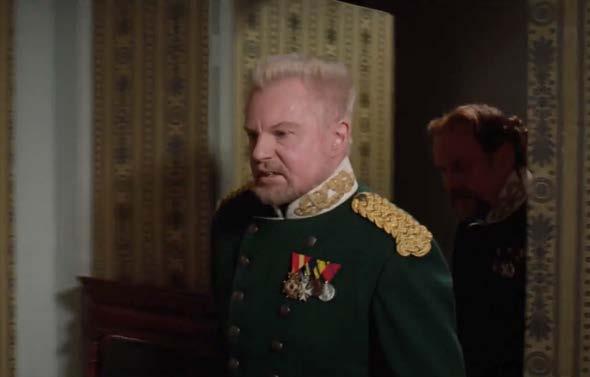

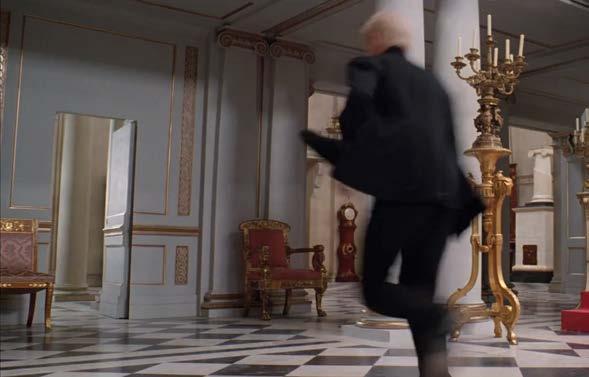
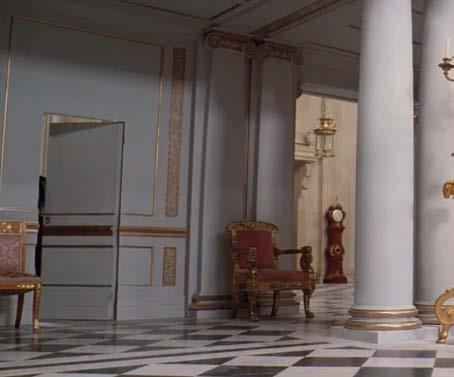


191 Hamlet rushes out of the hall.... Claudius contemplates about the action he should take against Hamlet, while Polonius comforts the wailing Ophelia... *Sobbing* To a nunnery.... Go....!
Haider (2014)

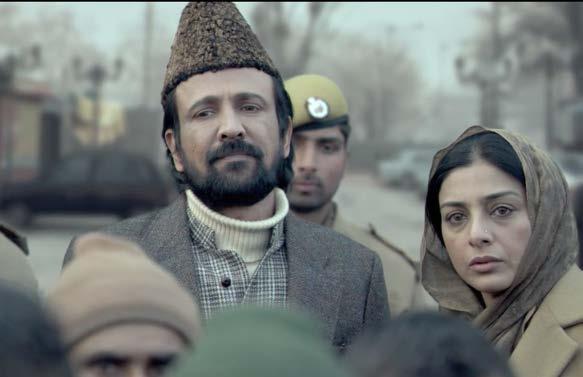




192 Sequence 3.23:
Khurram and Ghazala are on their way somewhere in the back seat of their car when suddenly the driver stops because of some unusual traffic near Lal Chowk...
A
traffic jam at
the square...
‘Lal Chowk’ as a location for this particular scene has a direct relation with the story as well as in its subtext. In an earlier scene when Haider is at Parvez’s office asking him to file an FIR regarding his father’s disappearance, he mentions a speech where the then Prime Minister Nehru had promised a plebiscite, and that speech was given at the Laal Chowk. Which makes this location a place of historical significance in Kashmir’s politics. And this film has a constant underlying subtext that comments on the political scenario and social impact of the Armed Forces (Special Power) Act 1958 in Kashmir.



What?
Hello...mic testing one, two, three... Can you hear me? Hello...hello...hello... UN council resolution number 47 of 1948... article 2 of the Geneva convention and article 370 of the Indian constitution... Raises but one question! Do we exist or do we not? If we do... then who are we? If not... then where are we? Did we exist at all? Or not?
Haider.. (shockingly).

Law and order... Law and order... There is no law, there is no order. Whose laws? Whose order? Made on order... Law and order... India! Pakistan! A game on the border. India clings to us.. Pakistan leeches on... What of us? What do we want?

193
FREEDOM! FREEDOM! FREEDOM!
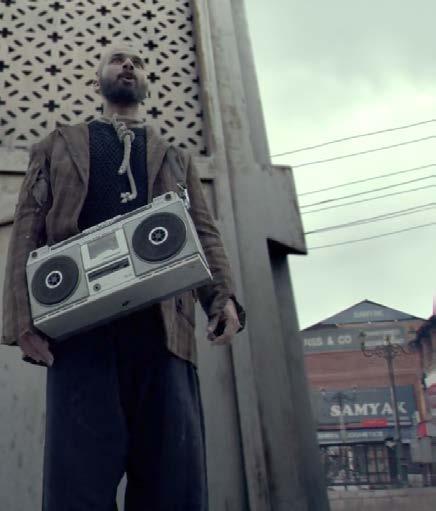




194 Haider.... Why are you crying? There’s good news for you. Nobody will call you a half-widow now... Father is dead. I found his grave. No more hidden musicals (laughs). You don’t believe me, right? Hang on... I have a photograph... My dead father... When did you come? He is dead? Yes? Whose? Mine... Yes.. Ammi... (mother) Yours...
Over there Khurram is surprised to see Haider’s eccentric and indifferent behavior...

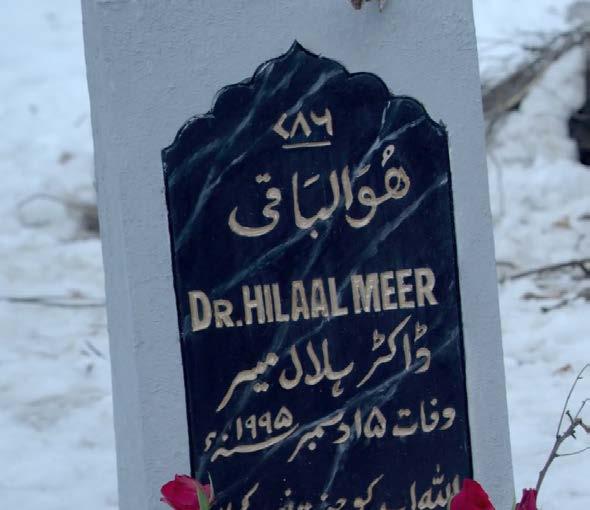
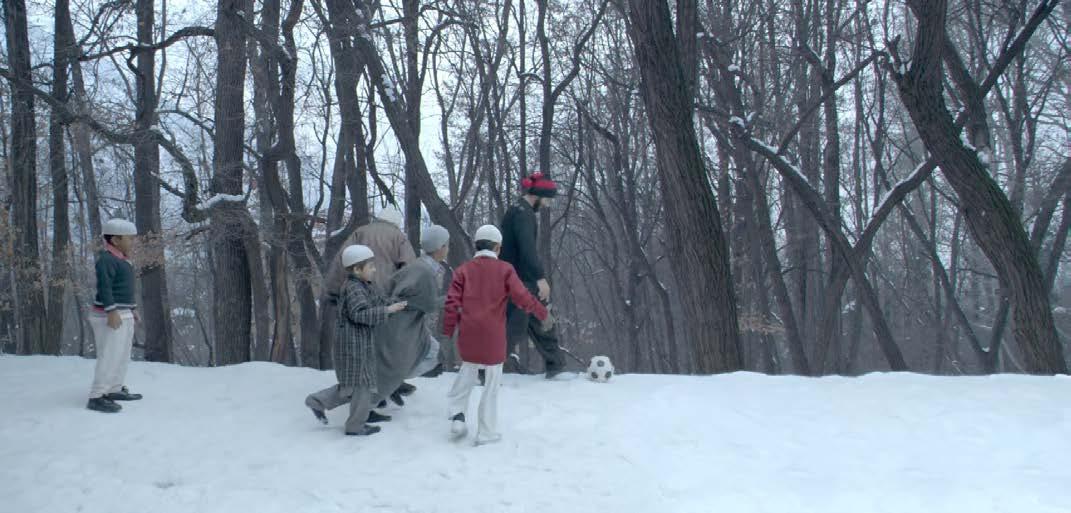

195
Khurram accompanied by Haider goes to the graveyard where Hilaal was buried to perform prayers for the forgiveness of his soul.
Sequence 4.21: Hamlet (1948)




This sequence in the film is known as the ‘mouse trap’. Hamlet directs a play enacting the ‘Murder of Gonzago’ in which he tweaks the scene where the king is murdered so that it resembles how his father was killed. He does it to find out if what the spirit said to him was the truth or is his uncle actually innocent.
Here, sweet lord, at your service
Observe mine uncle. Give him heedful note.
They are coming. I must be idle.
Well, my lord.
The lighting in this sequence plays a very important role in the sequences because it helps in changing the mood and milieu of the setting according to the action happening at that moment. And along with that it also helps in revealing the character’s emotions. This scene starts off with very minimal light because at that time it is just Hamlet and Horatio talking privately to each other. And as the scene progresses and the guest arrive, along with them so do the guards with fired torches in their hands.
196
Horatio!...
Excellent, i’ faith, of the chameleon’s dish. I eat the air, promisecrammed. You cannot feed capons so...
How fares our cousin Hamlet?

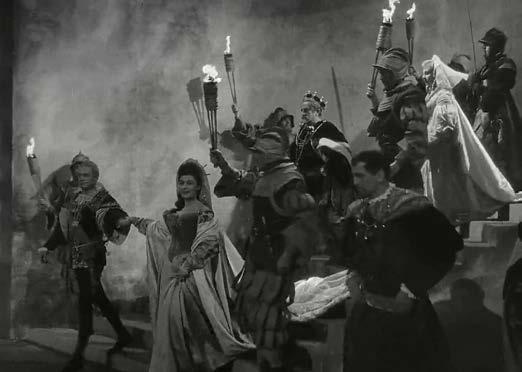


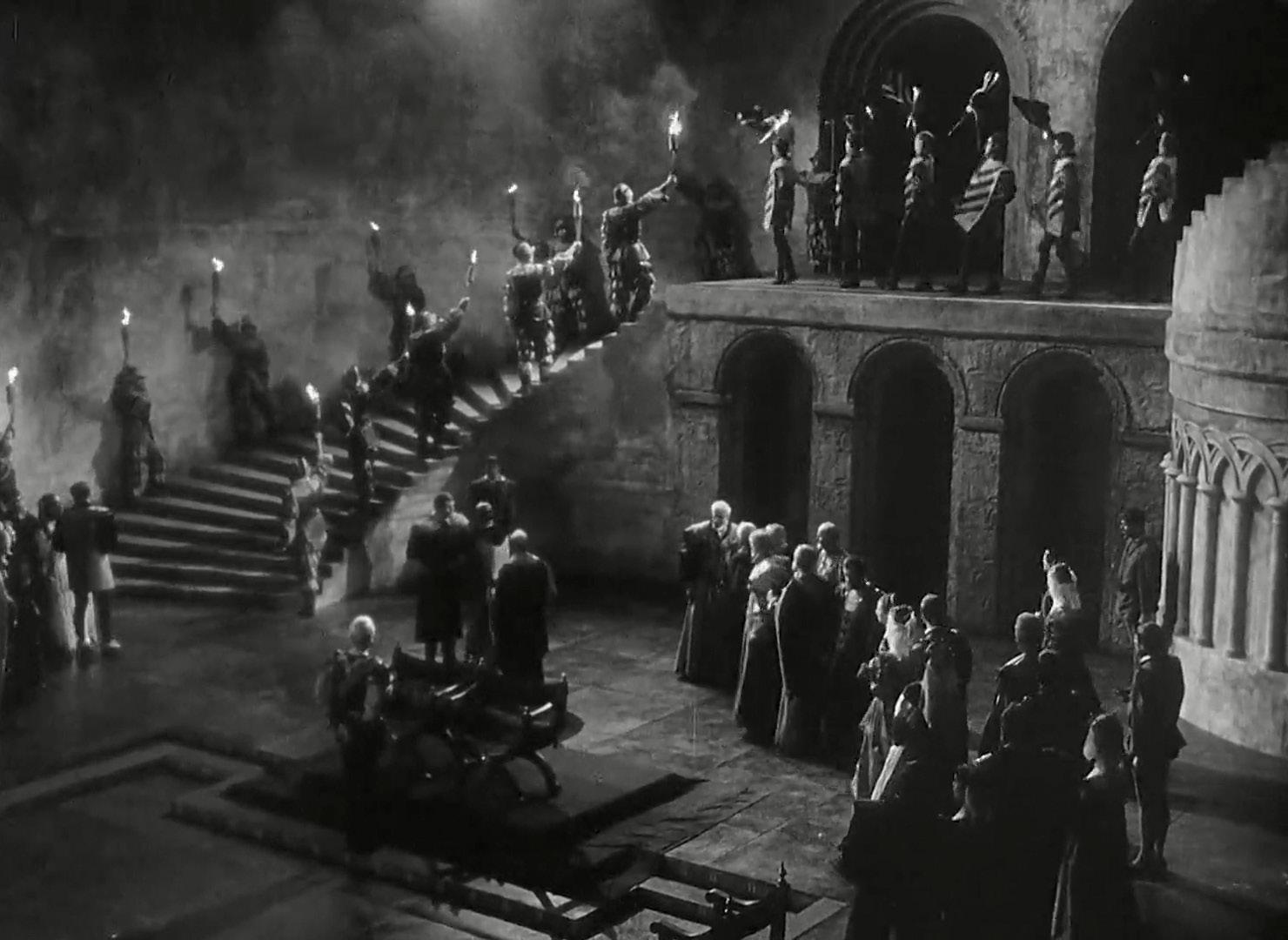
197
The
guest enter the hall along with King Claudius and Queen Gertrude..... PEEPOO! PEEPOPO PEE PO!!








198
Lady, shall I lie in your lap?
No,
my lord.
I
mean my head upon your lap.
O
ho, did you mark that?
You
are merry, my lord.
O
God, your only jigmaker. Why, what should a man do but be merry?
Ay,
my lord.
The play commences and so does the music....
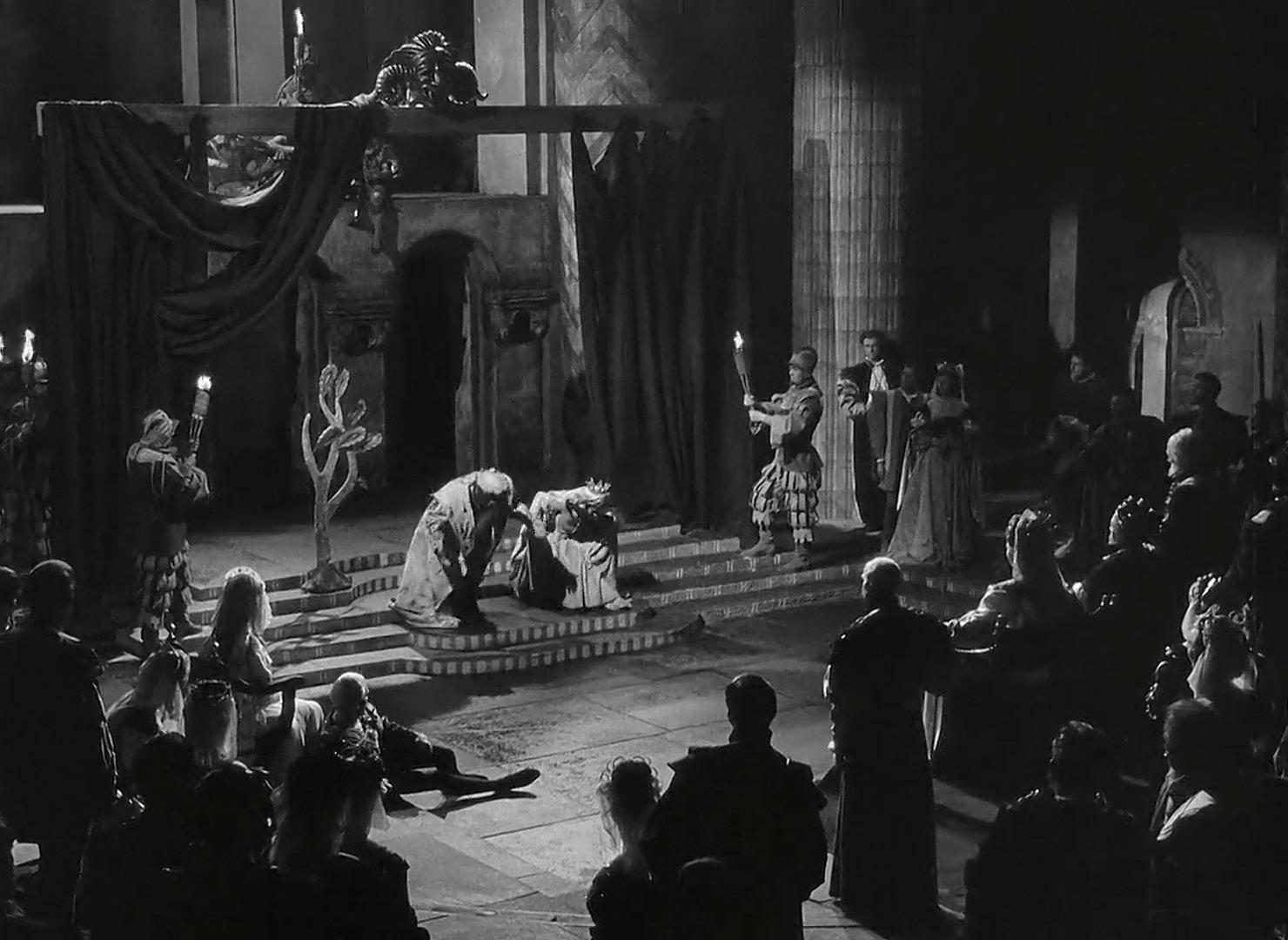



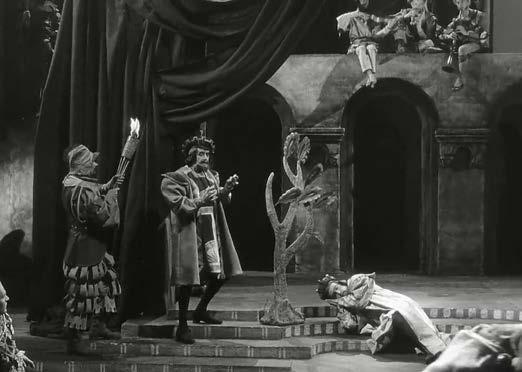
199
It can be seen in the stills above how distinctly King Claudius’s face is lit as compared to the other characters. The light on his face is very stark and bright, to the extent of being blinding. Throughout the story, Claudius is trying to hide his lie and it is his reaction in this scene that exposes his guilty conscience. Having that kind of light on his face is metaphorical to ‘shedding light’ and exposing his lie which was the motive behind the ‘mouse trap’ sequence.
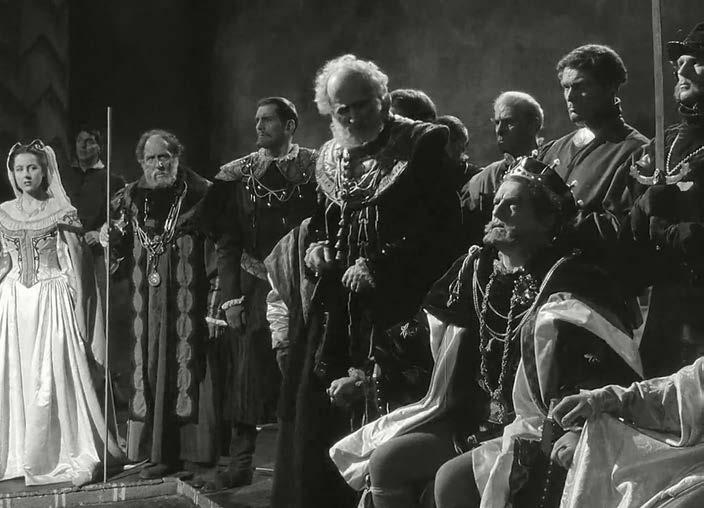



As the scene is played before his eyes, Claudius gets even more uncomfortable because of his guilt....

200
And finally, the scene arrives, where the king is murdered in a similar fashion to how Claudius killed King Hamlet....
Guilty and infuriated, Claudius finally gets up from his seat and leaves the hall, ending the performance abruptly. His reaction makes Hamlet rejoice with joy since the spirit’s claim proves to be true!






201
Give
me some light!
Lights! Lights! (orders to bring out the lights)
Sequence 4.22: Hamlet (1996)


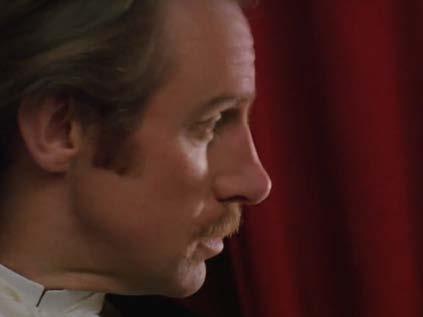

Hamlet explains to Horatio why he is presenting this play and asks him to play along with him by keeping an eye on Claudius’s reaction throughout the duration of the play.
I prithee, when thou seest that act afoot... ...even with the very comment of thy soul observe my uncle. Give him heedful note, for I mine eyes will rivet to his face... ...and after, we will both our judgments join in censure of his seeming.
If he steal aught the whilst this play is playing... ...and scape detecting... ...I will pay the theft.
Well, my lord.
The stage for the play is set up in the same hall where the wedding sequence, as well as Hamlet’s soliloquy, takes place. Although here there is a fair amount of change done to the setting. Firstly, it brings in the steps that were arranged on the edge in the wedding sequence and the stage has been set around it. By doing so not only does it occupy just half the length of the hall, but it also alters the perception making it a little tight and claustrophobic because of the change in proportion. These cramped proportions are metaphorically signify how Claudius is being trapped.


202
Come hither, my good Hamlet. Sit by







No, good mother, here’s metal more
That
Excellent,
203 How fares our cousin Hamlet?
i’ faith,
of the
chameleon’s dish. I eat
the
air, promise-crammed. You
cannot
feed capons so... You
played
once i’ th’ university, you
say?
And
what did
you enact? It was a brute part of him to kill so capital a calf there. (Laughing)
did I, my lord, and was accounted a good actor. I did enact Julius Caesar. I was killed i’ th’ Capitol. Brutus killed me.
me.
attractive. HAHA! HA! HAHA!
Lady, shall I lie in your lap?
You are merry, my lord.
No, my lord.
I mean my head upon your lap.
play commences...
Who, I? Your only jig-maker. What should a man do but be merry? For look you how cheerfully my mother looks, and my father died within’s two hours.
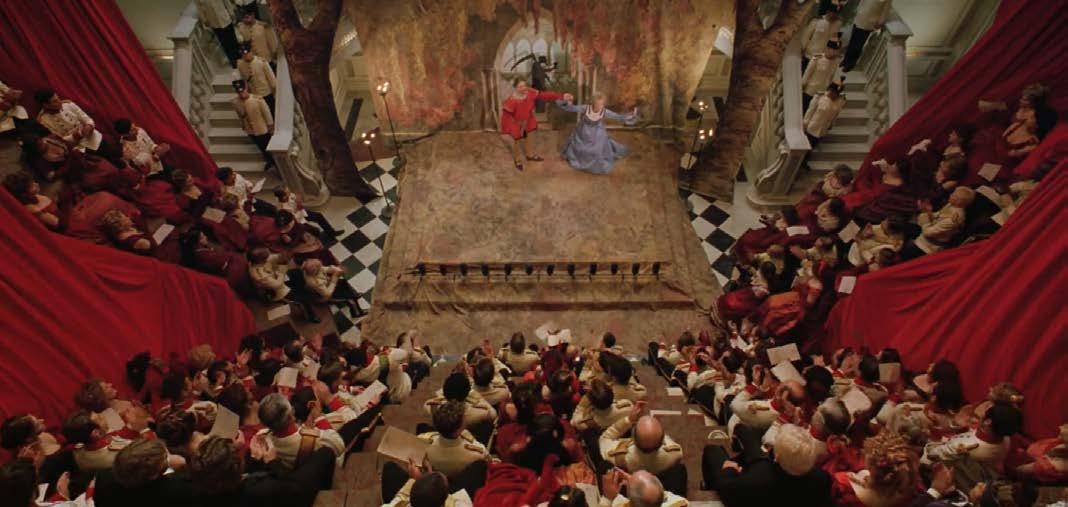






Nay, ‘tis twice two months, my lord.
Ay, my lord.
So long? Nay then, let the devil wear black, for I’ll have a suit of sables. Then there’s hope a great man’s memory may outlive his life half a year.
204
The
Thou mixture rank of midnight weeds collected... with Hecate’s ban thrice blasted, thrice infected.. thy natural magic and dire property...on wholesome life usurp immediately.
The curtains are also used by Horatio to hide behind and spy on Claudius to keep an eye on his reaction to the play. Thus the setting is also in line with the theme of spying carried throughout the film and also in the earlier adaptation.







*GASPS*
He poisons him i’ th’ garden for his estate. His name’s Gonzago. The story is extant, and written in choice Italian. You shall see anon how the murderer gets the love of Gonzago’s wife!
Give me some light!
Infuriated, Claudius rises from his seat and abruptly ends the play. This gesture of his proves his guilt to Hamlet and he rejoices!
205
Haider (2014)
Soon after knowing about Hilaal’s death, Ghazala marries Khurram. Haider is gutted by this but is unable to express his feelings because he still has to find out if what Roohdaar said to him was actually true or not.....
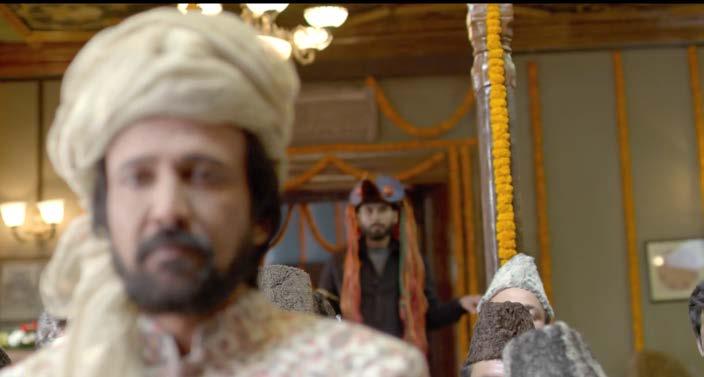

Haider organizes a local performing art form, ‘Bhaand Pather’(folk dance). And through this performance, he narrates a story similar to how his father was killed on Khurram’s orders.

The song was shot at the Martand Sun Temple in Mattan Village. The temple dates back to the 8th century and was destroyed by Sikandar Shah Mir in the 15th century. The dilapidated state of the structure here is a metaphorical ode to Haider’s house, family and emotional state.
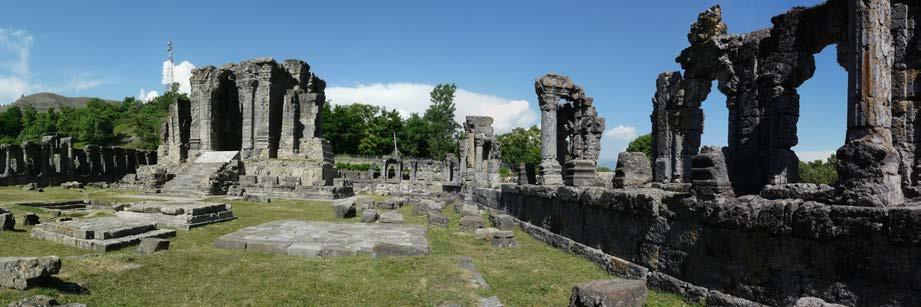

206 Sequence 4.23:
(Fig. 28)
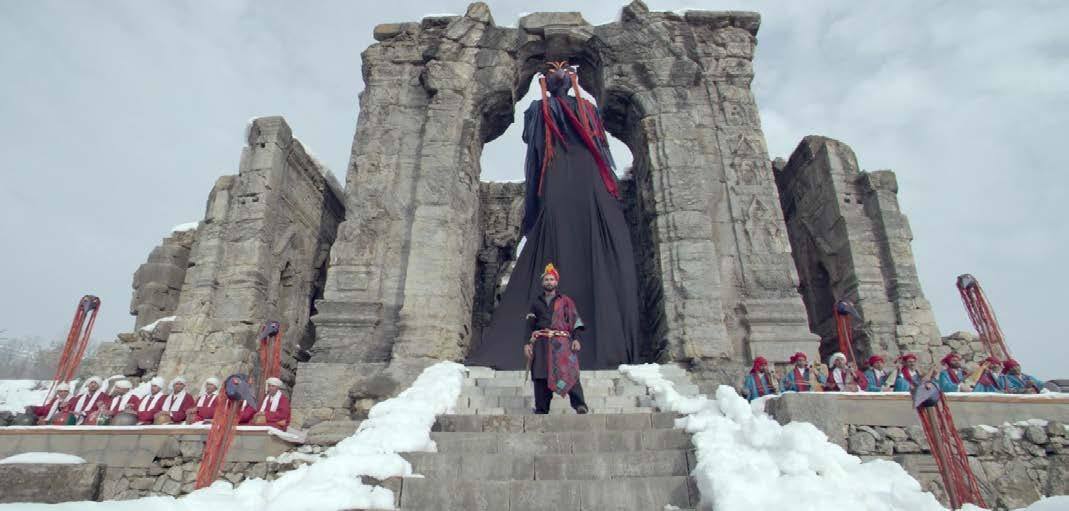

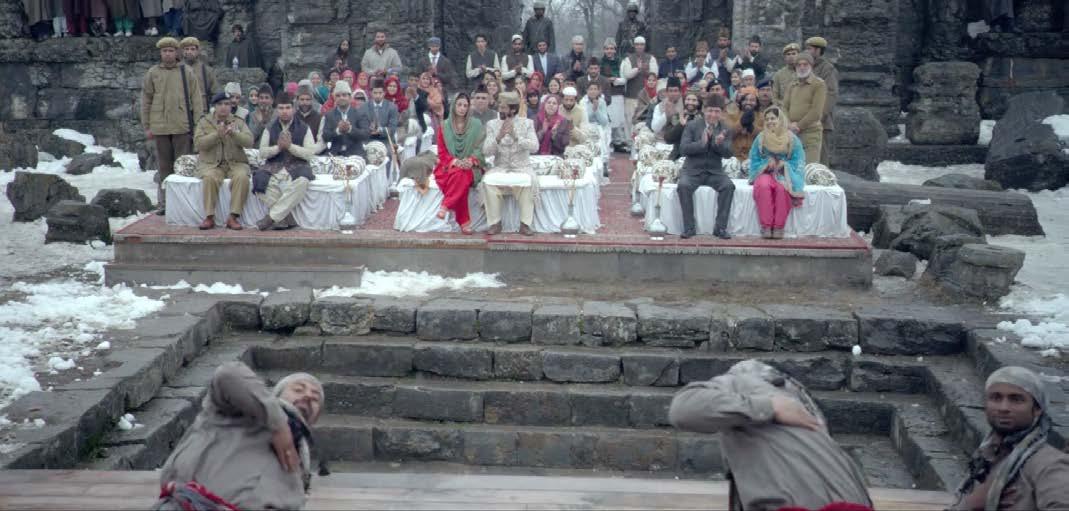

207
*Singing the song ‘Bismil’ *




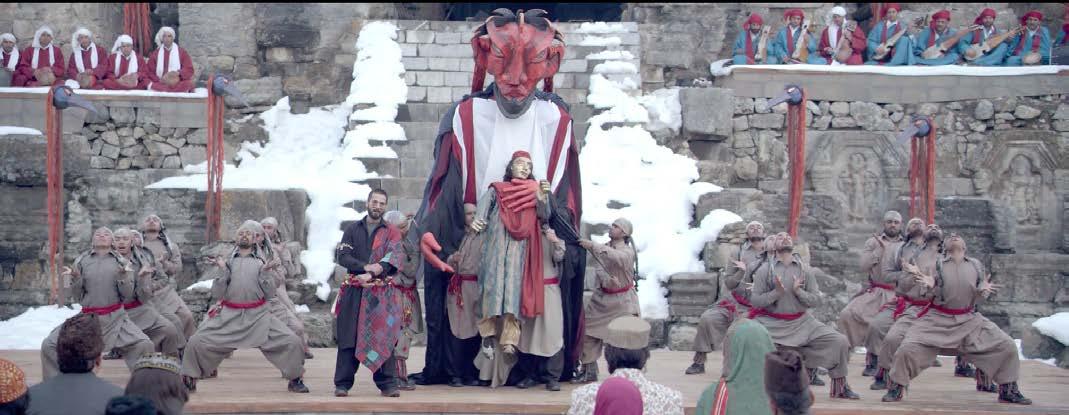

208
The ‘Kund’ in front of the temple, which is also a water body, is symbolically used as the river Jehlum in which Hilaal was thrown after being shot. And Haider climbing out of it shows that Hilaal or his ‘rooh’ (spirit) is back from the dead and (spirit, that is personified by Roohdaar) has caught up with Khurram.
This shot frames Haider in such a way that it emphasizes that he is now being dominated at this point, and it is done using the magnanimous scale of the temple.







After being confronted by Haider, Khurram dismisses his claims and instead accuses Haider of siding with terrorists. Haider is then chased by Parvez’s officers.....

209
Sequence 5.21: Hamlet (1948)



After the play, Hamlet and Horatio celebrate and discuss what they should do next since they now know that Claudius is guilty. And just then Polonius enters the hall again and tells Hamlet that his mother has asked him to go and meet her in her bedroom.
As the instance in the previous sequence, the cyclical motion of the stairs is used to show the constant moral conflict and conundrum going on in the character’s mind throughout the film. And in addition to that, this sequence also uses the contrast of light and sharp shadows to further highlight that feeling. It makes even more sense to do so in this particular sequence because the questions of morality and its ambiguous nature is at the core of it.
‘Tis now the very witching time of night, when churchyards yawn, and hell itself breathes out contagion to this world. Now could I drink hot blood and do such bitter business as the day would quake to look on. Soft... now to my mother. O heart, lose not thy nature. Let not ever the soul of Nero enter this firm bosom. Let me be cruel, not unnatural. I will speak daggers to her, but use none.
Meanwhile in the prayer room, Polonius goes to Claudius to inform him about Hamlet’s meeting with Gertrude....
My lord? He’s going to his mother’s closet. Behind the arras I’ll conceal myself to hear the process.
Fare you well, my liege. I’ll call upon you ere you go to bed and tell you what I know.

210
The Queen, your mother, in most great affliction of spirit, hath sent me to you.
O, my offence is rank. It smells to heaven. It hath the primal eldest curse upon it, a brother’s murder. Pray can I not, though inclination be as sharp as will. What if this cursed hand were thicker than itself with brother’s blood, is there not rain enough in the sweet heavens to wash it white as snow? O, what form of prayer can serve my turn?

O wretched state. O bosom, black as death. Help, angels.


The reason for the sharp shadows is because the only light source in that room are the two candles which are kept very close to each other. Just enough to see the expressions on Claudius and Hamlet’s faces. And the warm light that falls on Claudius’s face symbolizes the moment of truth, goodness, and repentance.




211
As Polonius leaves the room Claudius begins to pray for forgiveness in front of Jesus’s idol...
“Forgive me my foul murder”? That cannot be, since I am still possessed of those effects for which I did the murder - my crown, mine own ambition, and my Queen.
Now might I do it pat, now he is praying. And now I’ll do it. And so he goes to heaven. And so am I revenged. That would be thought on....


A villain kills my father, and for that I, his sole son, do this same villain send to heaven.

O, this is hire and salary, not revenge. He took my father all his crimes full blown, as flush as May. And how his audit stands, who knows save heaven? But in our circumstance and course of thought ‘tis heavy with him. And am I then revenged to take him in the purging of his soul, when he is fit and seasoned for his passage?

212
Hamlet, on his way up to the bedroom, sees Claudius in the prayer room. And since there is no one present except the two of them, he decides to take his revenge then and there itself.....
No!
Up, sword, and know thou a more dark intent, when he is drunk asleep, or in his rage, or in the incestuous pleasure of his bed, at gaming, swearing, or about some act that has no relish of salvation in it



My words fly up, my thoughts remain below.
Words without thoughts never to heaven go.
Then trip him that his heels may kick at heaven and that his soul may be as damned and black as hell whereto it goes.


My mother stays. This physic but prolongs thy sickly days.

213
*Sobbing*
Sequence 5.22: Hamlet (1996)
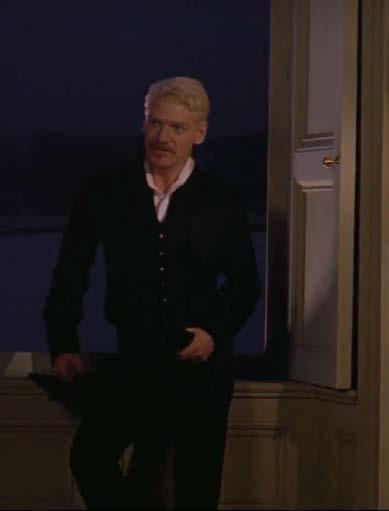
Claudius and Polonius discuss what must be done further to understand what’s going on in Hamlet’s mind and what must be done to curb his plans.
Claudius and Polonius exit the room through a secret door. Throughout the film there are many such instances where characters are see entering and exiting room through such openings, and it is through these openings that we are symbolically shown how the characters have hidden secrets inside them just like the setting they inhabit.
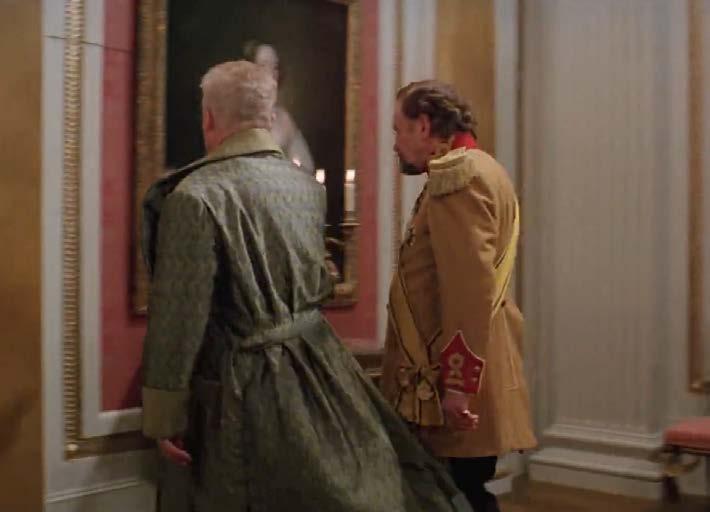

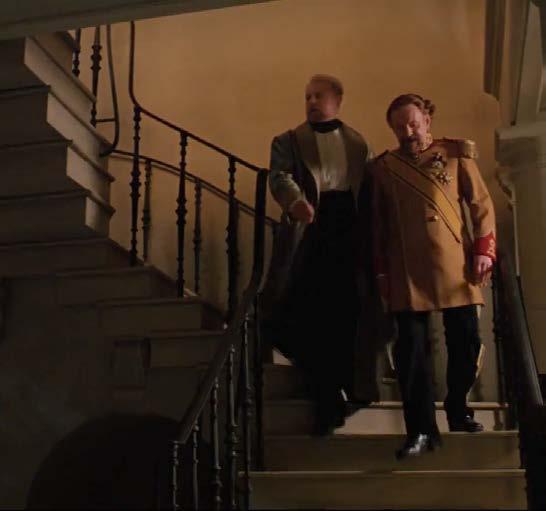

‘Tis now the very witching time of night, when churchyards yawn, and hell itself breathes out contagion to this world. Now could I drink hot blood and do such bitter business as the day would quake to look on. Soft...now to my mother. O heart, lose not thy nature. Let not ever the soul of Nero enter this firm bosom. Let me be cruel, not unnatural. I will speak daggers to her, but use none.
I’ll warrant she’ll tax him home. And, as you said-- And wisely was it said. --’tis meet that some more audience than a mother...since nature makes them partial, should o’erhear the speech of vantage.
Thanks, dear my lord.
Fare you well, my liege. I’ll call upon you ere you go to bed and tell you what I know.
Meanwhile, before going to meet Gertrude Hamlet contemplates his next step since he is now sure of Claudius’s guilt.....
214
My lord? He’s going to his mother’s closet. Behind the arras I’ll convey myself to hear the process.
This setting, similar to the 1948 adaptation has relatively dim and intense lighting which creates some dark shadows. Although here the candles aren’t the only source of light and neither is the room too dark. There is also another light source on the left side (presumably a window) that illuminates Claudius’s face while he speaks, which for that moment, symbolically gives him a moral high ground as he confesses his crime.



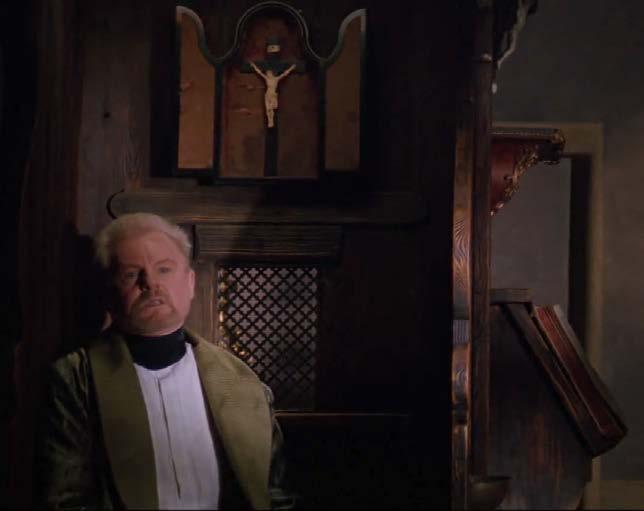
And what’s in prayer but this twofold force, to be forestalled ere we come to fall... or pardoned being down? Then I’ll look up. My fault is past. But, O, what form of prayer can serve my turn? “Forgive me my foul murder”? That cannot be, since I am still possessed of those effects for which I did the murder - my crown, mine own ambition, and my Queen.
O, my offence is rank. It smells to heaven. It hath the primal eldest curse upon it, a brother’s murder. Pray can I not, though inclination be as sharp as will. ...my stronger guilt defeats my strong intent. And like a man to double business bound, I stand in pause where I shall first begin... and both neglect. What if this cursed hand were thicker than itself with brother’s blood, is there not rain enough in the sweet heavens to wash it white as snow? Whereto serves mercy but to confront the visage of offense?
O wretched state. O bosom, black as death. Help, angels. And heart with strings of steel, be soft as sinews of the newborn babe.
As Claudius confesses to his crimes, Hamlet suddenly enters the chapel and sits on the other side of the confession box....
A confession box is a place where a person goes to admit his/her crime in order to clear one’s mind off the guilt without having to be judged. It is meant to be a very sacred space where the person seeks forgiveness with honesty. Since this scene plays on the aspect of morality and forgiveness, the setting becomes apt for it.
215
After Polonius leaves, Claudius goes into the confession box in the chapel...
Now might I do it pat, now he is praying. And now I’ll do it. And so he goes to heaven. And so am I revenged. That would be scanned. A villain kills my father, and for that... I, his sole son, do this same villain send to heaven.

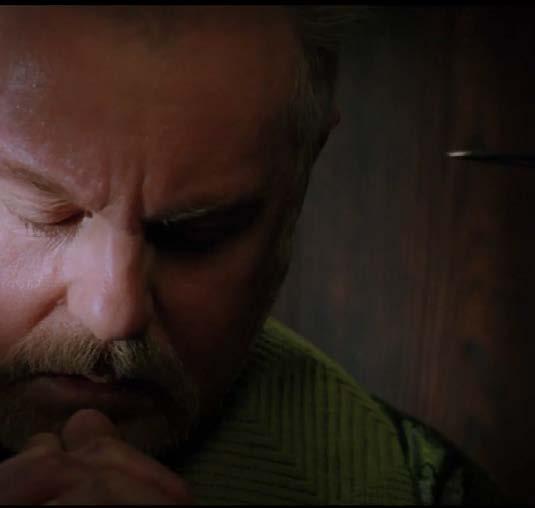
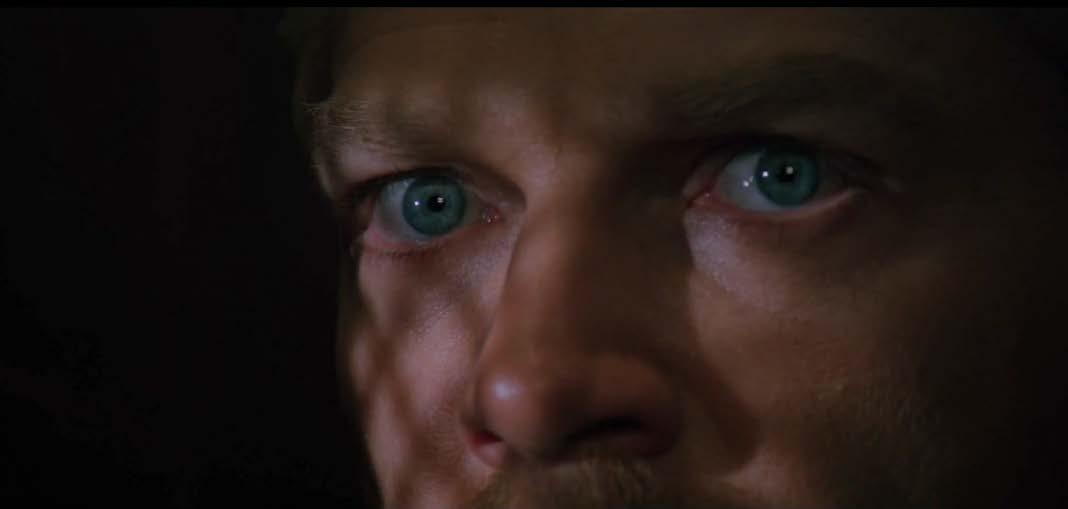
O, this is hire and salary, not revenge. He took my father grossly, full of bread... with all his crimes broad blown, as flush as May. And how his audit stands, who knows save heaven? But in our circumstance and course of thought... ’tis heavy with him. And am I then revenged to take him in the purging of his soul... when he is fit and seasoned for his passage?

216
NO!
Hamlet suddenly stops.....
Up, sword, and know thou a more horrid hent. When he is drunk asleep... or in his rage... or in the incestuous pleasure of his bed... at game, a-swearing, or about some act that has no relish of salvation in’t... then trip him,that his heels may kick at heaven... and that his soul may be as damned and black... as hell whereto it goes. My mother stays. This physic but prolongs thy sickly days. My words fly up, my thoughts remain below.

There is also this small window with a metal grill (the spacing just enough for Hamlet to pass his weapon), usually through which the pastor listens to the other person confiding in him. Here it’s Hamlet who sits on the other side of the window listing to his uncle’s confession. One of the reasons why he doesn’t go ahead with the murder is because that position doesn’t allow him to judge Claudius, only if it is for that brief period.
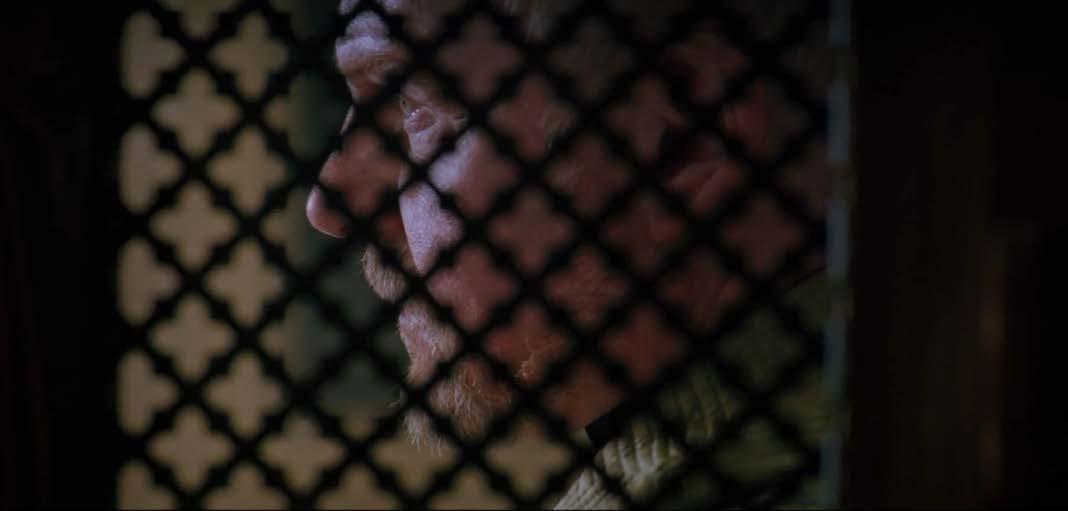

217
Sequence
Haider (2014)


After being badly hit on his face and caught by the Salman brothers, Haider is taken to Khurram’s house for treatment at Ghazala’s insistence. He wakes up the next day and realizes that he is in that house....


Haider recalls that he had hidden the gun (given by Roohdaar) behind the flush tank.... And decides to take this opportunity and avenge his father by killing Khurram....

218
5.23:



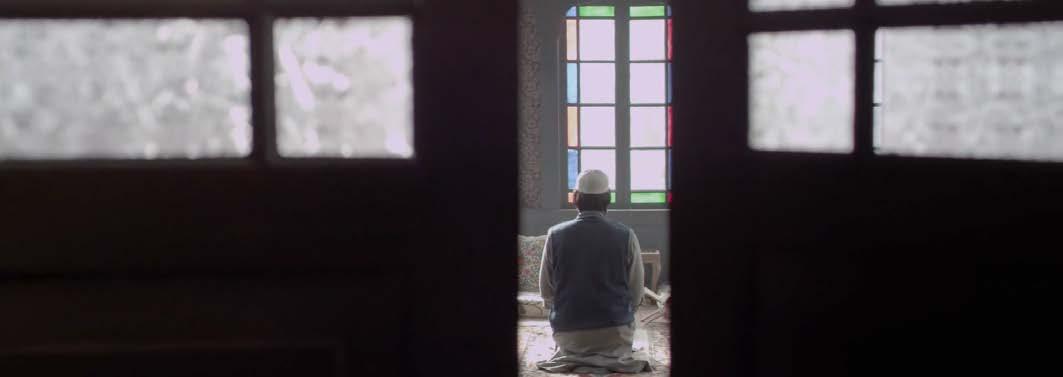

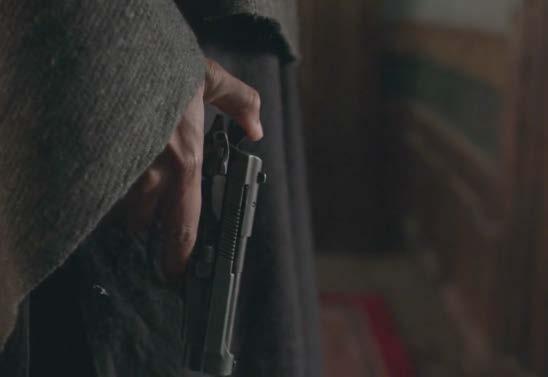
219 Haider looks
for Khurram
and
finds
him sitting on the floor, praying.... *Intense music plays
in the background*
CLICK!
Haider walks towards Khurram in rage with the gun in his hand. While Khurram is praying facing the window on the opposite side, unaware of Haider’s action...
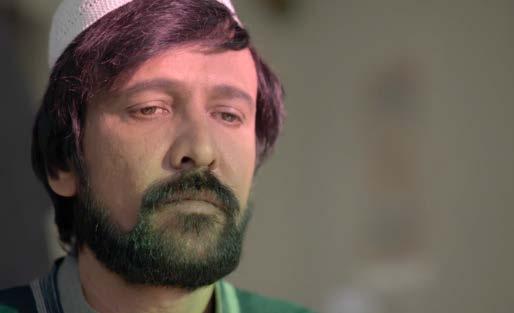
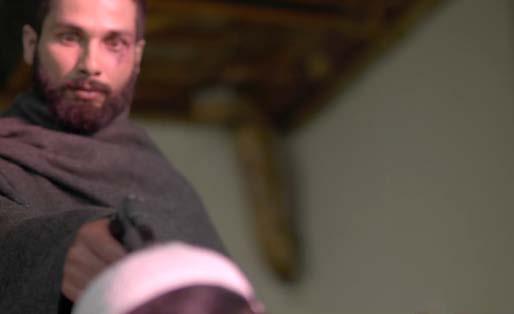




One could draw parallels as to how light is instrumental in each of these adaptations of the same sequence. In all three of them, it is considered divine through its symbolic use and representation in these scenes.

220
My Lord... my crime, my sin stinks... I’m drowning in guilt. My soul reeks of my brother’s blood... Wash me clean...with the rain of your mercy, My Lord! Bereave me of all you bestowed... All the wealth, all the power, all the fame.. Everything... cleanse me, my Lord!
I didn’t kill you for you were in prayer... Even a ghastly sinner would enter heaven if killed in prayer...
Here just like in the other two sequences Khurram’s face is also covered in light, although in this case, it is the natural light that comes filtering through the tinted glass panes of the windows. As soon as the light falls on Haider’s face, in a few seconds, he withdraws his gun and decides against killing him at that moment. And this decision has to do with what light represents and how it is interpreted by the film and its characters.

And just as Haider decides to leave the room, Parvez, with the Salman brothers enters the house and catches him with the gun....





I will kill you... when you are in sin... not when you are in prayer... I’ll aim my bullets at your treacherous eyes, Khurram...those deceitful eyes that entrapped my mother.

221
Give
me the pistol...!
Grab him... Hold his hands...
Conclusion
Through the analysis of sequences, the intent was to show how in similar stories the different architectural settings add layers to the scene and how it communicates with the audience in tandem with the actors playing the characters. This in turn informs the plot and takes the story forward.
The initial chapters defined what an ‘architectural setting’ is, what is a ‘character’(living\animate’) in terms of how it is written in a screenplay, and lastly ‘what is a character in architecture’. After studying these, the elements of a ‘character’(living\ animate’) and elements that give ‘character to architecture’ were brought together using the parameters of ‘Context’ and ‘Subtext and Metaphor’. This intersection gave us the Elements of ‘Architectural setting as a Character in Cinema’(Ch 2.3).
These were then identified in the case studies, where it was found that most sequences touched upon each of those aspects in some or other way . But those could not be individually dissected because more often than not, a setting talks about more than one of the given seven aspects that are linked to ‘Context’ as well as ‘Subtext and Metaphor’. Examples of a few of the complex sequences can be seen in these images explained by the caption below (Fig 29, 30, 31).
And because of these factors, the architectural observations were presented through short narratives that explained the relevance of the architectural setting concerning the sequence keeping in mind the various elements that come together to make the architectural setting a character.
(Fig. 29) This still is from the sequence (2.13) of the film ‘The Tragedy Of Macbeth’ (2021) .
The still communicates multiple things like the contextual elements in terms of where the corridor is and its orientation. Along with this it also talks about the conundrum in Macbeth’s mind through the play of light and shadow.

(Fig. 30) This still is from the sequence (1.22) of the film ‘Hamlet’ (1996)
The architectural style of the palace tells us that it was built in the Baroque period. But the inherent loudness of the architectural style is also in sync with the way the characters have been portrayed by the actors.
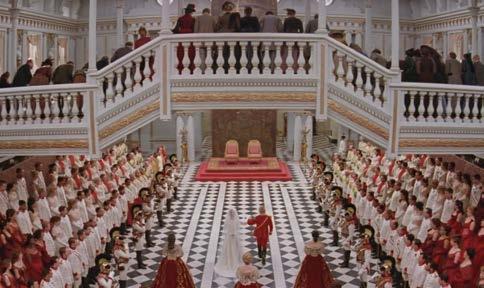
(Fig. 31) This still is from the sequence (1.21) of the film ‘Hamlet’ (1948)
This image informs the audience that the castle is located on the edge of the sea and comprises of a number of towers. The sheer number of towers and staircases symbolically synchronizes with the theme of spying and conflict that the film explores.

222
The most essential thing for a story to exist is its characters(living\animate’). A story is either about a particular character, its peculiarities and its journey or about an event and how the characters react to it. Thus it can be said that the importance of the characters (living\animate’) and the event keeps changing from story to story. Both the plays that have been studied here, namely Macbeth and Hamlet, are character (living\animate’)-driven stories.
So, the story revolves around how the characters (living\animate’) react to an event and what transpires because of their respective reaction and how it affects the rest of the characters (living\ animate’) in the story. The architectural setting of the respective adaptations also keeps reacting and changing form based on its physical context and also how the characters (living\animate’) use the spaces.
There have also been instances where the setting has been similar but the perception of the space changes depending upon the character’s (living\ animate’) mental space at that given point and as compared to some other sequence(Fig. 32, 33). This, aided by some Elements of ‘Architectural setting as a Character in Cinema’(Ch 2.3) give it its characteristics. They change the meaning and perception of the space which in turn affects how the scene is understood by the audience.
(Fig. 32) This still is from the sequence (2.11) of the film ‘Macbeth’ (1948).


Lady Macbeth’s dark desires are portrayed with the lack of light that falls on her and the surroundings when she moves down the steps to convince Macbeth to murder Duncan and claim the throne.
(Fig. 33) This still is from the sequence (5.11) of the film ‘Macbeth’ (1948).
Contrary to the previous sequence, here the guilt of killing Duncan has caught up with her and she has begun to sleepwalk through the night trying to wash the blood off her hands. Although this sequence also takes place on the same staircase, the way it is perceived and experienced is completely different as now there is ample amount of light as compared to the previous sequence, which shows the change in her intentions.
223
Similarly, when a similar scene is being portrayed in different adaptations, even though the crux of what is being done and said is similar, the experience of the sequence is very different depending upon the emotion and ideology the director wishes to accentuate and express (Fig 34, 35, 36). And it is the architectural setting that makes it possible. This indicates that the architectural setting has the attributes and the range to express different emotions just like the actors portraying the characters(‘living\animate’) in films.
What can also be understood is that the characters (‘living\animate’) in the film are aided by the architectural setting to emote and similarly, the architectural setting is also dependent upon the characters(‘living\animate’) in the film to give it meaning and communicate with the audience. The following examples (Fig. 37 , 38, 39,40) will further help in demonstrating the interdependent nature of the architectural setting and the characters portrayed by the actors.
From all these examples as well as the case studies, what can be understood is that it is actually difficult to make sense of the setting without the characters(‘living\animate’) in it, and the fact that both contribute to the action that takes place on the screen. And as William James said in ‘The Art of Fiction,: “What is character but the determination of incident? And what is incident if not the illumination of character?”45
The architectural setting fulfills both these criteria when it uses the element of ‘Context’ to help determine the ‘incident’ and ‘Subtext and Metaphor’ that illuminates and brings forth the true nature of the characters(‘living\animate’) in cinema, thus becoming a character in itself.
45 Field Syd, ‘Screen Play: The Foundations of Screenwriting’,Originally published on July 1984, Revised edition
2005,
Sequence 3.2 ‘To be or not to be soliloquy’ comparison
(Fig. 34) This still is from the sequence (3.21) of the film ‘Hamlet’ (1948).
To accentuate the conflicted and vulnerable side of Hamlet, this sequence was shot on of the many towers of the castle as he sits on the edge delivering his soliloquy.
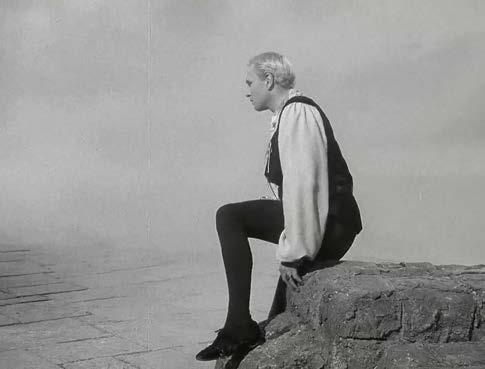
(Fig. 35) This still is from the sequence (3.22) of the film ‘Hamlet’ (1996).
The architectural setting for this sequence in this adaption was a hall of mirrors to highlight Hamlet’s self reflection with his real self and reflection merging with each other.

(Fig. 36) This still is from the sequence (3.23) of the film ‘Haider’ (2014).
The film has a political undertone in its story telling commenting on Armed Forces (Special Power) Act 1958. Laal Chowk the place where Haider delivers his speech is important to the political history of Kashmir and Srinagar .

224
December
Pg. 43
(Fig. 37 , 38) These stills are from sequence (5.23) of the film ‘Haider’ (2014).
(Fig. 37) Is the still from sequence where Khurram is praying and Haider contemplates to kill him . The light that comes through the window and falls on Khurram is used to create a divine atmosphere because he is repenting his sins. But when Khurram is removed from the scene (Fig. 38) it is difficult to understand its relevance.


(Fig. 39, 40) These the stills from sequence (2.13) of the film ‘The Tragedy Of Macbeth’ (2021)
Here Macbeth is depicted as a dark dominating figure as the light coming through the window creates contrast in the image. His dominating presence is further aided by tall rectangular window with Gothic proportions which accentuate his towering evil presence after killing Duncan. Whereas, in the other image (Fig. 40) we only see Macbeth as a dark figure devoid of any context which makes it difficult to understand anything apart from the fact that he is standing next to the bed after killing Duncan.


225
Image credits
List of Images Credits
Fig. 1 Theatre Of Dionysus, Athens, Greece
Fig. 2 Image from the set of the film ‘Rear Window’ (1954) Directed by Alfred Hitchcock
Fig. 3 Sketch for the rotating set for the antigravity scene by Guy Hendrix Dyas (production designer) for ‘Inception’ (2010)
Fig. 4 Nat Karson’s ground floor plan (below) and elevation (above) for the ‘Voodoo’ Macbeth.
Fig. 5 This still is from the play ‘Voodoo’ Macbeth (1936) directed by Orson Welles
Fig. 6 This still is from the play ‘Hamlet’ (1936) directed by and starring Richard Burton
Fig. 7 This still is from the film Citizen Kane (1941) Directed by Orson Welles.
Fig. 8 Relationship between ‘Architectural setting in cinema’ and ‘Characters (‘living\ animate’) in cinema’
Fig. 9 This is a still from the film ‘Edward Scissorhands’ (1990) directed by Tim Burton.
Fig. 10 This is a still from the film ‘Citizen Kane’ (1941) directed by Orson Welles.
Fig. 11 This is a stills from the film ‘Justice League-the Snyder cut’ (2021) directed by Zack Snyder.
Fig. 12 This is a stills from the film ‘Justice League-the Snyder cut’ (2021) directed by Zack Snyder.
Fig. 13 This is a still from the film ‘No time to die’ (2021) directed by Cary Fukinaga.
Fig. 14 This is a still from the film ‘A Quiet Place’(2018) directed by John Krasinski.
Cartwright, Mark, Theatre of Dionysos Eleuthereus, Athens, published on 07 April 2015
Image from the set of the film ‘Rear Window’ (1954)
Dyas , Guy Hendrix. Sketch for the Rotating Set for the AntiGravity Scene
Karson , Nat. Plan and Elevation for the ‘Voodoo’ Macbeth.
KentAllard, director. ‘Voodoo’ Macbeth. YouTube, YouTube, 11 July 2006, https://www.youtube.com/watch?v=QZLrqJka-EU. Accessed 20 Jan. 2022.
ShakespeareNetwork, director. Hamlet. YouTube, YouTube, 14 May 2021, https://www.youtube.com/watch?v=vABGEzB7T9M. Accessed 22 Jan. 2022.
Welles, Orson, director. Citizen Kane. Mercury for RKO, 1941.
Author Burton, Tim, director. Edward Scissorhands . Denise Di Novie, 1990.
Welles, Orson, director. “Citizen Kane”. Mercury for RKO, 1941.
Snyder, Zack , director “Justice League : Snyder Cut.” Warner Brothers, 2021
Snyder, Zack , director “Justice League : Snyder Cut.” Warner Brothers, 2021
Fukinaga , Cary , director “No time to die’.” Metro-GoldwynMayer (MGM), 2021
K rasinski , John , director “A Quiet Place’.” Platinum Dunes, Sunday Night Productions, 2018
List of Images Credits
Fig. 15 This is a still from the film ‘Pather Panchali’ (1955) directed by Satyajit Ray.
Fig. 16 This is a still from the film ‘Pather Panchali’ (1955) directed by Satyajit Ray.
Fig. 17 This is a still from the film ‘The Godfather’ (1972) directed by Francis Ford Coppola
Fig. 18 This is a still from the film ‘The Godfather’ (1972) directed by Francis Ford Coppola
Fig. 19 This is a still from the film ‘Barfi’(2012) directed by Anurag Basu.
Fig. 20 This is a still from the film ‘Barfi’(2012) directed by Anurag Basu.
Fig. 21 This is a still from the film ‘Her’(2013) directed by Spike Jones
Fig. 22 This is a still from the film ‘Tamasha’(2015) directed by Imtiaz Ali.
Fig. 23 This is a still from the film ‘The French Dispatch’(2022) directed by Wes Anderson.
Fig. 24 This is a still from the film ‘Strike’(1925) directed by Sergei Eisenstein.
Fig. 25 This is a still from the film ‘Metropolis’(1927) directed by Fritz Lang.
Fig. 26 This is a still from the film ‘Parasite’(2019) directed by Bong Joon-ho.
Fig. 27 This is a still from the film ‘Parasite’(2019) directed by Bong Joon-ho.
Fig. 28 Martand Temple, Kashmir
Ray, Satyajit , director “Pather Panchali’.” Government of West Bengal, 1955
R ay, Satyajit , director “Pather Panchali’.” Government of West Bengal, 1955
C oppola ,Francis, Ford , director “The Godfather’.” Paramount Pictures, 1972
C oppola ,Francis, Ford , director “The Godfather’.” Paramount Pictures, 1972
Basu , Anurag , director “Barfi’.” UTV Motion Pictures, 2012
B asu , Anurag , director “Barfi’.” UTV Motion Pictures, 2012
Jones , Spike , director “Her’.” Annapurna Pictures, 2013
A li , Imtiaz , director “Tamasha .”Nadiadwala Grandson Entertainment, 2015
A nderson , Wes , director “The French Dispatch .”Indian Paintbrush, 2021
E isenstein , Sergei , director “Strike .”1st Goskino Factory, 1925
L ang, Fritz , director “Metropolis.”Erich Pommer , 1927
Joon-hoo, Bong , director “Parasite.”Barunson E&A. , 2019
Joon-hoo, Bong , director “Parasite.”Barunson E&A. , 2019
Kapur, Varun, Shiv https://www.flickr.com/photos/ varunshiv/6134373122/; Sept 11, 2011
List of Images Credits
Fig. 29 This still is from the sequence (2.13) of the film ‘The Tragedy Of Macbeth’ (2021) .
Fig. 30 This still is from the sequence (1.22) of the film ‘Hamlet’ (1996).
Fig. 31 This still is from the sequence (1.21) of the film ‘Hamlet’ (1948).
Fig. 32 This still is from the sequence (2.11) of the film ‘Macbeth’ (1948).
Fig. 33 This still is from the sequence (5.11) of the film ‘Macbeth’ (1948).
Fig. 34 This still is from the sequence (3.21) of the film ‘Hamlet’ (1948).
Fig. 35 This still is from the sequence (3.22) of the film ‘Hamlet’ (1996).
Fig. 36 This still is from the sequence (3.23) of the film ‘Haider’ (2014).
Fig. 37 This still is from the sequence (5.23) of the film ‘Haider’ (2014).
Fig. 38 This still is from the sequence (5.23) of the film ‘Haider’ (2014).
Fig. 39 This still is from the sequence (2.13) of the film ‘The Tragedy Of Macbeth’ (2021)
Fig. 40 This still is from the sequence (2.13) of the film ‘The Tragedy Of Macbeth’ (2021)
“The Tragedy Of Macbeth”A24, Apple TV , 2021
B ranagh, Kenneth , director “Hamlet”Columbia Pictures, Castle Rock Entertainment., 1996
O liver, Lawrence , director “Hamlet” Two Cities, 1948
Welles, Orson, director. “Macbeth”. Mercury for RKO, 1948.
Welles, Orson, director. “Macbeth”. Mercury for RKO, 1948.
Oliver, Lawrence , director “Hamlet” Two Cities, 1948
B ranagh, Kenneth , director “Hamlet”Columbia Pictures, Castle Rock Entertainment., 1996
B hardwaj, Vishal , director “Haider”UTV Motion Pictures, VB Pictures, 2014
B hardwaj, Vishal , director “Haider”UTV Motion Pictures, VB Pictures, 2014
B hardwaj, Vishal , director “Haider”UTV Motion Pictures, VB Pictures, 2014(edited by author)
C oen, Joel , director “The Tragedy Of Macbeth”A24, Apple TV , 2021
C oen, Joel , director “The Tragedy Of Macbeth”A24, Apple TV , 2021 (edited by author)
List of Sequences Credits
Ch 3.11 Macbeth
Sequence 1.11
Sequence 2.11
Sequence 3.11
Sequence 4.11
Sequence 5.11
Sequence 1.12 Sequence 2.12
Sequence 3.12
Sequence 4.12 Sequence 5.12
Sequence 1.13 Sequence 2.13
Sequence 3.13
Sequence 4.13 Sequence 5.13
Sequence 1.14 Sequence 2.14 Sequence 3.14 Sequence 4.14 Sequence 5.14
Welles, Orson, director. “Macbeth”. Mercury for RKO, 1948.
Kurosawa, Akira, director. “Macbeth”. Sojiro Motoki, Akira Kurosawa, 1957.
C oen, Joel , director “The Tragedy Of Macbeth”A24, Apple TV , 2021
B hardwaj, Vishal , director “Maqbool”Bobby Bedi, 2004
Image credits for graphical study/ Ch- 3 Case studies
List of Sequences Credits
Ch 3.12 Hamlet
Sequence 1.21
Sequence 2.21
Sequence 3.21
Sequence 4.21 Sequence 5.21
Sequence 1.22 Sequence 2.22
Sequence 3.22
Sequence 4.22 Sequence 5.22
Sequence 1.23 Sequence 2.23
Sequence 3.23 Sequence 4.23 Sequence 5.23
Oliver, Lawrence , director “Hamlet”Two Cities, 1948
B ranagh, Kenneth , director “Hamlet”Columbia Pictures, Castle Rock Entertainment., 1996
B hardwaj, Vishal , director “Haider”UTV Motion Pictures, VB Pictures, 2014
230
List of Sequences Credits
Ch 3.11 Macbeth
Sequence 1.11
Sequence 2.11
Sequence 3.11
Sequence 4.11
Sequence 5.11
Sequence 1.12
Sequence 2.12
Sequence 3.12
Sequence 4.12
Sequence 5.12
Sequence 1.13
Sequence 2.13
Sequence 3.13
Sequence 4.13
Sequence 5.13
Sequence 1.14
Sequence 2.14 Sequence 3.14 Sequence 4.14 Sequence 5.14
Original screenplay writers (adaptation): Welles, Orson, Screenplay of. “Macbeth”. Mercury for RKO, 1948.
Text obtained from: “Macbeth.” Macbeth Movie Script, 5 Aug. 2018, https://www. scripts.com/script/macbeth_13091. Accessed 7 May. 2022.
Original (Japanese) screenplay writers (adaptation): Hashimoto, Shinobu; Kurosawa, Akira; Kikushima, Ryuzu; Ougni, Hideo; Screenplay of. “Throne of blood”. Sojiro Motoki, Akira Kurosawa, 1957.
Text (translated) obtained from: Throne of Blood (1957) Script, TranscriptDB, https://transcripts. thedealr.net/script.php/throne-of-blood-1957-DAL. Accessed 9 May. 2022.
Original screenplay writers (adaptation): Coen, Joel , Screenplay of “ The Tragedy Of Macbeth”A24, Apple TV , 2021
Text obtained from: “The Tragedy of Macbeth.” The Script Lab, https:// thescriptlab.com/property/the-tragedy-of-macbeth/.Accessed 11 May. 2022
Original (Hindi) screenplay writers (adaptation): Bhardwaj, Vishal ; Tyrewala, Abbas , Screenplay of “Maqbool”Bobby Bedi, 2004
Text (translated) obtained from: Maqbool Script Film Companion. https://filmcompanion.in/wpcontent/uploads/2018/01/Maqbool-Script-Film-Companion. pdf. Accessed 11 May. 2022
231
Dialogue credits for graphical study/ Ch- 3 Case studies
List of Sequences Credits
Ch 3.12 Hamlet
Sequence 1.21
Sequence 2.21
Sequence 3.21
Sequence 4.21 Sequence 5.21
Sequence 1.22 Sequence 2.22
Sequence 3.22
Sequence 4.22 Sequence 5.22
Sequence 1.23 Sequence 2.23
Sequence 3.23 Sequence 4.23 Sequence 5.23
Original screenplay writers (adaptation): Oliver, Lawrence , Screenplay of “Hamlet”Two Cities, 1948
Text obtained from: “Ultimate Subtitles Source.” YIFYSubtitles, https:// yifysubtitles.org/subtitles/hamlet-1948-english-yify-264951. Accessed 18 April. 2022
Original screenplay writers (adaptation): Branagh, Kenneth , Screenplay of “Hamlet”Columbia Pictures, Castle Rock Entertainment., 1996
Text obtained from: “Hamlet.” Hamlet Movie Script, https://www.scripts.com/ script/hamlet_9520. Accessed 18 April. 2022
Original (Hindi) screenplay writers (adaptation): Bhardwaj, Vishal ; Peer, Basharat, Screenplay of “Haider”UTV Motion Pictures, VB Pictures, 2014
Text (translated) obtained from: Haider Script Film Companion. https://www.filmcompanion. in/wp-content/uploads/2018/01/Haider-Script-FilmCompanion.pdf. Accessed 18 April. 2022
232
Bibliography
Books and Thesis
Calvino, Italo, and William Weaver. ‘Invisible Cities’, Vintage Digital, London, 2010
Davies Anthony, ‘Filming Shakespeare’s Plays’: the adaptations of Laurence Oliver, Orson Welles, Peter Brook, Akira Kurosawa,Cambridge University Press, 1988
Field, Syd, ‘Screen Play: The Foundations of Screenwriting’,Originally published on July 1984, Revised edition December 2005
Kurtia, Tetiana k. “Hamlet on Screen: William Shakespeare’s Play in Film Adaptation.” Charles University in Prague –Fac ulty of Philosophy Institute of Anglophone Literature and Cultures, August 2015
Pallasmaa Juhani, ‘The Architecture of Image - existential space in cinema’ Rakennustieto Publishing,Helsinki, 2nd edition, 2007)
Rasmussen, Steen Eiler, and Eve M. Wendt. ‘Experiencing Architecture’. paper back edition ed., M.I.T. Press, Massachu setts Institute of Technology, 1962.
Shakespeare, William, et al. Macbeth . Fingerprint! Classics, 2021.
Shakespeare, William, et al. Hamlet . Fingerprint! Classics, 2021.
Zumthor, Peter. “Atmospheres.” Peter Zumthor: Atmospheres: Architectural Environments, Surrounding Objects, Birkhäuser, Basel, 2006
Articles
Bergeron, Michael “Kenneth Branagh Reflects on Hamlet,” (Houston: Huston Public News, 1997), 22 Mar. 2015, <http:// www.branaghcompendium.com/houston.htm>. Accessed 5 May. 2022.
Correspondent, Special. “Joel Coen Distills ‘Macbeth’ down to the Bone - New Delhi Times - India Only International Newspaper.” New Delhi Times, 23 Dec. 2021, https://www.newdelhitimes.com/joel-coen-distills-macbeth-down-to-thebone/. Accessed 29 January. 2022.
“Cinema (n.).” Etymology, 2017, https://www.etymonline.com/word/cinema. Accessed 4 February. 2022.
“The World of 1940s Design in Olivier’s Shakespeare Films.” British Film Institute, 19 Apr. 2016, https://www2.bfi.org.uk/ news-opinion/news-bfi/features/designs-laurence-olivier-henry-v-hamlet. Accessed 8 May. 2022.
Videos
Crashcourse, What Is Theater? Crash Course Theater #1. YouTube, YouTube, 9 Feb. 2018, https://www.youtube.com/ watch?v=sNWrOuwzax8&list=PL8dPuuaLjXtONXALkeh5uisZqrAcPKCee&index=2. Accessed 2 Feb. 2022.
Green, John, director. CrashCourse. Gender, Guilt, and Fate - Macbeth, Part 2. CrashCourse, YouTube, 30 Jan. 2018, https://www.youtube.com/watch?v=4zdkun4xzOs. Accessed 22 Jan. 2022.
233














































































































































































































































































































































































































































































































































































































































































































































































































































































































































































































































































































































































































